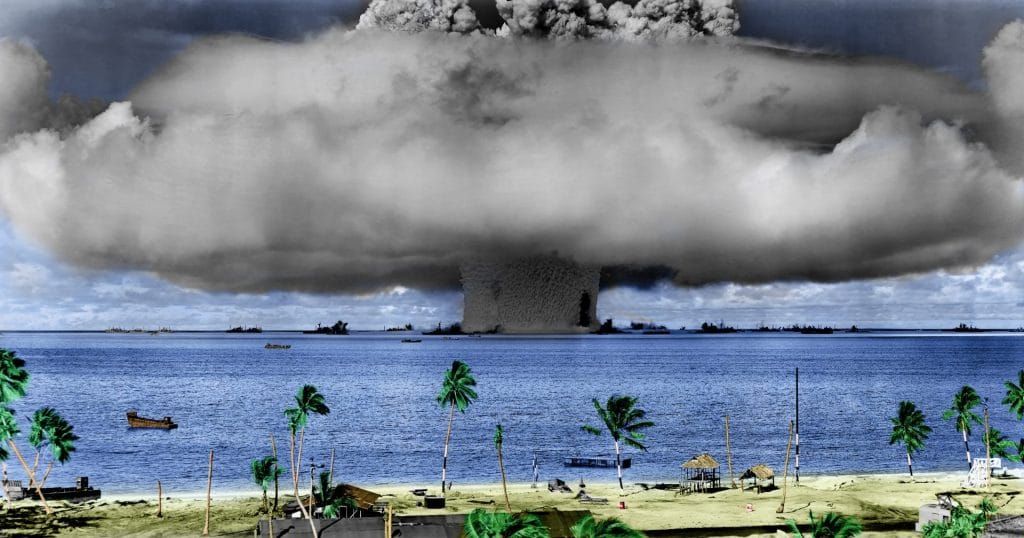
Pacific Nuclear Testing
A history of nuclear testing in the Pacific and the successful campaign to stop it
Michael Szabo – 7 July 2025
Despite a name suggesting peace and tranquillity, about 325 nuclear weapons were detonated in the Pacific region by the governments of the USA, Britain and France between 1946 and 1996. The total cumulative explosive yield was about 173.8 megatons (MT), which is the equivalent to about 11,600 Hiroshima bombs.
As a result of the massive amount of radioactivity released by the atmospheric tests spreading across the globe, it has been estimated that there were about 430,000 additional cancer deaths globally due to cumulative radiation doses by the year 2000.
In the long term, it has been estimated that at least 2 million additional cancer deaths are expected globally due to the longevity of many radioactive isotopes (See: “The Devastating Consequences of Nuclear Testing – Effects of Nuclear Weapons Testing on Health and the Environment”, 2023, Dr Arjun Makhijani & Dr Tilman Ruff, International Campaign to Abolish Nuclear Weapons and International Physicians for the Prevention of Nuclear War Germany).

The US Atomic Energy Commission described Rongelap Atoll in the Marshall Islands as, “by far the most radioactively contaminated place on earth.”
Radioactive fallout occurred all over the Marshall Islands as a result of the 67 US nuclear weapon tests carried out there, as shown in the fallout map from the 1954 Castle test series and measurements taken at the time by the US authorities.
Radioactive fallout from the tests contaminated drinking water, land, locally grown foods such as coconuts and other crops, and marine fish. This meant that many local people became sick and died from cancer and other radiation-related illnesses, including some from acute radiation sickness.
Other sources describe infertility, miscarriages, the births of babies with often severe congenital physical malformations, and mental retardation. The tests also resulted in psychological traumatisation and physical displacement of local Indigenous communities.
The Makhijani and Ruff report also points out that women and girls have been most affected by radioactivity released by the tests due to the female body having a higher sensitivity to radiation.
There is also a history of elevated levels of radioactivity from nuclear fallout and radioactive contamination at the other test sites in Australia and Kiribati, and of ‘clean up’ operations and the dumping of irradiated equipment on land, in lagoons and at sea.
France ceased publishing public health statistics for French Polynesia in 1963 shortly before it started to test nuclear weapons there in 1966. However, data from the UN International Agency for Research on Cancer for 1998–2002 revealed that women in French Polynesia suffered the highest rates of thyroid cancer and myeloid leukaemia in the world, both types of cancer strongly associated with radiation exposure.
According to a June 2025 report by a cross-party committee of the French National Assembly, tens of thousands of people in French Polynesia are estimated to have been exposed to harmful levels of radiation from the tests, which led to a significant public health crisis which has been largely ignored by French authorities (See: French parliament: Government should apologize for nuclear tests in Polynesia, NHK World, 19 June 2025).
As a result of nuclear fallout and radioactive contamination, the health of people living and working in Australia and Kiribati at or near the British and US test sites there in the 1950s was also impacted, including deaths, cancers, miscarriages, birth defects and genetic mutations.
Fallout and contamination also impacted people in countries beyond the test sites, and people working on fishing vessels at sea.
The failure to collect, store and publish full public health statistics throughout the period of the Pacific tests for all locations means the full impacts such as deaths and ongoing health problems were not fully documented by the testing nations.

Overview of nuclear testing in the Pacific 1946-1996
Of the 325 nuclear tests carried out in the Pacific, about 175 were detonated above ground in the atmosphere and about 150 in “underground” shafts drilled down into coral atolls, including directly beneath lagoons. The test sites were in the Marshall Islands (US), Australia (UK), Johnston (Kalama) Atoll (US), Kiribati (US & UK), Amchitka (US), and French Polynesia Tahiti Nui (France). The precise number of tests is unclear because a small number of the tests listed as ‘failed to detonate’ may have resulted in partial detonations of unknown but significant explosive yields.
The Makhijani and Ruff report (2023) includes many of the main statistical metrics of nuclear testing in the Pacific. Co-author Arjun Makhijani is president of the Institute for Energy and Environmental Research (IEER) in Maryland. He received his PhD in 1972 from the Department of Electrical and Computer Engineering at the University of California, Berkeley, specializing in nuclear fusion.
He has published numerous studies and articles on nuclear fuel cycle issues, including nuclear weapons production and testing, and nuclear waste. His focus has mostly been on nuclear and renewable energy, and on the health and environmental impacts of nuclear weapons production and testing.
Co-author Tilman Ruff is a physician, immediate past co-president and board member of International Physicians for the Prevention of Nuclear War (Nobel Peace Prize 1985), and an Officer of the Order of Australia (AO). He is also a co-founder, founding chair and Australian board member of the International Campaign to Abolish Nuclear Weapons (Nobel Peace Prize 2017) and Honorary Principal Fellow in the School of Population and Global Health at the University of Melbourne.
According to sources cited in the Makhijani & Ruff report, radioactive fallout from the tests carried in dust and rain contaminated drinking water, land, locally grown foods such as coconuts and other crops, and marine fish.
Their report also describes how the radioactive fallout from the atmospheric tests and the subsequent ingestion of contaminated water and foods meant that many local people became sick and died from cancer and other radiation-related illnesses, including some from acute radiation sickness.
Other sources describe infertility, miscarriages, the births of babies with often severe congenital physical malformations, and mental retardation. The tests also resulted in psychological traumatisation and physical displacement of local Indigenous communities.
The French government’s underground nuclear tests carried out at Moruroa and Fangataufa atolls also deposited very large amounts of radioactivity underground, including some radioactive isotopes which take thousands or millions of years to decay.
They also damaged the stability of the surrounding rock and nearby corals, including fracturing and fissures, allowing radioactivity to escape, and increasing the likelihood of its release into local groundwater, lagoons, the surrounding sea, and the atmosphere (via venting).
The indigenous Mā’ohi spelling is Moruroa rather than the misspelling Mururoa used by French cartographers in the 1960s. The original Mangarevan meaning of Moruroa is “place of the great secret”.
Nuclear warheads detonated at coral atolls in the Marshall Islands, Kiribati and Tahiti Nui (French Polynesia) also killed marine life in them, including dolphins, dugongs, turtles, seabirds, land birds, fishes, shellfish and corals, and contaminated the land and local food crops, including coconuts, and marine food chains. We know this from descriptions of dead marine life in and around lagoons after the tests and the existence and persistence of radioactive contamination in the soil, crops such as coconuts, and in marine food chains measured decades later.
The Makhijani and Ruff report also warns that rising sea levels resulting from climate change and an increase in the intensity and frequency of extreme weather events such as tropical cyclones will only add to the problem.
It cites the example of the huge concrete Runit Dome in the Marshall Islands, where tens of thousands of cubic metres of radioactive waste was dumped into a crater gouged out by a US nuclear weapons test and then covered with a concrete dome. That concrete structure is not sealed off from the ground underneath it, so it is in direct contact with the rising ocean and erosion.

2 million additional cancer deaths worldwide
According to the introduction to Makhijani and Ruff’s report, written by Angelika Claußen, Inga Blum and Juliane Hauschulz: “The radioactivity released by above-ground nuclear tests has spread through the atmosphere across the globe, resulting in about 430,000 additional cancer deaths due to cumulative radiation doses by the year 2000 alone. In the long term, at least 2 million additional cancer deaths can be expected due to the longevity of many radioactive isotopes.”
Their introduction also identifies another important aspect of the history of nuclear weapons testing as the associated racism evident in the selection of the test sites far from the metropolitan capitals of the nuclear testing states and in many cases, the different radiation protection standards applied to residents of the affected areas and others, such as members of the military, technicians and scientists involved in carrying out the tests.
The report quotes from a 1957 British report on a nuclear weapons test at the Gilbert and Ellice Islands Colony (now the Republic of Kiribati) which stated: “The radiation dosage … is about 15 times higher than that which would be permitted by the International Commission on Radiological Protection … but only a very slight health hazard would arise, and that only to primitive people.”
Residents of the US nuclear weapons test sites in the Marshall Islands were also included in unethical medical studies without their consent in order to study the effects of radioactive contamination on the human body. When the residents of Rongelap Atoll were taken back to their island, a representative of the US Atomic Energy Commission said: “This island is by far the most radioactively contaminated place on earth, and it will be very interesting to see what the uptake of radioactivity is when people live in this environment.”
The report also notes that samples were taken from the blood, bone marrow and internal organs of the people of Rongelap, and some were compelled to undergo experimental surgery or received injections with radioactive substances. In Australia, the bones of deceased people – especially children – were taken from hospitals for years to be examined in the US without the knowledge and consent of affected families. There were also harrowing reports of families denied access to their dead children.
A summary with photos and film footage about US nuclear testing in the Marshall Islands can be viewed online.
In these and other ways, the Pacific was at the centre of the superpower confrontation of the Cold War period. For example, the US bombers that dropped the first nuclear weapons on the cities of Hiroshima and Nagasaki in Japan in August 1945 departed from Tinian in the Northern Mariana Islands.
These horrific weapons of mass destruction were developed and refined by the five declared nuclear weapons states (USA, USSR, Britain, France, China) in the full knowledge that they had the power to destroy entire cities and indiscriminately kill civilians living in and around them.
Although the Cold War supposedly ended in 1990, its radioactive legacy remains and is a constant threat to human health, the environment, and future generations.
During the Cold War, the US government carried out more nuclear weapons tests than any other country (1,054). It detonated a total of 67 nuclear warheads in the atmosphere at the Marshall Islands in Micronesia between 1946 and 1958, mainly at Bikini and Enewetak atolls.
The US nuclear weapon used to bomb the city of Hiroshima in Japan on 6th August 1945 had an explosive yield of about 15 kilotons (KT). It killed between 90,000 and 166,000 people out of a population at the time of 350,000, 90% of which were civilians. About half of the people killed died in the first hour. The rest died from the effects of radiation burns, radiation sickness, and other injuries caused by the bombing over the next four months (See: Hiroshima, John Hersey, Knopf, 1946; Atomic Bombings of Hiroshima and Nagasaki, Wikipedia, 1 July 2025).
The bomb detonated about 600m above the ground at 8:15am and the resulting fireball had a core temperature of several millions degrees. In the area directly below the blast people were vaporised. Further out, people’s bodies including their bones were turned to ash. The blast was followed by a ‘black rain’ of radioactive ash or ‘fallout’ and the city continued to burn through the following night.
For comparison, the second ‘Operation Crossroads’ Baker nuclear test explosion detonated by the US military in the lagoon at Bikini Atoll on 24 July 1946 was 23 KT. Footage of that explosion can be viewed online.

11,600 Hiroshima bombs detonated in the Pacific
The 67 US nuclear warhead tests in the Marshall Islands had a total combined explosive yield of about 108.5 megatons (MT), one megaton being about one thousand times more powerful than one kiloton. So, 108.5 MT is the equivalent of about 7,250 Hiroshima bombs.
The US also detonated 15 nuclear warheads at high altitude above Johnston (Kalama) Atoll, about 700 nautical miles south-west of Honolulu in Hawai’i, between 1958 and 1962, an atoll under the jurisdiction of the US Air Force. The 15 tests carried out there had a total combined yield of about 14.2 MT, which is the equivalent of about 950 Hiroshima bombs. Five of those tests were listed as “unknown yield”.
The US detonated a further 24 nuclear warheads in the atmosphere in the Christmas Islands (Kiritimati and Malden) area in 1958 (now part of the Republic of Kiribati) with a total combined yield of about 24 MT, which is the equivalent of about 1,600 Hiroshima bombs.
There were also 3 underground US nuclear warhead test detonations at Amchitka Island in the Aleutian Islands of Alaska in the north-west Pacific between 1965 and 1971 with a total combined yield of about 6 MT, which is the equivalent of about 400 Hiroshima bombs.
The British government detonated 12 nuclear weapons in the atmosphere in Australia between 1952 and 1957 at the Monte Bello Islands in Western Australia, Emu Field in South Australia, and Maralinga in South Australia. The total combined yield was about 180 KT, which is the equivalent of about 12 Hiroshima bombs.
After Australia refused to allow Britain to test its first hydrogen bomb there, Britain carried out another 9 atmospheric nuclear warhead tests at Kiritimati Island in 1958 (known as Christmas Island at that time, now part of the Republic of Kiribati). They had a total combined yield of about 7.8 MT, which is the equivalent of about 520 Hiroshima bombs.
Britain had requested permission to move its atmospheric nuclear testing to the Rangitāhua Kermadec Islands in Aotearoa in 1955 but the New Zealand government of the day refused permission, fearing doing so would trigger strong public opposition.

On 3 July 1970, France carried out its largest nuclear test up to that time on Fangataufa Atoll with an explosive yield of 914 KT, equivalent to about 60 Hiroshima bombs.
The French government detonated 193 nuclear weapons (46 in the atmosphere, 147 in shafts drilled into coral atolls) in Tahiti Nui (French Polynesia) at Moruroa and Fangataufa atolls between 1966 and 1996.
The total combined yield of all the atmospheric French nuclear tests there between 1966 and 1974 was about 10.1 megatons, which is the equivalent of about 800 Hiroshima bombs. The total combined yield of the ‘underground’ tests there from 1975 to 1996 was about 2.8 MT, which is the equivalent of about 200 Hiroshima bombs. In total, that is the equivalent of about 1000 Hiroshima bombs.
The combined total yield for all atmospheric nuclear tests in the Pacific was about 165 MT, which is the equivalent of about 11,000 Hiroshima bombs. The combined total yield for all the underground nuclear tests in the Pacific was about 8.8 MT, which is the equivalent of about 600 Hiroshima bombs.
So, the total cumulative yield for all atmospheric and underground nuclear tests in the Pacific was about 173.8 MT, which is the equivalent to about 11,600 Hiroshima bombs.
These so-called ‘tests’ had devastating impacts on Indigenous Marshallese, Australian Aboriginal, Ni-Kiribati, Mā’ohi and Unangax̂ Aleut communities. They also wrecked local ecosystems and left a deadly legacy of radioactive contamination and health problems that persist today.
For example, radioactive plutonium-239 is released into the environment during nuclear weapons tests. It is highly radioactive and toxic, and has a half-life of 24,100 years, which means it takes that long for half of a sample amount to decay.
The two main superpowers of that period were the USA and the Soviet Union (successor state, Russia). Along with their respective allies, Britain and France, and China, they vied for nuclear superiority. They also sought to develop bigger and deadlier nuclear weapons systems, refining and modernising them until there were about 50,000 nuclear weapons by 1990. Most of those nuclear weapons were in the US and Soviet nuclear arsenals as Britain, France and China each had smaller nuclear arsenals. Between them, they had enough to destroy life on Earth many times over.
The military on each opposing side also had access to massive budgets and had very large numbers of scientists and engineers on their payrolls. For example, about 600,000 people worked on the Manhattan Project at various points during its operation including scientists, engineers, construction workers, and support staff, and it cost the equivalent of about US$30 billion in 2023 dollar value.
They built and operated nuclear reactors, nuclear laboratories and various other sites associated with mining and refining uranium and the nuclear fuel cycle, plus the main location at Los Alamos. Shortly after World War Two, the Soviet Union copied the Manhattan Project.
The focus was on improving their nuclear weapons and pre-empting or countering the other side’s innovations. Imagine for a moment if instead all that money and expertise had been invested over those five decades in improving public health and education, alleviating poverty, hunger and inequality, and developing sustainable solutions to humanity’s energy needs and environmental problems.
Although there was a powerful ideological dimension to the Cold War, the great extent of power and financial resources which those who controlled the military-nuclear complexes of the nuclear testing nations wielded made it extremely difficult for citizens in civil society to stop nuclear testing. The following section describes how it was stopped.

The successful campaign to stop nuclear testing in the Pacific
Nuclear weapons testing in the Pacific did not go unchallenged at the time it was happening. The campaign to stop the tests quickly spread to become a global movement, bringing together Pacific peoples, peace activists, ecologists, church groups, women’s groups, scientists and political leaders around the world in a struggle against nuclear colonialism and environmental destruction.

Scientists warn about the dangers of nuclear war and testing
As the US government prepared to conduct its first nuclear weapons tests in the Marshall Islands in 1946, there was reportedly diplomatic pressure to cancel the tests and some Manhattan Project scientists argued that further testing was unnecessary and environmentally dangerous.
J. Robert Oppenheimer, the US physicist who oversaw the development of the first nuclear weapons, rejected an invitation from US President Truman to witness the 1946 tests. In his reply he set out his objections and said that any data from the tests could have been obtained more accurately and cheaply in a laboratory.
At a 22 March 1946 cabinet meeting, US Secretary of State James F. Byrnes reportedly said, “from the standpoint of international relations it would be very helpful if the test could be postponed or never held at all.” President Truman delayed the 1946 test series but eventually it went ahead on 30 June followed by another test on 21 July. A planned third test on 1 March 1947 was cancelled due to the devastating impacts of the first two.
Nobel Peace Prize Laureate Joseph Rotblat was the only nuclear scientist to actually withdraw from working on the Manhattan Project in the US during World War Two due to his conscientious objections to nuclear weapons. He left the project after it became clear in 1944 that Nazi Germany had ceased its development of a nuclear weapon. The Manhattan Project had been established in 1942 to beat Nazi Germany to building the first nuclear weapon.
After he heard news of the US nuclear bombings of Hiroshima and Nagasaki in August 1945, fearing an impending nuclear arms race between the USA and the Soviet Union, he said that he “became worried about the whole future of mankind”.
During the 1940s and 1950s, Nobel Prize Laureate Bertrand Russell joined Joseph Rotblat in advocating for nuclear disarmament. Another Nobel Prize Laureate, Albert Einstein, dedicated the last decade of his life (1945-55) to the cause of nuclear disarmament, also highlighting the dangers of nuclear weapons. During the 1950s the three of them began a collaboration with other physicists to draft what became known as the Russell–Einstein Manifesto.
Albert Einstein signed it shortly before he died in April 1955 and it was launched publicly in July 1955 in London. The manifesto highlighted the dangers posed by nuclear weapons and their testing, and called for a conference of scientists to assess the dangers of nuclear weapons.
One of the 11 signatories was Herman Muller, an American scientist who was awarded the 1946 Nobel Prize for Medicine for the discovery that X-rays can cause mutations, and who warned of the long-term dangers of radioactive fallout from nuclear testing.
Shortly after the launch of the manifesto, the first conference was organised by Joseph Rotblat and Bertrand Russell in July 1957 in Pugwash, Canada, which became known as the Pugwash Conference. Joseph Rotblat served as secretary-general of the annual Pugwash Conference, which brought together nuclear physicists from around the world and across the East-West divide, and went on to play an essential part in the successful negotiations on the Partial Test Ban Treaty and other arms control agreements. Joseph Rotblat and the Pugwash organisation were later jointly awarded the Nobel Prize for Peace in 1995.
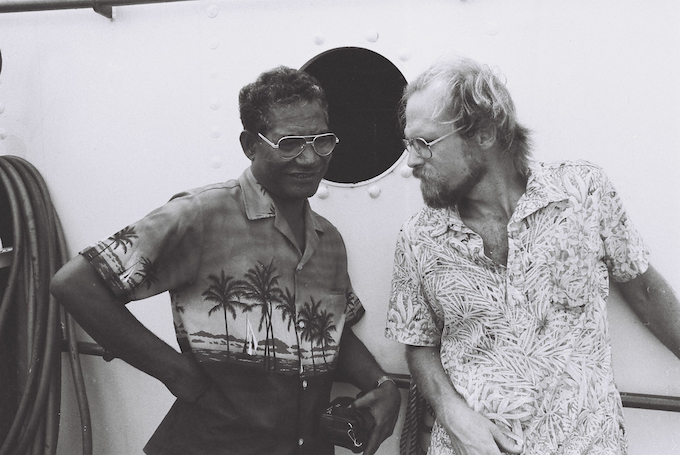
Early opposition and protests against US testing in the Pacific
The people of the Marshall Islands actively opposed US nuclear testing during the 1940s and 50s. Marshallese leaders repeatedly petitioned the UN and the US to end the nuclear tests and to relocate communities. The government of the Marshall Islands strongly opposed US nuclear testing, and continues to seek justice and reparations for the long-term health and environmental impacts of the tests since they ended there in 1958.
The Nitijela, the parliament of the Marshall Islands, repeatedly condemned US nuclear testing, and advocated for nuclear disarmament and justice for the lasting harms caused by the tests there. The statements made by the Nitijela repeatedly highlighted the health impacts, environmental contamination, and cultural disruption caused by the tests, and urged the US government to acknowledge the impacts and compensate for them.
According to the Atomic Heritage Foundation, former Marshall Islands Foreign Minister Tony deBrum, who witnessed the Castle Bravo test as a 9-year-old child, argued that the tests caused health and infrastructure problems and that the lives of the Marshallese victims were sacrificed in the pursuit of developing US nuclear weapons.
The people of the Marshall Islands were never consulted or informed about the US tests and they never gave their permission for the tests to be conducted there.
Jeton Anjain (1933-1993), a senator in the Nitijela representing Rongelap who was also a Minister of Health, described the effects of the huge Castle Bravo test as follows: “Five hours after detonation, it began to rain radioactive fallout at Rongelap. The atoll was covered with a fine, white, powder-like substance. No one knew it was radioactive fallout. The children played in the ‘snow.’ They ate it.”
Later, in 1985, it was Jeton Anjain who asked Greenpeace to help organise Operation Exodus in which the Rainbow Warrior evacuated the people of Rongelap and their possessions to Mejatto.
Then in 1991, he and the people of Rongelap were awarded the Right Livelihood Award for, “their steadfast struggle against United States nuclear policy in support of their right to live on an unpolluted Rongelap island.” Jeton Anjain died of cancer in 1993.
Darlene Keju (1951-1996) was from a younger generation of Marshallese activists. She grew up at Wotje Atoll. Later, she lived in Ebeye and then Honolulu in Hawai’i. During her life she travelled around the Marshall Islands, Hawai’i and North America speaking out about the nuclear tests, and using music, dance and song to express outrage about her people’s forced evacuations and resettlements, the false promises made to them by the US authorities, and the ongoing health problems they suffered from caused by radiation exposure.
When she visited some of the more remote Marshall Islands atolls, she met women who had suffered miscarriages and had babies with birth defects, so-called “jellyfish babies” – babies born without bones due to radiation exposure.
As one of the first prominent anti-nuclear activists in the Marshall Islands, her work gained international attention, and she supported other nuclear survivors from Hiroshima and Nagasaki in Japan. She also delivered powerful speeches, including at the 1983 World Council of Churches gathering in Vancouver, Canada.
Darlene Keju died in 1996 from breast cancer, but her legacy lives on. Her husband, Giff Johnson (son of US anti-nuclear activist and Greenpeace Aotearoa co-founder Bette Johnson), wrote a 2014 book about Darlene entitled “Don’t Ever Whisper: Darlene Keju, Pacific Health Pioneer, Champion for Nuclear Survivors” to ensure the tragic injustice suffered by the people of the Marshall Islands will never be forgotten. More information is available online about the inspiring, world-changing work of Marshallese women activists.
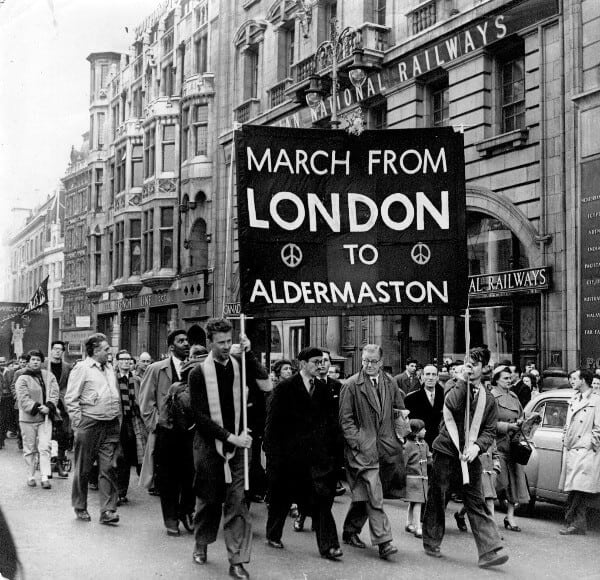
Anti-nuclear movements in Japan, Britain, USA, New Zealand, Australia and Canada
On 1 March 1954, a Japanese tuna fishing boat, Daigo Fukuryū Maru (Lucky Dragon No. 5), was operating 180km east of Bikini Atoll, about 30km outside the US military exclusion zone, at the time of the 15 MT Castle Bravo nuclear test. Several hours after the blast, radioactive fallout ‘dust’ comprising irradiated particles of coral and sand from Bikini fell from above, settling on the boat. After retrieving their fishing gear the boat headed away and some of the crew collected up the ‘dust’ with their hands and filled bags with it to clean the deck. They suffered high radiation exposures and acute radiation illnesses after they breathed in particles of the fallout or came into contact with it through touching it.
After arriving back in Japan, eight of the 22 crew members were hospitalised with radiation sickness. On 23 September 1954, Kuboyama Aikichi, the chief radio operator, died. Other crew members were eventually discharged from hospital but subsequently had a history of cancer or other serious diseases.
It was estimated that about one hundred fishing boats were contaminated to some degree by fallout from the Castle Bravo test. Despite denials by Lewis Strauss, head of the US Atomic Energy Commission, about the extent of the claimed contamination of the tuna caught by Daigo Fukuryu Maru (Lucky Dragon No. 5) and the other fishing boats, US authorities subsequently imposed rigid restrictions on tuna imports.
After the Daigo Fukuryū Maru (Lucky Dragon No. 5) tragedy and fears of radioactive contaminated fish, the Japanese newspaper Yomiuri Shimbun published reports about the damage that radiation can cause, which helped instill a fear of radiation among the Japanese public. The fishermen involved and a group of housewives started a petition against the hydrogen bomb tests. They first gathered together through a reading circle in the Suginami district of Tokyo, mainly concerned about being exposed to irradiated fish.
The ‘Suginami Appeal’ galvanised people in other cities and led to the organisation of a new anti-nuclear movement in Japan. In 1955 a ‘World Conference against Atomic and Hydrogen Bombs’ was held in Hiroshima followed by the establishment of a committee to organise nationwide cooperation against nuclear weapons called Gensuibaku Kinshi Nihon Kyōgikai (Japan Council against Atomic and Hydrogen Bombs), or Gensuikyō.
(See: Japanese Anti-nuclear Movements – Local and Transnational Characteristics of Peace Protest in Hiroshima, Makiko Takemoto).
Also after the Castle Bravo test, Indian Prime Minister Jawaharlal Nehru called for a moratorium on nuclear testing and British Labour Party leader Clement Atlee called for a ban on hydrogen bomb tests. A Soviet proposal which closely resembled an Anglo-French proposal for a test ban was rejected by the US in 1955 during the presidency of Republican Dwight D. Eisenhower. By 1957, polls showed 63% of Americans supported a test ban and a petition supporting a test ban launched by Nobel Prize Laureate Albert Schweizer was signed by more than 9,000 scientists from 43 countries, including Albert Einstein.
Following the publication of the Russell-Einstein Manifesto in 1955, Bertrand Russell, Joseph Rotblat, Peggy Duff and others founded the Campaign for Nuclear Disarmament (CND) in London in November 1957.
The CND was publicly supported by a ‘Who’s Who’ list of leading British writers, artists, scientists, peace activists and church leaders of the period, including E.M Forster, Benjamin Britten, A. J. P. Taylor, J.B. Priestley, Jacquetta Hawkes, Doris Lessing, Kingsley Martin, Henry Moore, Barbara Hepworth, Herbert Read, Flora Robson, Peggy Ashcroft, Michael Tippett, E.P. Thompson, Fenner Brockway, Eric Baker, Compton Mackenzie, Canon John Collins, Rev. Trevor Huddleston, the Bishop of Llandaff Dr Glyn Simon, the Bishop of Birmingham Dr J.L. Wilson, Bruce Kent, Julian Huxley and Conrad Waddington. Several British Labour party figures were also early supporters, including Michael Foot, Anthony Greenwood, Gerald Gardiner and Frank Allaun.
According to Nic Maclellan (See: Grappling with the Bomb: Britain’s Pacific H-bomb tests, Nic Maclellan, ANU Press, 2017), Japanese peace activist Takeko Kawai of the ‘Peace Protection Association of Toyohashi Citizens’, who was the wife of the president of Aichi University (Kiyoshi Kawai), organised some protests against US and Soviet atmospheric hydrogen bomb testing.
She also sent a letter to peace activists in the US, France and Britain, in which she asked for international support for direct action opposing the upcoming British hydrogen bomb test series at Christmas Island (now in the Republic of Kiribati).
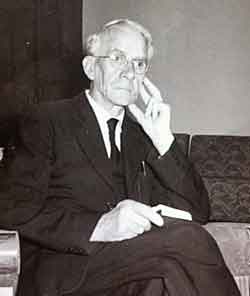
In March 1957, reportedly inspired by her letter, veteran British peace activist Harold Steele announced that he would travel to Tokyo with the aim of joining a protest fleet to sail to Christmas Island (Republic of Kiribati) in the central Pacific to stop the planned British hydrogen bomb tests there.
In London, the Emergency Committee for Direct Action Against Nuclear War was formed in April 1957 to raise funds to support the planned direct action, with sponsors including Bertrand Russell, playwright Laurence Houseman and Irish writer and actor Spike Milligan.
(See: Putting your life on the line: Harold Steele, A forgotten story of global solidarity, the birth of the Direct Action Committee and the inspiration for the first environmental direct action boat, the Golden Rule, Peace News, 1 August 2023; Archive of the Direct Action Committee Against Nuclear War, Special Collections, J.B. Priestley Library, University of Bradford, Ref code GB 0532 CWL DAC, 1957-61).
After repeated delays in receiving a visa to travel to Japan, Steele arrived in Tokyo via India on 16 May 1957. En route he stopped in India where he met Indian Prime Minister Jawaharlal Nehru who he said “wished him well” on his mission.
On 22 May, Harold Steele was present at the Executive Council of a Japan Council Against Atomic and Hydrogen Bombs meeting which debated the pros and cons of sending a protest fleet into the Christmas Island test site ‘danger zone’.
A proposed meeting with Japan’s Deputy Prime Minister Mitsujiro Ishii was also repeatedly delayed and so organising a vessel for the proposed protest fleet proved to be much harder than expected (Maclellan, 2017).

Without the capacity to mobilise a protest flotilla, the Council focussed on organising protests against the tests within Japan. Regular reports from the Reuters Tokyo office were published around the world. News media in the Pacific Islands also covered the anti-nuclear protests in Japan, including a front-page report in the Fiji Times of a 15,000-strong rally in Tokyo (Maclellan, 2017).
The British Embassy in Tokyo sent daily reports to London on the unsuccessful efforts by Japanese peace activists to organise protest boats to travel to the test site.
In Kochi, about 100km south of Hiroshima, activists reportedly continued
to mobilise for the protest. The Kochi Prefectural Committee for the Prevention of Nuclear Tests on Christmas Island had planned to send a steamer with 27 crew and eight demonstrators on board to the area near the danger zone for 100 days, as a symbolic protest and to collect samples of radioactive fallout. Soon after the first (300 KT) test in the Grapple series was carried out on Malden Island on 15 May 1957, the British Embassy reported that the Japan Council was supporting the Kochi Prefectural Committee with a ¥3.5 million contribution towards the ¥8.5 million cost of chartering and outfitting fishing boats to travel to the test zone (Maclellan, 2017).
However, on 19 May, four days after the first test, the British Embassy reported that the Kochi committee had ‘announced cancellation of its plan to send vessel to the testing grounds in view of danger of contamination from [the] first test’.
Unable to find a way to reach the testing zone around Christmas Island, Harold Steele travelled back to Britain in August 1957. His supporters formed the DAC and proposed instead the organisation of a march to protest at the British nuclear weapons factory at Aldermaston where the warheads to be detonated in the tests were assembled (See: Emergency Committee for Direct Action Against Nuclear War/Direct Action Committee Against Nuclear War, 1956-1961, Reference number CND/2008/2, London School of Economics Archive).
The DAC consisted of Allen Skinner, Hugh Brock, Arlo Tatum, Michael Randle, April Carter, Pat Arrowsmith, Walter Wolfgang, Frank Allaun and Rev. Michael Scott. Sponsors and public supporters of the DAC included Bertrand Russell, Doris Lessing, Linus Pauling, Spike Milligan, George Melly, John Osborne, Bayard Rustin, John Berger and Alex Comfort.
Dr Sheila Jones also played an important role in opposing nuclear testing and the founding of the CND. From 1955 she was secretary of the Joint Local Committee for the Abolition of Nuclear Bomb Tests in Hampstead, London. The Committee distributed leaflets, held public meetings, sponsored film shows and organised a letter-writing campaign. In 1957 she joined Ianthe Carswell in founding the National Council for the Abolition of Nuclear Weapons Tests and then in 1958 they agreed to transfer all of its resources (funds, office, staff) to the newly founded CND.
The CND worked with the DAC to organise the first protest march from London 100km to the British nuclear warhead factory at Aldermaston during Easter 1958. Afterwards, the DAC changed its name to the ‘Committee of 100’ and became the direct action wing of the CND, which subsequently grew into a mass movement. CND affiliated groups were soon established in other countries, including New Zealand (1957-59).
Early Aldermaston marchers included Canadian journalist Bob Hunter and Kiwi photographer Gil Hanly. Bob Hunter went on to be a co-founder of Greenpeace in Canada in 1971 and for decades Gil Hanly has documented anti-nuclear flotillas and peace movement activities in Aotearoa, including photographing the Rainbow Warrior the morning after it was bombed.
In 1959, responding to increasing public concern after the British hydrogen bomb tests in the Pacific, the New Zealand government voted at the UN to condemn nuclear testing while the US, Britain and France voted against, and Australia abstained.
In Canada, two anti-nuclear testing groups also emerged, the Combined Universities Campaign for Nuclear Disarmament (CUCND) in 1959 and the Voice of Women (VOW) in 1960.
According to Patricia I. McMahon (1999), the CUCND was established in November 1959 by a group of students from the three Montreal area universities and took their inspiration from the British CND and Aldermaston march of Easter 1958. Their first action was to organise an anti-nuclear petition that they delivered to Canada’s prime minister on Christmas Day 1959.
Then in May 1960, Brenda Dempsey announced the creation of a new women’s
organisation focused on disarmament and international peace (McMahon, 1999). She received hundreds of letters of support, as did Josephine Davis, after she appeared on a segment of the Canadian Broadcasting Corporation’s “Frontpage Challenge” programme. The two had met at the Unitarian Universalist Congregation of South Peel. A third woman, Helen Tucker, helped organise a rally sponsored by the Toronto Campaign for Disarmament at Massey Hall, and reportedly persuaded Davis to participate. Dempsey reportedly helped to raise awareness of the threat posed by nuclear weapons and testing through her newspaper column.
(See: The Politics of Canada’s Nuclear Policy, 1957-1963, Patricia 1. McMahon,
PhD Thesis, 1999, University of Toronto).
In 1961, the New Zealand CND urged the NZ government to declare it would not acquire or use nuclear weapons and withdraw from nuclear alliances such as ANZUS. In 1963, the Auckland CND campaign submitted its ‘No Bombs South of the Line’ petition to the NZ parliament with 80,238 signatures calling on the government to sponsor an international conference on establishing a nuclear free zone in the southern hemisphere.
After it emerged that France was looking to move its nuclear testing programme to French Polynesia, New Zealand CND members including Mabel Heatherington, Alison Duff and Pat Denby delivered protests to the French Embassy in Wellington and visiting French warships during 1963-64.
In 1964, small peace marches which featured “Ban the Bomb” placards were organised in several Australian state capital cities.
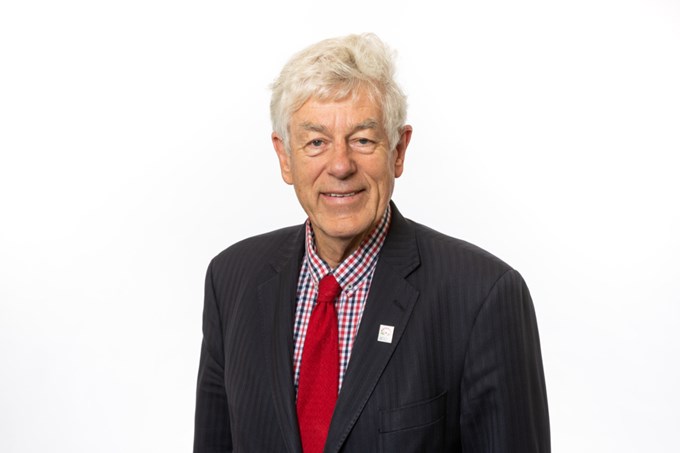
According to New Zealand CND member Richard Northey (who was later elected as a Labour MP in Mt Eden and became New Zealand’s first Disarmament Minister in the 1980s) there was an attempted protest yacht voyage from Australia to Tahiti in 1965 which he helped to support but due to the crew’s inexperience, they were unable to make it further than Rarotonga.
Later, in 1972, Richard Northey and other New Zealand CND members worked with other groups such as Peace Media (newly founded by Barry and Jacqui Mitcalfe) and many individuals including Maurice Shadbolt and Willem and Ann van Leeuwen to help organise and support the first Greenpeace protest voyage of the Vega (renamed Greenpeace III) from Aotearoa to the French nuclear test site at Moruroa Atoll.

The Golden Rule and the Phoenix of Hiroshima
Despite his failure to get to the Christmas Island test site, Harold Steele’s efforts received international media coverage, helping to inspire others to campaign against the hydrogen bomb and nuclear weapons testing.
According to Non-Violent Action Against Nuclear Weapons (NVAANW) founder Lawrence Scott, protest actions carried out at the US Nevada nuclear weapons test site in 1957 and a subsequent 1958 protest voyage to the Marshall Islands by a yacht named The Golden Rule were inspired by news of Harold Steele’s plan to join the protest flotilla from Japan to Christmas Island in 1957 and the planned Aldermaston Easter march (See: Putting your life on the line: Harold Steele, Peace News,
1 August 2023).
Later in 1957, NVAANW changed its name to the Committee for Non-Violent Action (CNVA). On 6 August 1957, the 12th anniversary of the US bombing of Hiroshima, Albert Bigelow and 12 other members of the CNVA were arrested when they tried to enter the Camp Mercury nuclear test site in Nevada, USA. The following day, they returned and sat with their backs to the site as the nuclear test took place.
After that, they planned a peaceful protest voyage to the Marshall Islands that aimed to disrupt the US tests there, gain international attention and inspire others to protest.
On 31 December 1957, Albert Bigelow tried to present a 17,000 signature petition against nuclear testing to US President Eisenhower, which had been collected by the CNVA and the American Friends Service Committee, a Quaker-founded US peace and social justice non-governmental organisation.
Albert Bigelow and the CNVA then sent a letter to President Eisenhower on 8 January 1958, asking him to stop the scheduled tests in the Marshall Islands. The letter said if the president stopped the plans for the nuclear tests, CNVA would not attempt to sail its yacht into the nuclear test zone, but they received no reply.
Harvard educated architect Albert Bigelow was also a World War Two veteran, having commanded a US warship in the Solomon Islands. He became a pacifist after hearing news that the US had attacked Hiroshima with a nuclear bomb. The CNVA chose him to be the skipper and after recruiting crew members George Willoughby, William R. Huntington, Orion Sherwood, and James Peck, bought a small yacht with two masts which they named The Golden Rule.
The five of them planned to sail into the nuclear test site at the Marshall Islands to peacefully protest against the testing. CNVA publicised the protest voyage in advance in order to attract more public support and the yacht set sail in early March 1958 from California to Hawai’i.
On 11 April 1958, in anticipation of the protest, the US Atomic Energy Commission issued a ban against sailing into the test area. The ban was put into effect when The Golden Rule was en route to Honolulu. On 1 May 1958, The Golden Rule set sail from Honolulu towards the Marshall Islands despite the court injunction. The US Coast Guard arrested Bigelow and his crew just five nautical miles from Honolulu and brought them back to port (See: The Golden Rule and Phoenix voyages in protest of U.S. nuclear testing in the Marshall Islands, 1958, Global Nonviolent Database).
The Golden Rule crew attempted to depart a second time on 4 June to the ‘Eniwetok Proving Grounds’ in the Marshall Islands, but they were arrested again and the court sentenced Bigelow and the crew to 60 days in jail.

The interrupted voyages and public statements of the crew inspired Earle and Barbara Reynolds, US citizens in Honolulu at the time of the court proceedings. Earle Reynolds was an anthropologist who studied the effects of the Hiroshima bombing on Japanese society. Speaking with Bigelow inspired him and Barbara to take a second yacht, the Phoenix of Hiroshima, and to continue on The Golden Rule’s route. In early July, the Phoenix of Hiroshima sailed successfully to the testing area at the ‘Proving Grounds’, but the US Coast Guard arrested them there. A court sentenced Earle and Barbara Reynolds to nine weeks in jail.
Although The Golden Rule and the Phoenix of Hiroshima protests did not stop US nuclear testing, the publicity they generated gained their cause international support. In London, Montreal, and various US cities, groups of sympathizers formed picket lines in support of The Golden Rule and Phoenix of Hiroshima protests.
In San Francisco, over 400 people sought arrest by petitioning the District Attorney’s office to arrest them because they supported The Golden Rule’s crew. The Golden Rule protest and the work of the CNVA heavily influenced fellow Quaker Marie Bohlen to suggest the use of a similar tactic to members of the Vancouver-based ‘Don’t Make a Wave Committee’ in 1970, which later evolved into Greenpeace in 1971 and organised the first Greenpeace protest boat to sail to the US nuclear test site at Amchitka in the Aleutian Islands, Alaska.
In 1961, at the height of the Cold War, about 50,000 women brought together by ‘Women Strike for Peace’ marched in 60 US cities in protest at nuclear weapons, including their testing. The new US President, Democrat John F. Kennedy, reportedly watched the Washington DC march from the White House.
These various actions that sought to stop nuclear weapons testing in the Pacific helped to inspire wider public mobilisations that together increased the pressure on the nuclear weapons states to agree to ban nuclear testing.
Spurred by public opposition and the experience of the Cuban Missile Crisis of October 1962, the US, Soviet Union and Britain signed the Partial Test Ban Treaty in August 1963 and agreed to move their tests underground. However, France and China did not. France had tested its first nuclear weapon in Algeria in 1960 and China carried out its first nuclear test in 1964, both in the atmosphere.

Pacific-led opposition to French nuclear testing in Tahiti Nui
As soon as news spread that France was looking for a new nuclear test site in Tahiti Nui (French Polynesia) after Algerian independence from France in the early 1960s, political, civic and church leaders called for a referendum in Tahiti Nui.
(See: “Chronology: The French Presence in the South Pacific 1838-1990”, Julie Miles and Elaine Shaw, Greenpeace, 1990).
According to sources listed in Miles and Shaw (1990), the most prominent Tahitian leader at that time was Pouvana’a a O’opa (1895–1977), who led the Democratic Rally of the Tahitian People (RDPT) party. After returning to Tahiti from Europe where he had fought for the Free French forces commanded by General Charles De Gaulle in World War 2, he co-founded and led the RDPT in 1949.
During 1950, Pouvana’a a O’opa reportedly collected signatures for the Stockholm Peace Appeal, an initiative launched by the Soviet-controlled World Peace Council on 19 March 1950, which called for nuclear weapons to be banned (See: Introduction: Resistance and Survival – The Nuclear Era in the Pacific, Nic Maclellan, The Journal of Pacific History, Volume 59, 2024. Issue 1 – Resistance and Survival – The Nuclear Era in the Pacific). Another signatory was Jacques Chirac, who would later be elected French President in 1995).
Pouvana’a a O’opa was elected as a Deputy in the French National Assembly from 1949 until 1958, when he was convicted on fabricated charges of arson and sentenced to eight years in prison and a further two years in exile in metropolitan France until 1968. His 1958 conviction was later quashed in 2018 after new evidence showed that French police had fabricated evidence or extracted it by threats of violence, and that the Governor of French Polynesia had reported his arrest to Paris before the fires had even been set. After he was pardoned in 1968, he was elected as a senator from 1971 until his death in 1977.
Pouvana’a a O’opa’s ally John Teariki became the leader of the RDPT in 1961, which by then was advocating for independence from France. John Teariki served as a member of the French National Assembly (FNA) from 1961 to 1967, and as a member of the Territorial Assembly (TA) of Tahiti Nui from 1957 until 1983. Both he and Pouvana’a a O’opa declared the party’s opposition to French nuclear testing before the first test at Moruroa Atoll in 1966.
In May 1963, John Teariki presented a detailed report to the Territorial Assembly (TA) in Pape’ete calling on the French government not to move its nuclear testing programme to French Polynesia.
Then in June 1963, French Foreign Legion troops arrived in Tahiti against the unanimous opposition of the TA. Pouvana’a a O’opa responded by urging the TA to demand independence. French President Charles De Gaulle responded by banning the RDPT without any consultation with the TA or the FNA and the French government re-established direct control of French Polynesia. Later that year, the French authorities ceased the regular publication of public health statistics for French Polynesia.
In January 1964, French Foreign Legion troops occupied Moruroa and Fangataufa atolls despite TA protests that the land was owned by the indigenous Mā’ohi people living on Tureia 126 km north of Moruroa Atoll and that the French military occupation of the land was illegal without any lease or title deed under law. A month later, both atolls were ceded to France via an obscure vote in the Permanent Commission of the Territorial Assembly, a small body responsible for various administrative and legislative functions that included representatives from other government bodies and advisers.
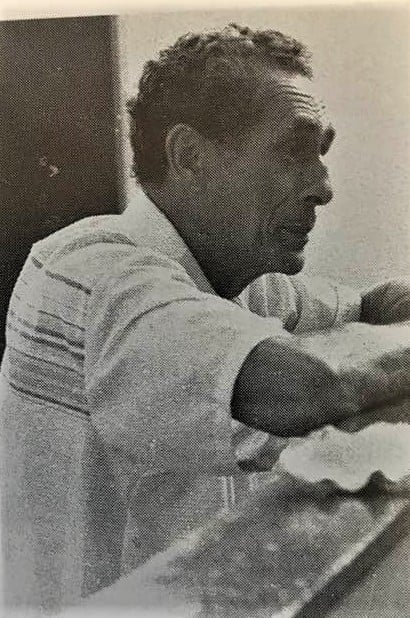
After De Gaulle banned the RDPT in 1963, John Teariki founded Te Pupu Here Ai’a Te Nunaa ia Ora (Patriotic Group for an Autonomous Polity) in 1965. The new party held its first congress on 2 July 1966, the day of the first French nuclear weapon test at Moruroa Atoll and passed a motion “to use all peaceful and legal means to end nuclear testing”.
Then in February 1965, Pouvana’a a O’opa was pardoned by President De Gaulle but refused permission to return to Tahiti for 15 years. In May, the French authorities announced the first test would take place with a ‘danger zone’ declared around it which includes seven inhabited atolls. In the TA, John Teariki stated: “If this zone is declared dangerous and prohibited for sailors and pilots throughout the world, why would it not be equally so for the inhabitants?” The authorities acknowledged their mistake and changed the radius of the zone, but Tureia remained in the danger zone and the inhabitants were not evacuated.
On 21 July, plutonium contaminated an area of Moruroa during a ‘safety-firing’ of a nuclear device (in which there is no nuclear reaction). The contaminated area was covered with bitumen in an attempt to contain the plutonium, but bitumen cannot shield radiation.
President De Gaulle visited French Polynesia on 24 September 1966 to view a 120 KT atmospheric nuclear weapon test at Moruroa Atoll from a French warship offshore. Radioactive fallout from the test reached Tureia and other islands in the Gambier Group of the Tuamotu Archipelago to the west and elevated levels of radiation were recorded in Apia, Samoa, in rainwater tanks four days later by New Zealand government scientists.
The Pupu Here Ai’a party won seven of 30 seats at the 1967 election and formed a coalition government in the Territorial Assembly with the pro-autonomy E’ai Api party led by Francis Sanford. Both parties opposed French nuclear testing.
The TA immediately expressed its opposition to the tests and strong fears for the health of the indigenous Mā’ohi people living on Tureia after the recent test. The French Governor, Aimé Grimald, responded by threatening to dismiss the TA if it continued to protest against the nuclear testing.
John Teariki, Francis Sanford and Pouvana’a a O’opa continued to call for an end to the nuclear testing and the TA urged France to allow independent scientists to investigate radioactive contamination from the nuclear tests. Neither were heeded by the French government and the tests continued.
In July 1967, some of the Mā’ohi living on Tureia moved to Tahiti where they confirmed reports that fallout shelters were being built on Mangareva, Reao and Pukarua.
In August, the Pape’ete town council adopted a strongly worded resolution once again demanding that the French authorities distribute information on the dangers of radiation, including to local news media. French Governor Grimald responded by quoting an 1879 French decree that “the municipal council cannot make any protest or petition” and declared that the Pape’ete town council had therefore committed an illegal act.
In January 1968, the TA requested that the French authorities invite three overseas scientists from Japan, New Zealand and the US and three French scientists supported by technicians from the French National Radiation Laboratory (SCPRI) to study radioactive contamination caused by the tests.
On 7 July 1968, Francis Sanford drafted a resolution in the TA calling for an end to French nuclear testing. The following month, on 24 August, his son died from leukaemia.
On the same day, France detonated a 2.6 MT thermonuclear bomb at Fangataufa Atoll followed by another similar-sized bomb at Moruroa Atoll two weeks later. Afterwards, the French authorities decided that Fangataufa was so contaminated that it was not used again as a test site for 6 years.
In November, the French government announced that the nuclear test series planned for 1969 would be cancelled due to a lack of funds. Opponents said serious radioactive contamination from the two huge August thermonuclear tests may have been the real reason.
Then on 30 November, Pouvana’a a O’opa returned to Tahiti after he was pardoned by De Gaulle, less than 6 months before De Gaulle resigned as president on 28 April 1969. Georges Pompidou was elected as the new French President on 15 June 1969, who had been prime minister under De Gaulle from 1962 to 1968. One of his ‘aides’ was a young Jacques Chirac, who would later be elected French President in May 1995.
The nuclear tests resumed on 24 June 1970 with a series of eight planned, including an experimental 1 MT hydrogen bomb. In 1971 there were five tests, including another in the 1 MT range. Following that, the governments of New Zealand, Fiji, Tonga, Samoa, Cook Islands, Tuvalu and Peru all protested to the French government about the tests.
The growing opposition to French nuclear testing in Tahiti Nui during the 1960s explicitly linked ending nuclear testing to ending French colonial rule. That opposition included indigenous Mā‘ohi political, civic, trade union and church leaders as well as Europeans active in those or other anti-testing organisations, such as Bengt and Marie-Thérèse Danielsson. Their book “Moruroa Mon Amour: The French Nuclear Tests in the Pacific” (Paris, 1974; New York, 1977) recounting the French nuclear testing programme and the opposition to it helped to spread awareness of the impacts of the tests, and was reprinted in an updated edition entitled “Poisoned Reign: French nuclear colonialism in the Pacific” by Penguin Books (Auckland, 1986).
Bengt Danielsson (1921-1997) was an anthropologist, writer and a crew member on the Kon-Tiki voyage from South America to French Polynesia in 1947. He served as Swedish Consul in French Polynesia from 1961 to 1978 and was a correspondent for Pacific Islands Business magazine. Marie-Thérèse Danielsson (1924-2003) was an ethnologist and leader of the Women’s International League for Peace and Freedom (WILPF) in French Polynesia. In 1991, they were awarded the Right Livelihood Award for “exposing the tragic results of and advocating an end to French nuclear colonialism”. In their last years they moved to live in Sweden and remained active against French nuclear testing as members of the board of directors of Greenpeace Sweden. Their daughter Maruia (1952–1972) died from cancer at an early age, six years after the French nuclear tests began in Tahiti Nui.
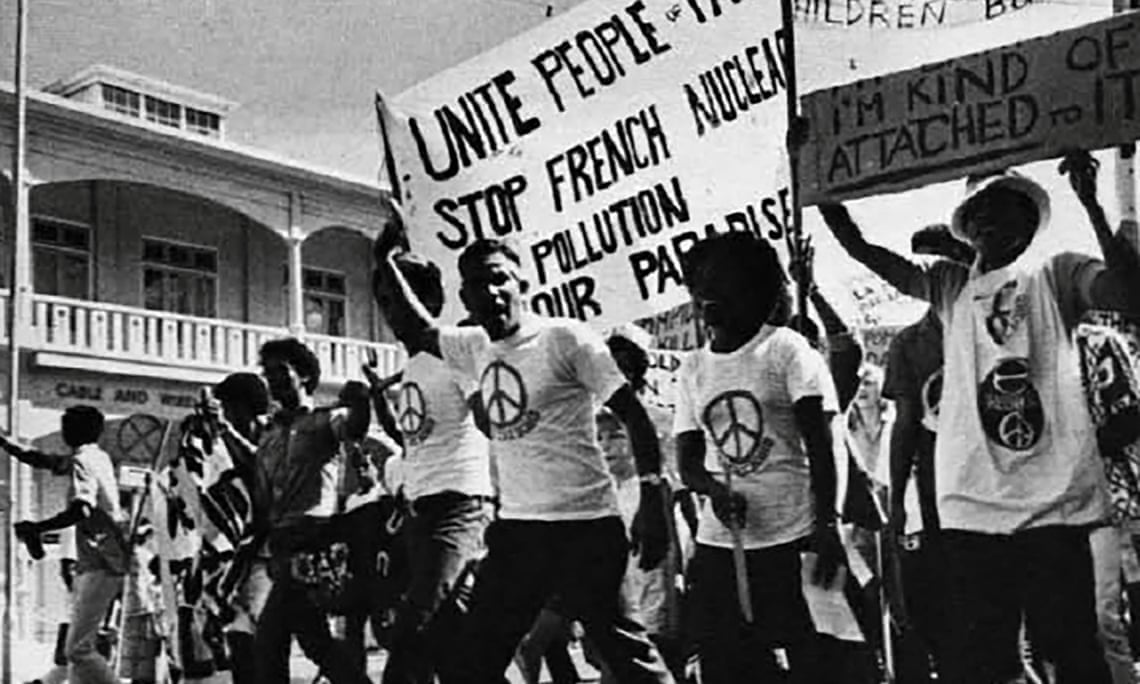
Fiji and the origins of the Nuclear Free and Independent Pacific movement
In the 1970s, Indigenous people and others around the region active in opposing the French nuclear tests started to form the Nuclear Free and Independent Pacific (NFIP) movement. As in Tahiti Nui, this wider regional movement also linked nuclear testing to colonialism. When Fiji became independent in October 1970, the government in Suva became increasingly outspoken against the French tests at the same time that various civil society and church groups and community activists were mobilizing.
Walter Johnson and Sione Tupouniua (1976) have described how the ‘Against Testing on Moruroa’ (ATOM) group was founded in Fiji on 28 May 1970 by the Fiji Young Women’s Christian Association (YWCA), Fiji Council of Churches, and University of the South Pacific Students Association at a meeting attended by 600 people at Suva Town Hall to protest against radioactive contamination of the Pacific by French nuclear testing (See: Against French Nuclear Testing: The A.T.O.M. Committee, The Journal of Pacific History, Vol. 11, No. 4 (1976), pp. 213-216).
Fiji’s First Minister at the time, Ratu Sir Kamisese Mara – soon to become the first prime minister of an independent Fiji – expressed support for the meeting and an ATOM committee was formed to carry on the protest. The new committee issued a statement pledging: “It will protest against all nuclear testing, but have a specific concern with the Pacific area, and therefore anyone who tests in the Pacific area, e.g. the French at present.”
Dimity Hawkins (2024) has described how the government of Fiji, the South Pacific Forum and civil society groups in Fiji campaigned to stop French nuclear testing (See: ‘We will not Relax our Efforts’: The Anti-Nuclear Stance of Civil Society and Government in Post-Independence Fiji”, The Journal of Pacific History, Volume 59, 2024 – Issue 1: Resistance and Survival – The Nuclear Era in the Pacific).
Hawkins (2024) reports that the first Fijian director of the Fiji YWCA (established in 1962), Amelia Rokotuivuna, later became “a pillar” of the anti-nuclear movement in Fiji.
She also identifies how the Pacific Conference of Churches (established 1966) became a strong voice against nuclear testing across the Pacific and the University of the South Pacific (USP, established 1968) was a catalyst for the development of a strong anti-nuclear testing movement in Fiji.
She reports that USP scholar Vijay Naidu, who was a leading anti-nuclear activist at the time, described the USP as, “the cradle of the regional anti-nuclear and independent Pacific movement, building the campaign against nuclear weapons testing in French Polynesia and, later, the nursery for independence and pro-democracy movements”.
In describing ATOM, Hawkins says, “Naidu explained the group’s aims were to ‘inform the Fiji public about the nuclear tests in French occupied Polynesia and also to act as a pressure-group to urge the Fijian government to take steps to stop these tests’. While it was active over a relatively short time, from formation in 1970 to gradual dissipation after 1975, ATOM played a significant role in coalescing the organizational and public voices of nuclear resistance, educating the public and engaging the newly independent government. The brief life of the group helped to build momentum on nuclear resistance in the region and actively engaged with the Fijian government.”
Hawkins also notes that key members of ATOM had scientific backgrounds, including its first president, Graham Baines, and first secretary, Suliana Siwatibau, who were both biologists at the USP. She says “… their academic approach combined with the grassroots concerns of the student, women’s, church and trade union movements created a strong platform.”
She also describes how ATOM challenged the French government’s spurious claim that the nuclear tests were not causing harm: “ATOM brought together knowledge, skills, and outreach capacity, promoting awareness of nuclear testing, instigating community meetings, education activities, and public rallies, and engaging media and politicians. Collaborations with Fijian trade unions, picketing of airline offices, petitioning the French president, and large public meetings and rallies were amongst the important actions. Much of the public education was led by science and centred on Pacific sovereignty” (Hawkins, 2024).
According to Hawkins (2024) and Johnson and Tupouniua (1976), ATOM developed a 10-point plan in 1972 which was presented to regional partners and governments, including the government of Fiji, “encompassing calls for the government of Fiji to push for greater international action through a broad swathe of actions in the UN, as well as embargoes, legal and moral support for those protesting in international waters in the region, calls for radiation data to be made available, and ‘diplomatic moves to establish a nuclear weapons free zone in all or part of the Pacific Ocean’. In the years to come, many of these elements were crucial to regional diplomatic efforts and Pacific advocacy.”
Johnson and Tupouniua (1976) also report that ATOM organised a panel discussion at the USP on the subject ‘Is a Nuclear Free Pacific Possible?’ on 13 August 1973. During a discussion, involving a Fijian senator, a representative of the Pacific Council of Churches and a student from Vanuatu attending the USP, there was a suggestion to organise a conference.
ATOM organised the first ‘Conference for a Nuclear Free Pacific’ in Fiji from 1-6 April 1975, which was attended by 90 delegates and chaired by Amelia Rokotuivuna of the YWCA (See: ‘Will to fight together’: Fiji has taken another bold step in the battle against nuclear weapons, Vanessa Griffen and Talei Luscia Mangioni, The Guardian, 8 July 2020). Dimity Hawkins (2024) gives an account of the proceedings and significance of the conference, from which the Nuclear Free and Independent Pacific NFIP group emerged.
Further triennial NFIP conferences were held at Ponape in Micronesia in 1978, Hawai’i in 1980, and in Vanuatu in 1983, where a People’s Charter for a Nuclear Free and Independent Pacific was adopted.
The Charter declared: “We, the people of the Pacific have been victimised too long by foreign powers. The Western imperialistic and colonial powers invaded our defenceless region, they took over our lands and subjugated our people to their whims. This form of alien colonial, political and military domination unfortunately persists as an evil cancer in some of our native territories such as Tahiti-Polynesia, Kanaky, Australia and Aotearoa. Our environment continues to be despoiled by foreign powers developing nuclear weapons for a strategy of warfare that has no winners, no liberators and imperils the survival of all humankind.”
The next NFIP conferences were held in Manila in The Philippines in 1987 and in South Auckland in Aotearoa in 1990. These conferences advocated for a nuclear-free and independent Pacific, strengthening of the regional movement against nuclear testing, and political independence of Pacific nations.
The NFIP movement brought together indigenous peoples and others active in anti-nuclear movements from Hawai’i, Great Turtle Island (North America), Aotearoa, East Timor, West Papua, The Philippines, Tahiti Nui, Polynesia, Melanesia, South Korea and Japan.
In his introduction to the special issue of the Pacific Journal of History, entitled “Resistance and Survival – The Nuclear Era in the Pacific” (Issue 1, Volume 59, 2024), guest editor Nic Maclellan (2024) includes this brief summary: “For 20 years from the mid-1970s, there was a broad social movement for a nuclear free Pacific, as people mobilized against French nuclear testing through churches, trade unions, non-government organizations, and women’s groups. Environmental organizations such as Greenpeace were central to this movement, courageously sailing yachts and other vessels into nuclear testing zones (at great cost, with the death of Fernando Pereira in the 1985 terrorist bombing of the Greenpeace flagship Rainbow Warrior by French agents).
Within this broad campaign, however, there was also a structured movement for a Nuclear Free and Independent Pacific (NFIP), led by Pacific Islanders and Indigenous peoples from Pacific Rim countries. The NFIP movement had its own secretariat, the Pacific Concerns Resource Centre (PCRC), with a region-wide executive board. In the pre-internet age, common experiences were shared through a monthly newsletter Pacific News Bulletin and triennial conferences that determined policy and joint campaigns.”
He also lists participants at the October-November 1978 NFIP conference in Ponape in the Federated States of Micronesia as including Nelson Anjain (Republic of the Marshall Islands), Oscar Temaru and Téa Hirshon (Mā‘ohi Nui), Déwé Gorodé and Yann Céléné Uregei (Kanaky), Bernard Narokobi (Papua New Guinea), Walter Lini, Fred Timikata, and John Naupa (New Hebrides/Vanuatu), Moses Uludong (Belau/Palau), Lorine Tevi and Rev. Akuila Yabaki (Fiji), and Aboriginal activists Gary Foley, Clarrie Grogan, and Brue Walker.
In the same special issue of the Journal of Pacific History, Marco de Jong documents the roots of the NFIP movement among Māori activists in Aotearoa, detailing the work of the Auckland-based Pacific Peoples Anti-Nuclear Action Committee (PPANAC) and activists such as Hone Harawira and Hilda Halkyard-Harawira (See: ‘Our Pacific Through Native Eyes’: Māori Activism in the Nuclear Free and Independent Pacific Movement, 1980–5, The Journal of Pacific History, Volume 59, 2024 – Issue 1: Resistance and Survival – The Nuclear Era in the Pacific). Maire Leadbeater’s book “Peace, Power & Politics: How New Zealand became nuclear free” (2013, Otago University Press:) also includes a chapter on the Nuclear Free and Independent Pacific movement.
Greenpeace delegates to the NFIP conferences included Kay Couper in 1975, Elaine Shaw in 1980, and Bunny McDiarmid in 1987 and 1990.
Maclellan emphasises how the articles in the special issue of the Pacific Journal of History reflected, “the renewed focus on documenting Islander responses to the Cold War testing programmes by the Western powers. Echoing the contemporary call from Pacific climate justice activists (‘we are not drowning, we are fighting!’), they highlight examples of local, regional, and North–South resistance to nuclear weapons by Pacific Islanders. While based on longstanding practices of archival research, they draw on creative and artistic expressions of multidisciplinary approaches and interrogate the historian’s role.”
He identifies the following significant themes highlighted by the articles in it:
- Protests by Pacific Islanders against nuclear testing began in the 1950s, pre-dating the rise of the wider NFIP movement in the 1970s;
- Fiji’s early foreign policy and the formation of the South Pacific Forum in 1971 involved significant advocacy against French nuclear testing;
- The role of culture and identity was central to Pacific anti-nuclear activism, amplified through song, poetry, graphic design, and community theatre as well as the written word;
- The NFIP movement played a critical role linking local struggles to the wider regional context, through pan-Pacific, Indigenous-led activism around self-determination and decolonization;
- The connections between the NFIP movement and solidarity movements in the Global North, at a time of Cold War nuclear build-up, carried Islander perspectives into global debates – echoing contemporary climate justice initiatives.
He also describes how, “Throughout the 1950s, customary leaders and intellectuals from Fiji, Cook Islands, Marshall Islands, Samoa, and other colonial dependencies combined to speak out against the US and British nuclear programmes, petitioning the United Nations for an end to nuclear testing. … The special issue also includes a striking example of these petitions to the United Nations Trusteeship Council. The petition, inspired by the March 1954 Bravo atmospheric nuclear test on Bikini Atoll, was prepared by customary iroij (chiefs), local businessmen, and schoolteachers in the Marshall Islands. It requested that ‘all experiments with lethal weapons in this area be immediately ceased’.”
The special issue reproduces the 20 April 1954 Marshall Islands petition: MANUSCRIPT XLIII: Petition to the United Nations Trusteeship Council from the Marshallese People, 20 April 1954, Nic Maclellan: https://www.tandfonline.com/doi/full/10.1080/00223344.2023.2285475#abstract
The main requests in the petition were as follows:
* All the experiments with lethal weapons within this area be immediately ceased.
* If the experiments with said weapons should be judged absolutely necessary for the eventual well being of all the people of this world [Page 3] and cannot be stopped or changed to other areas due to the unavailability of other locations, we then submit the following suggestions:
- All possible precautionary measures be taken before such weapons are exploded. All human beings and their valuable possessions be transported to safe distances first, before such explosions occur.
- All the people living in this area be instructed in safety measures. The people of Rongelab would have avoided much danger if they had known not to drink the waters on their home island after the radio-active dusts had settled on them.
- Adequate funds be set aside to pay for the possessions of the people in case they will have to be moved from their homes. This will include lands, houses and whatever possessions they cannot take with them, so that the unsatisfactory arrangements for the Bikinians and Eniwetak people shall not be repeated.
- Courses be taught to Marshallese Medical Practitioners and Health-Aides which will be useful in the detecting of and the circumventing of preventable dangers.
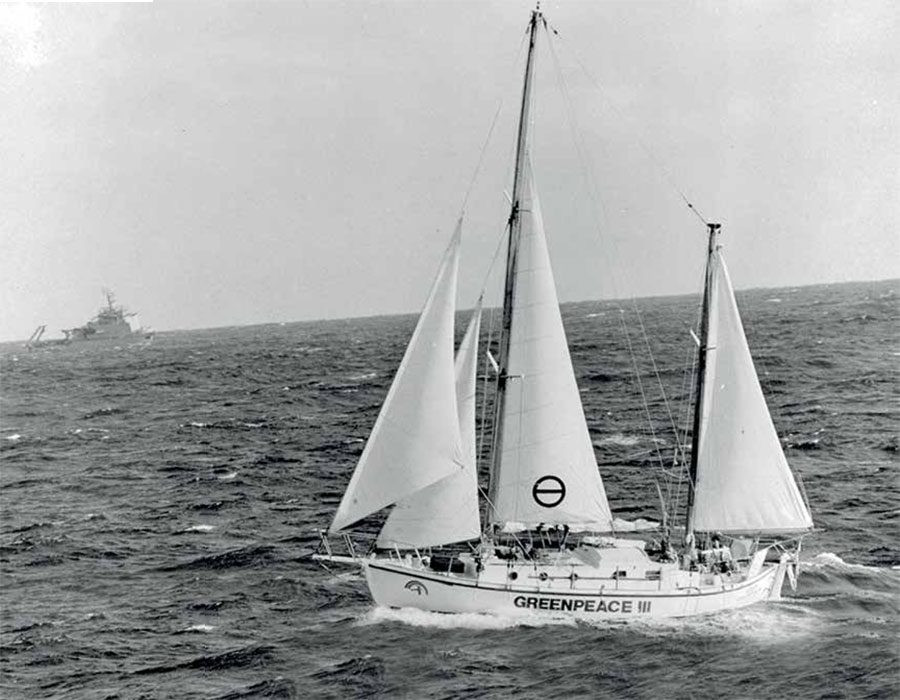
Greenpeace and the Moruroa peace flotilla protests of the 1970s
As opposition to French nuclear testing continued to grow around the region, a grassroots network started mobilising in support of the first anti-nuclear testing protest yacht to sail from Aotearoa to disrupt the French government’s nuclear weapons testing at Moruroa Atoll.
Greenpeace III (originally named Vega) departed from Auckland on 17 April 1972 sailed by skipper David McTaggart and crew members Anna Horne, Nigel Ingram and Ben Metcalfe, A Canadian who represented the new Greenpeace Foundation that had been set up in Vancouver in 1971 to oppose US nuclear testing at Amchitka in the Aleutian Islands of Alaska (which was previously known as the ‘Don’t Make a Wave Committee’).
Two months after Greenpeace III departed for Moruroa, three more small yachts formed a flotilla to join them off Moruroa, assembled and supported by New Zealand CND, Peace Media and a loose network of students and individuals opposed to the tests. The NZ flotilla included Tamure, Boy Roel and Magic Isle, although for various reasons these other small yachts did not make it to Moruroa.
Greenpeace III arrived off Moruroa Atoll and then entered the exclusion zone set up by the French authorities on 1 June. Shortly after that on 13 June the United Nations Conference on the Human Environment in Stockholm, Sweden, condemned French nuclear testing and adopted a declaration calling for the elimination of nuclear weapons.
On 1 July, Greenpeace III was rammed and seized by a French warship and towed to Moruroa Atoll. Further details of the early protest voyages from Aotearoa to Moruroa are contained in Making Waves – the Greenpeace New Zealand Story 1971 – 1990 (Michael Szabo, Reed Books, 1991).
On 25 November 1972, both the New Zealand and Australian governments brought cases against French nuclear testing to the International Court of Justice in The Hague, requesting the Court issue an interim injunction against the French tests going ahead while the case proceeded. They were later joined by the government of Fiji in May 1973.
As Hawkins (2024) points out, Fiji was the only Pacific Island state to make formal interventions in each of the cases, and submitted evidence of the harm the tests were doing across the region. The application also listed Fiji’s formal protests and other actions taken, including direct pleas to the French government, speeches at the United Nations General Assembly, the South Pacific Forum condemning French nuclear testing, objections raised in other UN forums and at Commonwealth Heads of Government Meetings. The application also noted the government of Fiji had imposed bans, “on the landing and overflight by French military aircraft and on calls by French naval vessels which might be connected with the tests” and that “Fiji public opinion has also voiced its strong opposition to the continuation by France of its testing programme.”
In May 1973, Pouvana’a a O’opa and Francis Sanford sent an open letter to 200 newspapers in metropolitan France calling for the tests to end. Only one newspaper published it (L’Express), owned by anti-nuclear testing French politician Jean-Jacques Servan-Schreiber. In response he called for the formation of a ‘Bataillon de la Paix’ to travel to Tahiti to join the opposition to the tests, including former French army general Jacques Pâris de Bollardiere.
Two of the main French trade unions representing three million workers also supported the protest and there were anti-testing protests in Paris, Toulouse and Montpelier. In Paris the police baton-charged the demonstrators to break them up and anti-nuclear marchers were prevented from crossing the border from Belgium into France by French authorities (Miles and Shaw, 1990).
On 24 May 1973, 82 nations including Britain and the Soviet Union voted for a World Health Organization (WHO) resolution in Geneva deploring all atmospheric nuclear tests (at the time China was also conducting atmospheric nuclear tests at Lop Nor in Xin Jiang Province, in the west of China).
In Australia, trade unions refused to unload French imports and a thousand bags of post from France piled up in transit there. In Britain, the Trade Union Congress called an all-union boycott of commerce and communications with France from 1-7 July 1973.
A second larger anti-testing flotilla was organised which sailed from Aotearoa to Moruroa in May-June 1973, including Fri, crewed by David Moodie, Martini Gotje, Rien Achterberg, Rua Paul, Naomi Peterson, Ted Rutter and others, as well as Greenpeace III, once again crewed by David McTaggart and Anna Horne plus Nigel Ingram and Mary Lornie. The other yachts that sailed from Aotearoa were Spirit of Peace, Bluenose, Barbary, Arakiwa, and Tanea.
The Fri’s 1973 voyage is documented in the book ‘Fri Alert’ (1974, editor Elsa Caron) and the documentary film directed by Alister Barry, ‘Mururoa 1973’.
More protest yachts were set to sail to Moruroa from around the region, including Bluenose, Arakiwa and Tanea from Tauranga; two other boats from Wellington and Christchurch; Malaguena, Warana and La Flor from Australia; Carmen from Tahiti, and others from Fiji, Samoa and Peru. Only Fri, Vega and Spirit of Peace were able to make it as far as Moruroa. Three decades later it emerged that the French military had sabotaged some of the early protest yachts before their planned departures (See: “Tale of ineptitude and machismo”, Catherine Field, NZ Herald, 1 July 2005).
In Pape’ete, over 5,000 people rallied against nuclear testing on 23 June 1973, the biggest rally there to date which included Pouvana’a a Oopa, Francis Sanford and six members of the ‘Bataillon de la Paix’.
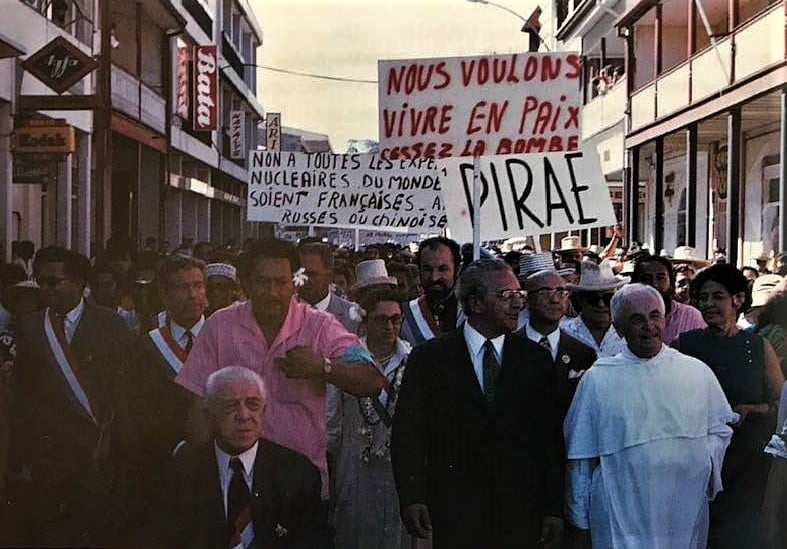
On 23 June 1973, Pouvana’a a Oopa (front centre), Francis Sanford (right of Pouvana‘a wearing suit jacket) and Jean-Jacques Servan-Schreiber (second from left with sash) marching against French nuclear testing, Pape’ete, Tahiti. Photo by Bengt Danielsson.
The New Zealand government led by Labour Prime Minister Norman Kirk sent messages to 100 countries to mobilise support for the protest. The same day the ICJ urged France to avoid conducting any nuclear tests that caused radioactive fallout to reach the territories of New Zealand and Australia.
After France ignored the ICJ’s interim injunction against the tests, NZ Prime Minister Norman Kirk ordered the navy frigate HMNZS Otago to Moruroa to officially protest against the nuclear tests, which was later relieved by HMNZS Canterbury. Shortly after that, Australia and Peru recalled their ambassadors from France in protest, and then Peru broke off diplomatic relations with France.
On 15 August 1973, French commandos boarded Greenpeace III, assaulting skipper David McTaggart and injuring one of his eyes, prompting the NZ government to deliver a formal protest to France.
Then in April 1974, French President Pompidou died and a new presidential election was called. Valéry Giscard d’Estaing won the election on 20 May, polling 50.8% of the vote, narrowly defeating the Socialist Party candidate Francois Mitterrand. He came from the conservative side of French politics but was relatively more liberal compared to De Gaulle and Pompidou, and as a former senior civil servant he was seen as part of a new generation of ‘technocrats’.
On 8 June 1974, the new President Giscard d’Estaing announced that after a series of eight nuclear tests that year, from 1975 all French tests would be conducted underground at Moruroa and Fangataufa atolls.
Opposition to the French nuclear tests from within Tahiti Nui and the wider region, the protest flotillas of 1972 and 1973, the legal cases taken to the International Court of Justice, protests within metropolitan France, and growing regional and international diplomatic pressure undoubtedly all played a large part in the decision by the French government to end the atmospheric nuclear tests. However, moving them inside Moruroa and Fangataufa atolls into shafts drilled down through the coral into the underlying rock including below the waters of the turquoise lagoons was not a genuine solution to the problem of radioactive contamination.
Encouraged by the end of French testing in the atmosphere, on 11 August 1974, coordinated by the newly incorporated Greenpeace New Zealand, Fri embarked on an epic three-year 40,000km “Pacific Peace Odyssey” from Aotearoa, carrying the anti-testing Nuclear Free message to all of the nuclear weapons states.
Their morale was also boosted by a telegram of support from John Lennon and Yoko Ono. After port visits in Aotearoa, the Fri sailed to Tahiti, arriving there on 7 September for a week of meetings and public activities in collaboration with Pouvana’a a Oopa, John Teariki, Francis Sanford, Oscar Temaru and Bengt and Marie-Thérèse Danielsson, including a tree planting ceremony for peace. They also helped to support the crew of the Fri while they were there.
Joined by Tahitian crew member, Emile Gfeller, they departed Tahiti, sailing on to Raiatea and Tahaa in the Society Islands, then to Fiji. In Suva, the government of Fiji supported their visit. ATOM was their local contact and a benefit concert by folk singer Julie Felix raised funds for Fri and the NFIP conference planned for 1975. From there Fri visited Vanuatu, at that time still a joint French and British administered colony called New Hebrides. During Fri’s visit, Walter Lin̄i spoke enthusiastically to the assembled crew.
After that they made a short visit to Tarawa and Arorae in Kiribati before continuing north to Majuro, Rongelap and Bikini in the Marshall Islands. They arrived to an amazing welcome on Rongelap, staying there for three days. While there they heard the islanders’ bitter complaints about the tests and the US authorities. It was agreed that Nelson Anjain would join them to sail to Hiroshima in Japan to seek independent medical advice on radiation-related diseases and medical aid. When they arrived there, the Mayor of Hiroshima held a formal reception for them.
The crew also attended the 6 August annual Hiroshima Day memorial service in the Peace Park at 8.15am, the moment the bomb was dropped thirty years before in 1945. Then they collaborated with local peace groups to organise an all-night mini festival, with music, theatre and films, lifting spirits after the Hiroshima Day proceedings.
While there the crew also helped with the restoration of Daigo Fukuryū Maru (Lucky Dragon No. 5) and Nelson Anjain made contact with and set up connections with survivors of the 1945 Hiroshima bombing, known in Japan as the ‘Hibakusha’, and other concerned citizens.
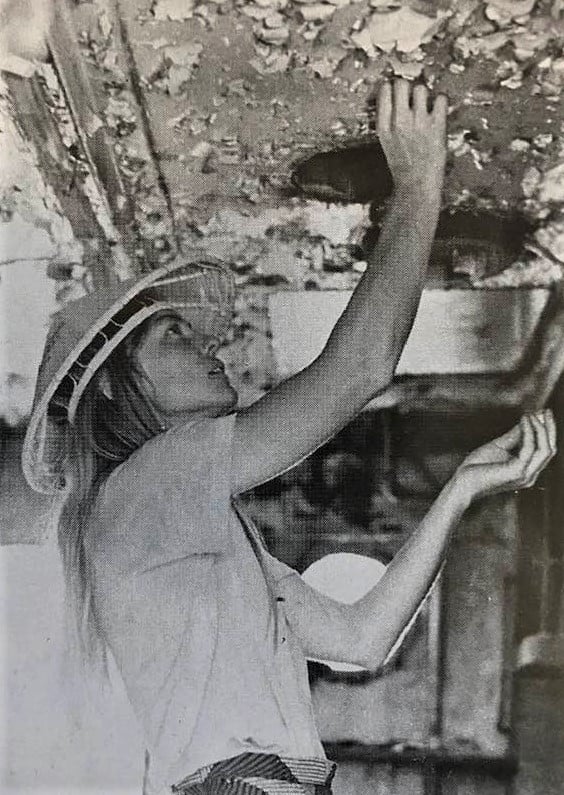
During the Fri’s Odyssey, the crew met with mayors, officials and political and cultural leaders, and visited public venues, workplaces and schools to speak about their anti-testing nuclear-free message, sometimes planting a tree to commemorate their visit (inspired by John Lennon and Yoko Ono who had planted trees for peace in the grounds of Coventry Cathedral in Britain in 1968). The Fri also visited Nahodka in the Soviet Union, made a thwarted attempt to visit Shanghai in China which the authorities there prevented, and visited Hong Kong (then a British Territory) and Chennai (after India ‘tested’ its first nuclear weapon in 1974).
While the global pressure to end the tests temporarily lost some momentum in other parts of the world, the campaign continued in Tahiti Nui and the wider South Pacific region. In Pape’ete, Francis Sanford used his platform in the TA to keep pushing the French authorities to allow an independent scientific assessment of the impacts of the tests and Oscar Temaru, a former worker and union representative at Moruroa, publicly championed the health and safety of workers at the test sites.
In October 1978, Oscar Temaru publicly accused the French authorities of keeping 15 Tahitian workers in isolation at Moruroa while suffering from radiation sickness. The authorities denied this, saying the workers had viral hepatitis. Oscar Temaru also reported that local people were not allowed to eat fish at the nearby islands because of the presence of a disease called ciguatera, triggered by the nuclear testing programme.
Ciguatera is a virulent form of food poisoning caused by eating reef fish contaminated with neurotoxins which cannot be destroyed by cooking the fish. Symptoms include vomiting, diarrhoea, stomach pains and breathing difficulties. In the most serious cases it can affect the heart. It can be fatal but can also be chronic lasting for months or years. There is no entirely effective treatment.
Associate Professor Tilman Ruff of the University of Melbourne published a paper on “Ciguatera in the Pacific: A Link with Military Activities” in The Lancet (January 1989) which drew a conclusive link between increasing incidents of ciguatera poisoning in Tahiti Nui with the French nuclear testing programme at Moruroa Atoll.
Greenpeace New Zealand was registered as an Incorporated Society in 1974. Among the co-founders were Bette Johnson, Irene and Hugh Petersen, Elaine Shaw and Michael Taylor. They continued to organise regular anti-nuclear testing marches in Auckland through the late 1970s marking Bastille Day on 14 July, Hiroshima Day on 6 August and Bikini Day on 1 March – later becoming known as Nuclear Free and Independent Pacific Day – plus marches and vigils whenever there was a nuclear ship visit or a French naval ship visit.
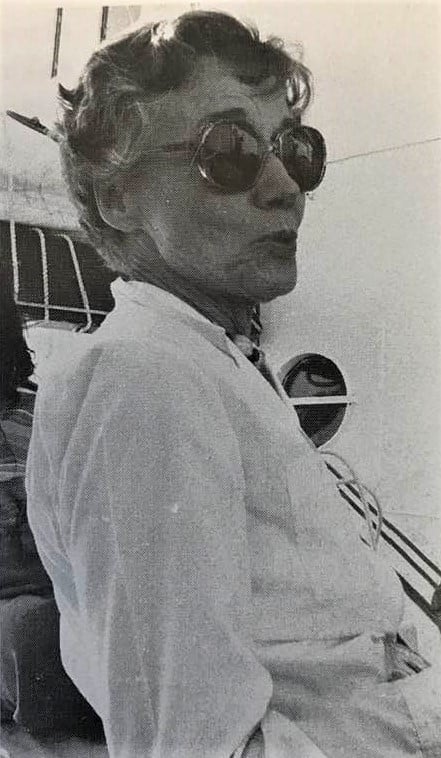
Bette Johnson was a long-time civil rights activist from the US who had opposed nuclear testing since the tests at the Marshall Islands in the 1950s. She was crucial in holding together the embryonic Greenpeace organisation in Aotearoa, giving guidance and training in campaigning. Her fast and feisty protests were delivered in a gravelly Chicago accent, earning her the nickname ‘the machine-gun for peace’.
Perhaps Bette’s most valuable contribution to the early Greenpeace organisation was in cultivating proteges, of whom Kiwi Elaine Shaw was the first of many. The embryonic Greenpeace group met regularly at her Ponsonby flat, thriving on encouragement from Bette and Fri skipper David Moodie, a young and idealistic long-haired American from east coast USA. Bette’s son, Giff, went on to play a role in the early years of the Nuclear Free and Independent Pacific movement.
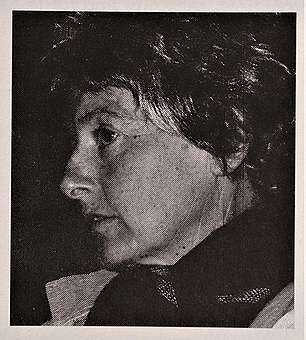
After 1974, Bette Johnson divided her time between Fiji and Aotearoa. Her time in Fiji was spent working alongside the ATOM group, New Zealand CND and the Australian trade unions on the first Nuclear Free and Independent Pacific conference in April 1975, which Kay Souper attended as Greenpeace’s delegate.
Elaine Shaw picked up Bette’s enthusiasm for working with allies in the wider Pacific region, attending the NFIP conference in Hawai‘i in 1980, by which time she knew many of the people involved in the NFIP movement.
She first met Walter Lin̄i in 1978 when he visited Aotearoa as a member of the pro-independence Vanua’aku Party, and then again in 1979 when she accompanied him to Bastion Point during the land occupation there by Māori land rights activists. A Raga Anglican priest who had trained at St John’s College in Auckland, he went on to become prime minister of newly independent Vanuatu in 1980, serving until 1991. During his tenure, Vanuatu declared itself Nuclear Free in 1983, banning nuclear warship visits.
On 6 July 1979, there was reportedly an explosion and fire in a laboratory on Moruroa Atoll that handled radioactive materials, including plutonium, in which one person was killed, a second died in hospital, and four were sent to France for treatment. According to workers on Moruroa the whole area was scrubbed down by workers in protective suits for two weeks afterwards to decontaminate the area of plutonium (Miles and Shaw, 1990).
On 25 July, a Paris newspaper reported that a 150 KT nuclear warhead had been detonated after it became prematurely stuck down a test shaft at Moruroa, causing a tidal wave. The French authorities denied the tidal wave was caused by a nuclear test, claiming it was caused by “volcanic activity”.
It later emerged that this detonation caused a submarine landslide dislocating an
estimated 110 million square metres of coral and rock, resulting in a 3-metre wave which swept over the southern part of Moruroa Atoll and through the Tuamotu Archipelago.
On 2 August, another storm hit Moruroa, scattering more radioactive debris. On 22 September, over 2,500 civilian test site staff and technicians threatened to strike if the radioactive waste spread by the recent tropical storms was not cleaned up.
The CFDT union representing workers at Moruroa published a report revealing that barrels of radioactive waste had been washed up on beaches around the atoll. It estimated that the atoll had sunk one and a half metres since the first underground test there in 1975 which had caused an underwater crack that could be leaking radioactivity into the lagoon and ocean.
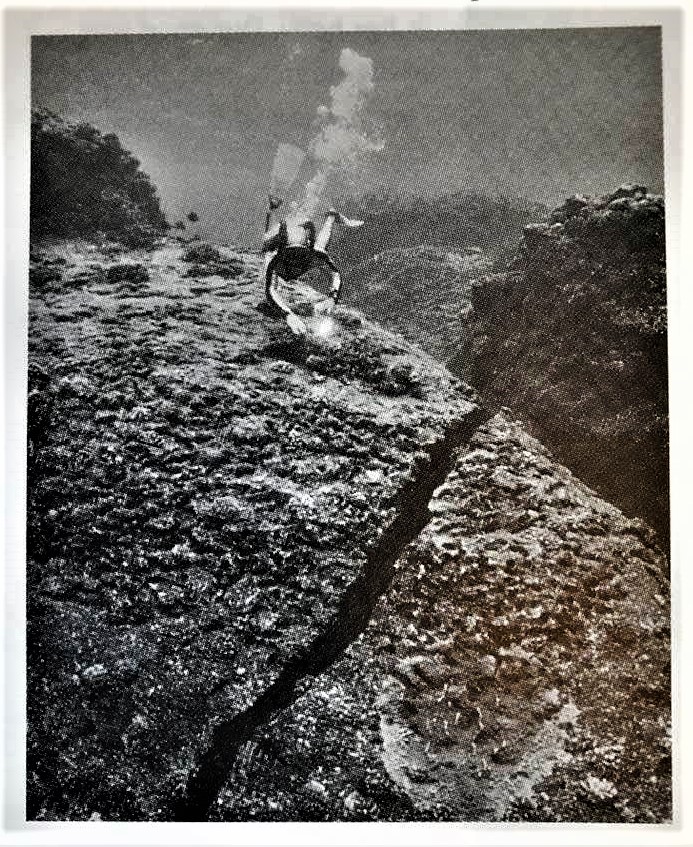
Official French documents confirmed that each underground detonation created a chimney up to 340m high and an area of fracturing radiating out 200m from the blast cavity.
On 30 November, in the face of the official refusal to inform the public of accidents and carry out decontamination procedures, three French CEA (Commissariat à l’énergie atomique) engineers published a statement that radioactivity levels on Moruroa had doubled in the previous four months and that the northern beach was a vast radioactive rubbish heap measuring 30,000 square metres.
On 28 July 1979, the TA demanded the suspension of nuclear testing and called for a territorial committee to record evidence from Tahitian workers about both accidents.
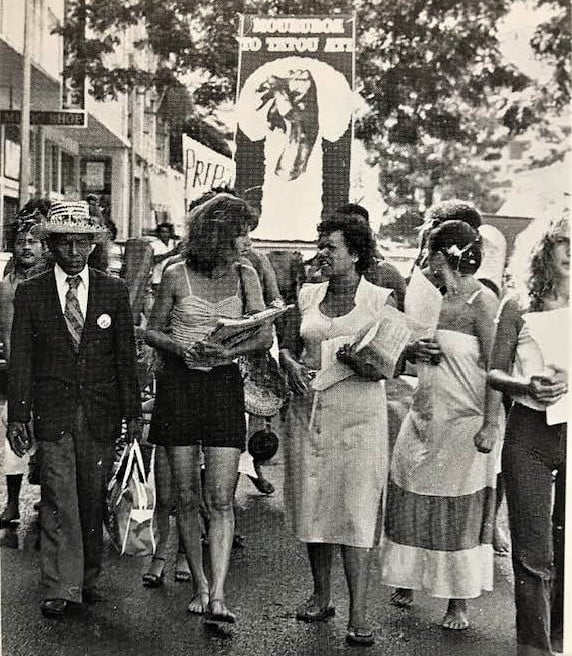
The resurgence of anti-nuclear activism in Tahiti Nui in the 1980s
Forty-nine underground tests were carried out in shafts drilled around the 25km rim of Moruroa Atoll between 1975 and 1980, resulting in the CEA running out of space for more test shafts to be drilled there. Due to the large blast cavity formed by each test, there needed to be 400m to 1000m between each new test shaft, depending on the yield of each test. So, in 1981 the CEA had to bring in a huge drilling rig so they could start drilling new test shafts directly under the waters of the lagoon.
On 11 March 1981, Moruroa was reportedly hit by a massive tropical cyclone which ripped up asphalt and exposed about 20kg of plutonium debris and swept radioactive waste onto the northern beach area of Moruroa, into the lagoon and out to sea. However, news of the disaster was not published until November 1981.
In the French Presidential election of 10 May 1981, the Socialist Party candidate François Mitterrand defeated the incumbent President Valery Giscard d’Estaing. Mitterand’s Socialist Party won an absolute majority.
On 28 May, 200 trade union delegates from around the Pacific meeting in Port Vila, Vanuatu, called for vigorous opposition to nuclear testing.
On 29 May, the new French Minister of Defence, Charles Hernu, announced a nuclear testing ‘freeze’ to enable a thorough study of the testing programme, which momentarily prompted jubilation in the South Pacific.
A few days later on 2 June 1981, the Ministry of Defence issued a statement that the nuclear tests would resume. Then on 31 July, Charles Hernu travelled to Tahiti where he claimed that thousands of Tahitians had sent letters of protest to him when he briefly suspended the tests on 29 May. When he was challenged by the Mā’ohi ecology group Ia Ora e Natura to provide evidence of this, none was forthcoming.
On 10 August, the annual South Pacific Forum heads of government meeting held in Port Vila, Vanuatu, agreed a resolution urging France to stop nuclear testing and to publish details of the health and environmental effects of the tests.
The French authorities eventually agreed to arrange to send a team of five French ‘experts’ with a group of TA members to Moruroa to investigate in October. Workers there told them that after the test involving the warhead that had got stuck, a crack appeared on the atoll surface 2km long and 40cm wide. The investigation confirmed that the warhead had stuck 800m down a 1000m test shaft and that the detonation caused a 2-3 metre tidal wave that swept over the atoll overturning vehicles and injuring five people, including two seriously.
Meeting in Tonga in September, the Pacific Council of Churches voted to support a Nuclear Free Pacific. Then on 31 October 1981, the Greenpeace yacht Vega (formerly Greenpeace III) sailed over 4,000 km from Mexico to Moruroa. The skipper was once again David McTaggart, along with new crew members Lloyd Anderson, Tony Marriner, Chris Robertson and former Bataillon de la Paix member Brice Lalonde.
They sent a message to the new French President Francois Mitterand urging him to end nuclear testing and sign a Comprehensive Test Ban Treaty (CTBT), and to allow an independent geological and epidemiological assessment of Moruroa. They waited six weeks for a written reply from Mitterand, which was sent to the Greenpeace office in Paris. He said that France would not stop the tests but would allow an independent scientific commission of inquiry into the condition of the flora and fauna at Moruroa, and invited Brice Lalonde to take part in establishing it.
Vega then sailed to Tahiti in the expectation that there would now be good faith negotiations over the selection of a team of independent scientists which both Greenpeace and the French authorities could agree on.
After a long wait the French authorities reneged on the proposal and organised their own hand-picked group of scientists without consulting Greenpeace or Brice Lalonde and reneged on their promise to allow Greenpeace a say in the establishment of the commission.
Defence Minister Charles Hernu hand-picked French vulcanologist Haroun Tazieff to lead it on 26-18 June 1982. Despite the eight person French team only having three days there with limited access to very few sites, Tazieff’s report was highly critical of the safety and environmental monitoring measures in place at Moruroa and admitted that there was still significant amount of radioactivity in the environment from the atmospheric tests, and that further study was required to ascertain if there was any radioactive release through the cracks in the atoll from the underground tests.
On 12 March 1982, delegates from 20 South Pacific Commission member states voted for a remit calling for a ban on nuclear testing in the region. Only France refused to support it.
On 10 June, the Fiji Trade Union Congress organised a one-month boycott of French goods and services, then on 28 July the PNG Public Service Union protested outside the French Embassy in Port Moresby.
On 6 August, the Evangelical Church of Polynesia passed a resolution calling for an end to French nuclear testing. Soon after that, on 9-10 August 1982, the annual South Pacific Forum heads of government meeting held in Rotorua, Aotearoa, issued a strongly worded statement calling for an immediate end to French nuclear testing.
Vega and her new skipper Chris Robinson had remained in Tahiti during 1982 waiting for the outcome of the scientific assessment.
Greenpeace also sent new campaigner Jane Cooper from Aotearoa to Tahiti, who was recently returned from her OE in Britain where she was active in the CND. After she arrived at the Greenpeace office in Auckland in early 1982, Elaine Shaw seized on her ability to speak French to help with document translations. Jane Cooper recalls that, “Over the years Elaine had built up extensive files on political struggles in the Pacific, so an apprenticeship under Elaine was an excellent introduction to the world of NFIP activism.”
Later that year Jane Cooper travelled to Tahiti for two months to help support the next Vega voyage to Moruroa and to liaise with Tahitian anti-testing activists and media. There she met the leaders of the anti-testing and pro-independence parties and groups including Tea Hirschon, Oscar Temaru, Henri Hiro and Jacqui Drollet.
In October 1982, Chris Robinson and crew members Guy (Jacky) Taero of Te Taata Tahiti Tiama, and Lloyd Anderson and Jon Castle sailed Vega to Moruroa to protest against the testing of a new and even deadlier type of nuclear weapon called a “neutron bomb” and the inadequacy of Tazieff’s three-day survey of Moruroa. A week after they arrived at the 20km exclusion zone limit French commandos from the French navy vessel La Hippopotame boarded Vega, arrested the crew and towed the yacht into Moruroa’s lagoon on 31 October.
Guy Taero was released but the other crew members were held for 24 hours before being forced to sign a document agreeing never to return to French Polynesia and then deported. The Vega was impounded by the French government for a year before being returned to Aotearoa on board a freighter in 1983.
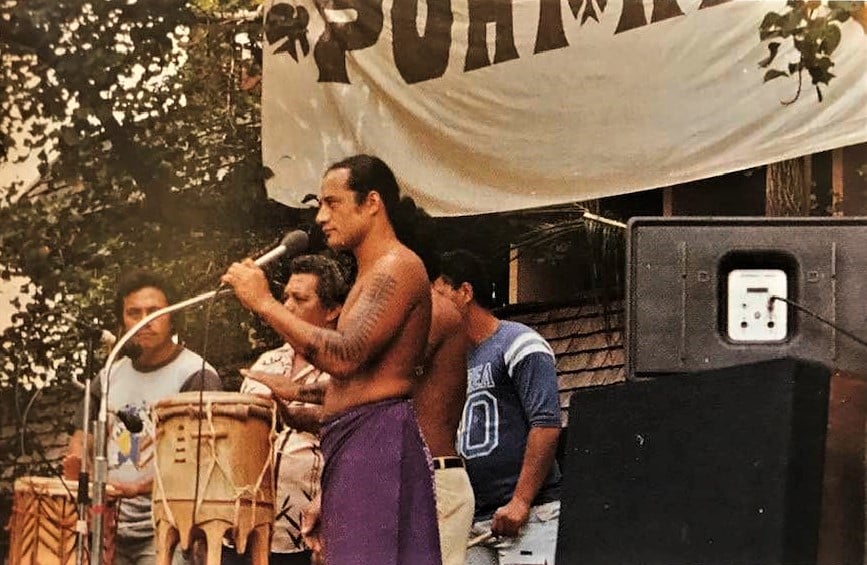
Meanwhile, Jane Cooper worked with Tea Hirschon and Oscar Temaru’s Tāvini Huiraʻatira party to organise a Puhi Hau (Breath of Peace) concert featuring traditional Polynesian music, rock groups, political speakers and poetry in Pape’ete on 11 November 1982, which attracted 4,000 people in opposition to the nuclear tests. Marie-Thérèse and Bengt Danielsson were also involved, always ready to help liaise between Greenpeace and the local activists they knew.
Jane Cooper’s presence did much to strengthen Greenpeace’s links with those who opposed the tests in Tahiti Nui. Following the concert, a new coalition of anti-testing groups was established there comprising representatives of the anti-nuclear and pro-independence party Ia Mana Te Nunaa, The Evangelical Church of Polynesia, the Women’s International League for Peace and Freedom (WILPF), the CSIP trade union and concerned individuals such as the Danielssons.
The Puhi Hau committee also organised a rally in Pape’ete to mark Nuclear Free and Independent Pacific week from 26 February 1983 attended by 500 people. Then in March, the Reformed Church of France called for an end to French nuclear testing, and in June the Australian government halted shipments of uranium to France and the Pacific Council of Churches once again called for the tests to end.
In June 1983, a map from union sources at Moruroa circulated showing four major cracks in Moruroa Atoll, a severely contaminated surface area where radioactive waste was stored, and various “forbidden entry zones”.
On June 22, Australian Foreign Minister Bill Hayden delivered a strong protest to French presidential adviser Regis Debray. Debray was once famously a friend of Che Guevara when he worked at the University of Havana in the late 1960s and an admirer of progressive Chilean President Salvadore Allende, but by 1982 he had become a well-paid Parisian apologist for French nuclear testing.
On 25 February 1984, 2000 people joined a march organised in Pape’ete against the nuclear tests by Pupu Here Aia, Ia Mana te Nunaa, Ia Ora te Natura and WILPF.
A few months later in July 1984, Chile, Colombia, Ecuador and Peru formed a new South Pacific Permanent Commission and called for French nuclear testing to end.
Then on 17 August, Tahitian activists began occupying land at Orofara about 10km from Pape’ete in protest at the nuclear tests.
Meeting in Tuvalu 27-28 August, the annual South Pacific Forum heads of government meeting passed a resolution strongly opposing all nuclear testing.
In October 1984, waterside workers in Aotearoa refused to work on French ships carrying materials to Moruroa.

The 1985 “Pacific Peace Voyage” and Operation Exodus
On Bikini Day, 1 March 1985, Greenpeace announced that the Rainbow Warrior would begin a “Pacific Peace Voyage” to the Marshall Islands, Vanuatu, Aotearoa before sailing to protest against the French tests at Moruroa.
In May 1985, responding to a request from Rongelap Senator Jeton Anjain, the crew of the Rainbow Warrior helped to relocate the people of Rongelap in the Marshall Islands to Mejatto, as part of Operation Exodus. Details of the operation and photos can be viewed online here.
Kiwi journalist David Robie and Portuguese photographer Fernando Pereira were on board during Operation Exodus and what was to be the last voyage of the Rainbow Warrior. They both documented the voyage and their work is contained in David Robie’s illustrated book “Eyes of Fire: the Last Voyage and Legacy of the Rainbow Warrior”. Originally published in 1986, a second revised edition has recently been published (Little Island Press, 2025).
After Operation Exodus, the Rainbow Warrior arrived in Port Vila on 7 June, where Vanuatu Prime Minister Walter Lin̄i and several other ministers were welcomed aboard.
Then on 7 July, the Rainbow Warrior arrived in Auckland where it was welcomed by Auckland Peace Squadron yachts including Vega and anti-testing activists. Greenpeace announced that the Rainbow Warrior would next visit Rarotonga in the Cook Islands where the 1985 South Pacific Forum heads of government meeting was due to be held and from there it would join a flotilla of yachts from Aotearoa to protest at Moruroa.

The French government bombs the Rainbow Warrior in downtown Auckland
On 10 July 1985, the Rainbow Warrior was moored at Marsden Wharf in downtown Auckland. It was Greenpeace USA coordinator Steve Sawyer’s birthday. He was in Auckland to welcome the Rainbow Warrior, having been instrumental in organising the Warrior’s Pacific Peace Voyage.
That evening there was a party for him on board after which the assembled skippers who were planning to sail to Moruroa with the Warrior had a meeting. At about 11pm, Steve’s partner Kelly Rigg asked the skippers to adjourn their meeting so that Steve could leave to drive to Piha for a planned meeting that was scheduled the next day, which they did. After that several crew members went to their cabins.
Nobody on board knew that under the cover of darkness, French DGSE secret agents in scuba gear had attached two powerful explosive magnetic mines to the hull. The first of the two bombs went off just after an electric blue flash at 11.49pm. Shortly after that the second bomb exploded, killing photographer Fernando Pereira and sinking the boat.
Two of the French DGSE bombing team – Alain Mafart and Dominique Prieur – were arrested by NZ police 30 hours after the bombing took place, and charged with Fernando Pereira’s murder. They subsequently pleaded guilty to manslaughter charges and were sentenced on 22 November 1985 to ten years in prison.
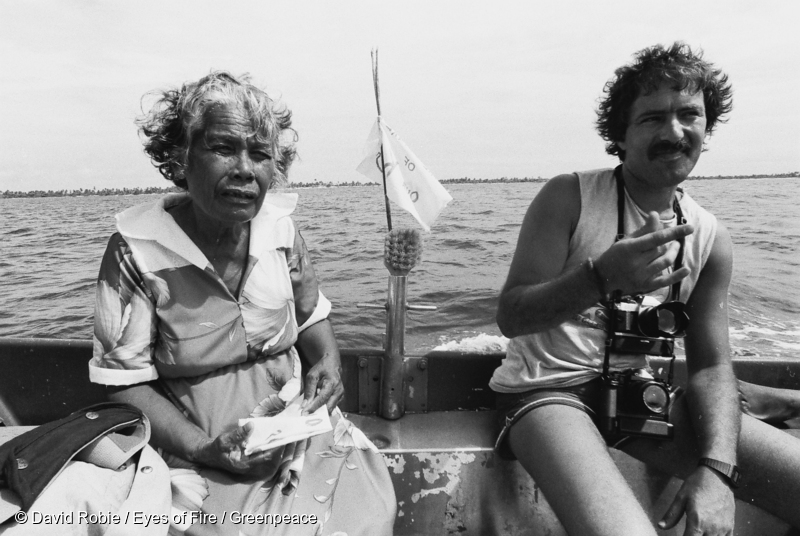
The bombing sparked widespread outrage and intensified global opposition to nuclear testing. It was the only time that a foreign government (supposedly an ally) has ever carried out a terrorist attack in Aotearoa. The nation was shocked.
Shortly after, on 26 July, eight countries signed the South Pacific Nuclear Free Zone Treaty in Rarotonga at the end of the South Pacific Forum heads of government meeting. France was not one of the signatories.
On 25 August, Australian Labour Prime Minister Bob Hawke condemned French nuclear testing and called on the US government to condemn the French government’s recent actions in the South Pacific.
Unbowed, Greenpeace announced in September 1985 that it would send its ice-class Antarctic vessel MV Greenpeace to protest against French nuclear testing at Moruroa Atoll. On 8 October, it made rendezvous with a flotilla of protest boats that had sailed from Aotearoa including Vega, Alliance, Varangian, and Breeze. They stood vigil off Moruroa in opposition to the expected testing ‘season’ to focus international attention and help rally opposition.
Rainbow Warrior crew member Bunny McDiarmid (Aotearoa) was among those on board MV Greenpeace along with Xavier Pastor (Spain), Gerd Leipold (West Germany) and Franck Charriere (France). Veteran Chris Robinson (Australia) was once again skipper on Vega accompanied by Rainbow Warrior skipper Pete Wilcox (USA) and crew member Grace O’Sullivan (Ireland) plus Tihema Galvin of Te Arawa (Aotearoa) and Sue Ware (Aotearoa). Jim Cottier (UK/Aotearoa), a veteran crew member from Tamure in 1972, was skipper of Breeze with crew members Turi Blake and Alice Heather (Aotearoa), seasoned Rainbow Warrior and Vega radio operator Lloyd Anderson (USA) was on board Varangian, and Ranga o Te Aupouri (Aotearoa) was on board Alliance, a yacht supported by the Waikehe Peace Group.
At the same time, the Evangelical Church of Polynesia reaffirmed its strong opposition to the tests and Fiji’s Prime Minister Ratu Sir Kamise Mara once again condemned the tests.
Then, on 24 October, the French military seized Vega as it sailed inside the 20km military exclusion zone and held it at Moruroa.
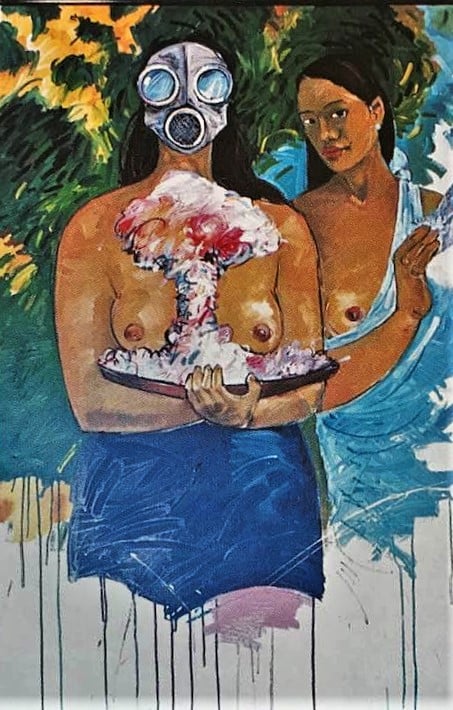
On 3 March 1986, there was a rally against nuclear testing to mark Bikini Day in Faa’a in Tahiti and then on 29 June 1986, Faa’a was declared a Nuclear Free Zone, the most populous commune in Tahiti.
After a 1986 United Nations arbitration process, the French government agreed to pay US$8.16 million in compensation to Greenpeace to replace the Rainbow Warrior, and a much smaller compensation amount to Fernando Pereira’s wife, their two young children, and his elderly parents.
Greenpeace announced it would use the funds to build a replacement Rainbow Warrior and to continue to operate its boats in the Pacific, to fund a programme of ecological projects in France aimed at identifying and implementing solutions to environmental problems, and to give part of the funds to the people of Rongelap in the Marshall Islands.
On 9 October 1986, Vanuatu Prime Minister Walter Lin̄i condemned the Australian government’s decision to resume its uranium sales to France, and on 15 March 1987, 1200 people marched in Pape’ete in support of a Nuclear Free and Independent Pacific.
The next year, on 13 April, an anti-nuclear Labour government was elected in Fiji which was followed by the new prime minister Timoci Bavandra publicly stating that Fiji would ban all nuclear ship visits, just as Nuclear Free New Zealand had done since 1984. One month later on 14 May 1987, there was a military coup d’etat in Fiji led by US-trained Sitiveni Rabuka which deposed the democratically elected Labour government. As a result, there was no Nuclear Free legislation banning nuclear ship visits to Fiji.
Meeting in Samoa 20-30 May, the South Pacific Forum heads of government meeting yet again called for an end to French nuclear testing. A few weeks later, on 8 June 1987 New Zealand’s Nuclear Free Zone law entered into force after a de facto ban on all nuclear ship visits since 1984.
On 23 October 1987, workers at Moruroa refused orders to go to designated ‘safety’ platforms during a nuclear test. Dock workers in Pape’ete also refused to handle cargo to and from Moruroa and occupied an area near the capital. French riot police fired tear gas canisters and smoke grenades at them to break up the strike. Larger riots broke out in Pape’ete’s downtown waterfront and CBD areas. During clashes with riot police, fires broke out and there was looting. This became known locally as the ‘Tahiti Bomb’, triggered by two decades of nuclear testing and deepening inequality following the large influx from metropolitan France of highly-paid French military personnel since the tests began.
On 12 December 1987, the Rainbow Warrior was buried at sea in a ceremony off the Cavalli Islands in Matauri Bay, Aotearoa, where it has since become a living reef for scuba divers to explore.
In April 1988, Sitiveni Rabuka, leader of the 1987 coup in Fiji, signed a deal for $AU18 million with France, which was thought to have disuaded Fiji’s official criticisms of French nuclear testing. This was followed in January 1989 by a US$7.2 million loan from France to Fiji.
On 1 March 1989, 2000 people rallied in Pape’ete on NFIP day against nuclear testing and demanding a health survey.
On 2 July 1989, on the anniversary of the first test at Moruroa in 1966, 15 members of Oscar Temaru’s anti-nuclear pro-independence party Tāvini Huiraʻatira (‘Serve the People’) started a hunger strike outside the cathedral in Pape’ete demanding a referendum on nuclear testing. The strike ended on 12 July, the bicentenary of the French Revolution. A leaflet handed out said: “Since nuclear testing began in the land of the Mā’ohi, the people have never been consulted. Practically all our political, religious and trade union leaders have reputedly called for the testing to STOP. Today we note that nothing has been done.”
On 30 July 1989, Brice Lalonde, now the Environment Minister in Paris (after having once taken part in protests against nuclear testing in 1973 and 1981) was quoted in the French media defending the state of the environment at Moruroa Atoll. Like Regis Debray before him, he had become a well-paid Parisian apologist for French nuclear testing.
On 2 August 1989, French prime minister Michel Rocard visited Fiji and announced US$5.4 million in military aid and awarded Fiji coup leader Sitiveni Rabuka a medal. Rabuka didn’t mention nuclear testing.
In Tahiti, 400 protestors affiliated with Tāvini Huiraʻatira carried anti-nuclear testing and pro-independence banners and placards while blocking the main road from the airport into Pape’ete. Two hundred armed French gendarmes broke up the protest but they soon regrouped and began a sit-in protest awaiting Rocard’s arrival during the night.
On 27 August, Cook Islands Prime Minister Geoffrey Henry visited Tahiti to meet French Prime Minister Rocard. Henry declared that he thought French nuclear testing was now a “non-issue” and negotiated a US$5.7 million French government loan with Rocard. The money seemed to obscure for him the fact that French nuclear weapons testing was a blatant breach of the South Pacific Nuclear Free Zone Treaty that had been signed in Rarotonga in 1985.
From 5-13 March 1990, the NFIP network organised a week of protests against French nuclear testing, including a hunger strike by Tahitians.
Then on 6 April 1990, Fiji coup leader Sitiveni Rabuka announced that France would finance a new $12.5 million military maintenance base in Suva. Once again, he didn’t mention nuclear testing.
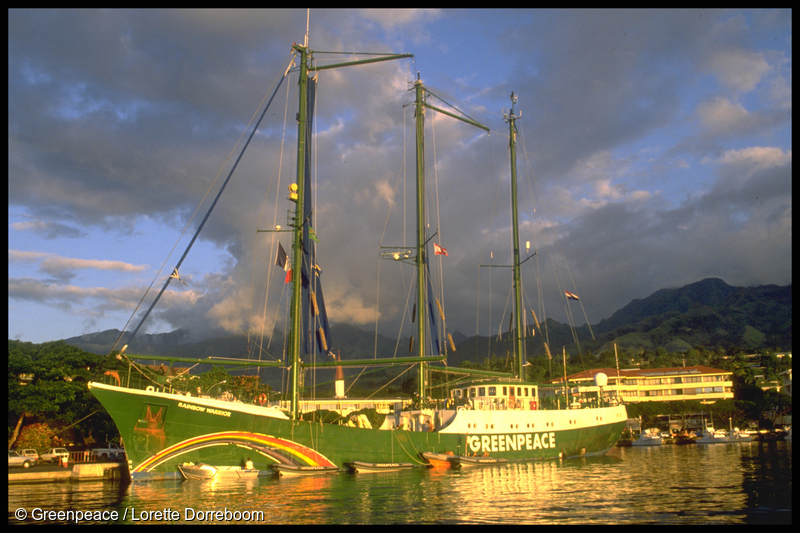
The Rainbow Warrior returns to Tahiti and Moruroa
The new SV Rainbow Warrior II visited Pape’ete 7-13 May 1990 on an educational mission to inform the public about a wide range of environmental issues from coral bleaching caused by global warming and the benefits of solar power to nuclear testing and radioactive contamination. Two thousand people visited the boat over two days. While she was in port, 20 members of Tāvini Huiraʻatira and TA member James Salmon maintained a presence next to the Warrior with a banner calling for an end to nuclear testing and independence from France.
On 10 July 1990, Oscar Temaru and Greenpeace’s new Nuclear Test Ban Campaigner Stephanie Mills commemorated the fifth anniversary of the bombing of the Rainbow Warrior outside the French Embassy in Wellington. They laid a wreath outside that read “Fernando Pereira, murdered 10 July 1985” and called on the French government to end the nuclear tests.
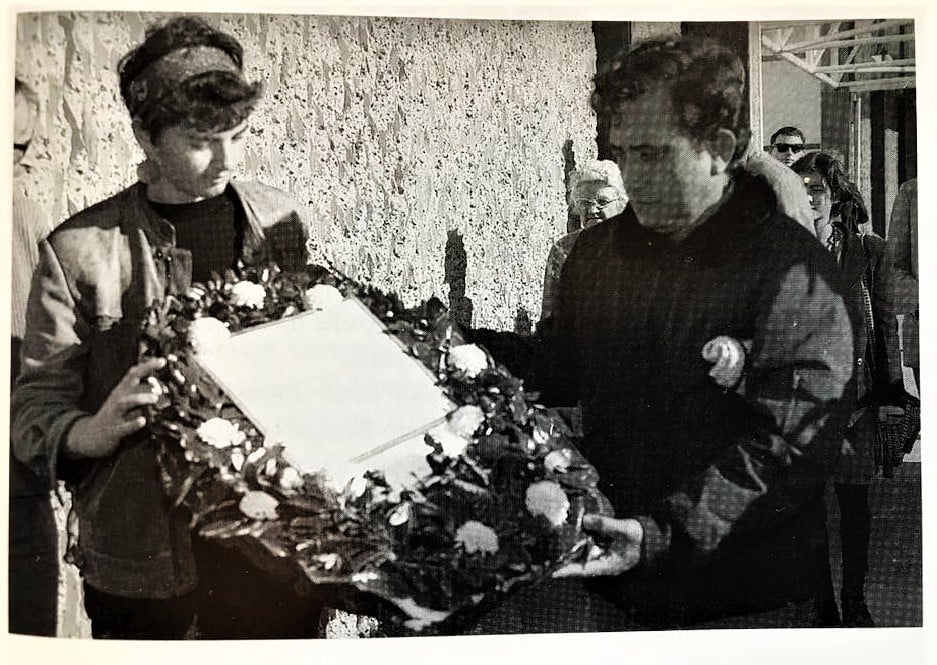
Stephanie Mills had been active in the peace movement as a student in Wellington in the 1980s. After working as a reporter for the NZ Herald, she moved to London where she worked as the Press Officer for the Campaign for Nuclear Disarmament at its National Office in London. In 1990, she returned to Auckland to work for Greenpeace.
On 15 July 1990, Greenpeace Aotearoa staff and supporters joined with Ngāti Kura at the unveiling of a new Rainbow Warrior Memorial at Matauri Bay in Northland along with Labour Prime Minister Mike Moore. The memorial created by Kiwi sculptor Chris Booth was unveiled by NZ Governor-General Sir Paul Reeves. Since the permanent memorial was unveiled there, commemorative events have been held at Matauri Bay, including on the occasion of visits of SV Rainbow Warrior II there in 1995 and 2005, and Rainbow Warrior III in 2013 and 2018.
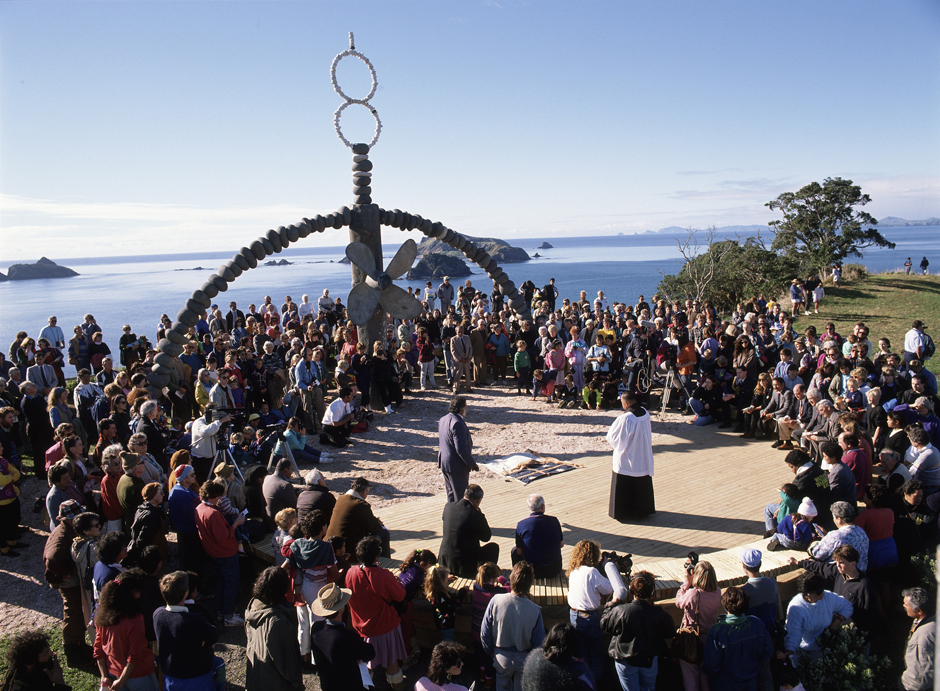
Later, in April 2025, Greenpeace Aotearoa crew and staff members from Auckland visited Matauri Bay again to reconnect with the land and Ngāti Kura, and to help with maintenance of the track leading up to the memorial.
On 31 August 1990, American scientist Norm Buske published a new report that included a re-analysis of the data from the report of a 1987 mission to Moruroa Atoll led by French oceanographer Jacques Couteau. The report revealed that, “water in Moruroa lagoon is contaminated with Caesium-134 and Caesium-137 leaking from underground tests.” The report concluded that the time required for radioactive leakage to reach the open environment was less than six years after an underground explosion.
In October 1990, the South Pacific Forum heads of government meeting once again called for an end to French nuclear testing and requested that Greenpeace circulate the new Buske report to all Forum governments.
Greenpeace’s campaign against the French testing programme continued through the early 1990s, including SV Rainbow Warrior II expeditions to the test site at Moruroa Atoll and a ten-week tour of Tahiti Nui by the small yacht Redbill in 1991 to meet with local communities there to discuss a range of environmental issues including the impacts of nuclear testing and climate change.
Greenpeace also published several reports including the testimonies of workers and civilians affected by radioactive contamination from the French nuclear tests (See: Testimonies: Witnesses of French Nuclear Testing in the South Pacific, August 1990, Andy Biederman and Stephanie Mills), a chronology of the nuclear testing programme (See: Chronology: The French Presence in the South Pacific 1838-1990), Julie Miles and Elaine Shaw, 1990), and the results of Greenpeace’s own environmental sampling work at sea off Moruroa Atoll through this period.
The core Greenpeace French nuclear testing campaign team in Aotearoa during the 1990s was Stephanie Mills, Bunny McDiarmid, Martini Gotje and Michael Szabo. At Greenpeace International in the Netherlands it was Steve Sawyer, Rémi Parmentier and Gerd Leipold, at Greenpeace France Jean-Luc Thierry, Alain Connan, Penelope Komites and Arnaud Apoteker, at Greenpeace USA Sebia Hawkins and Harvey Wasserman, at Greenpeace UK Rebecca Johnson and Janet Convery, at Greenpeace Japan Naoki Ohara and Sanai Shida, at Greenpeace Australia Jean McSorley and Ben Pearson, at Greenpeace Russia Dima Litvinov, at Greenpeace Spain Xavier Pastor, and at Greenpeace Communications in London Blair Palese and Elisabeth Mealey.
Ella Henry, Rob Taylor, Kirsty Hamilton, Grant Pakihana Hawke, Catherine Delahunty, Nicola Easthope and Carola Warner organised protest actions and campaign activities in Aotearoa in 1995/6, Glyn Walters (NZ) and Susan Cavanagh (Australia) worked on media liaison, and Janet Dalziell and Lynette Thorstenson organised logistics in Pape’ete.
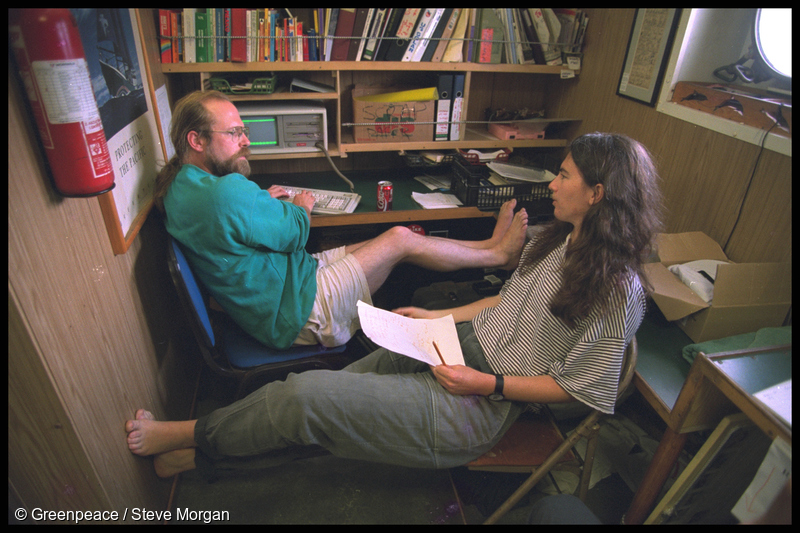
SV Rainbow Warrior II skippers during this period included Pete Wilcox, Jon Castle, Joel Stewart, Dave Enever and Derek Nicholls, Vega and Fand skippers included David McTaggart, Henk Haazen, Steve Sawyer, Chris Robinson and Daniel Mares, and the Redbill skipper was Peter Malcolm.
Greenpeace’s Pacific Campaign team included Alice Heather, Tamsin Vuetilovoni, Pia Mancia, Maureen Penjueli, Anj Heffernan, Nainasa Whippy, Julie Miles and Libby Giles, and crew members on the various Greenpeace boats operating in the Pacific included Philip Pupuka, Remuna Tufaruia, Chris Shigetomi, Tino Tetuanuitefarerii, Alice Leney, Madeleine Habib, Kate Lecchi and Tania Popp.
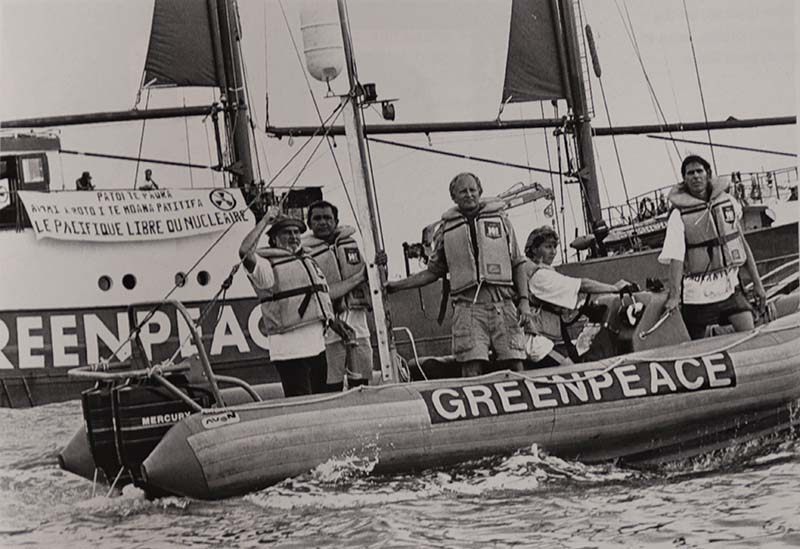
SV Rainbow Warrior II visited Pape’ete again in December 1990 before sailing on to Moruroa where she was closely shadowed by three French navy warships. American scientist Norm Buske and Kiwi scientist Bruce Gabites were on board to take sea water and plankton samples just outside the 20km military exclusion zone off Moruroa and to measure the local sea currents.
During their analysis of the samples they collected at sea on board SV Rainbow Warrior II, they found radioactive Caesium-134 and Cobalt-60 in plankton, both isotopes being by-products of a nuclear explosion. This was evidence that confirmed Moruroa Atoll was leaking radioactivity into the seas around it and that it was entering the marine food chain.
When the two scientists tried to repeat their plankton sampling their inflatable boat was shadowed by the French Navy frigate Lavalee, which deployed 40 commandos in four high speed boats to seize the Greenpeace scientific team and forcibly remove them to the French frigate for interrogation. They were then taken to the military base on Moruroa and held there incommunicado and under military guard for three days.
While the scientific team was detained at Moruroa, Greenpeace France activists scaled Notre-Dame Cathedral in the centre of Paris to hang a large banner calling for an end to nuclear testing, and a Greenpeace delegation visited the Ministry of Defence demanding to see French Defence Minister Jean-Pierre Chevènement. There were also protests outside French embassies in New Zealand, Australia, USA, and Canada calling for an end to the tests and the immediate release of the scientific team.
A large anti-nuclear testing protest rally was also organised in Pape’ete. SV Rainbow Warrior II returned to Pape’ete to join the protest rally. Shortly after that, the boat sailed to Auckland to get the samples to a NZ laboratory for further analysis and storage.
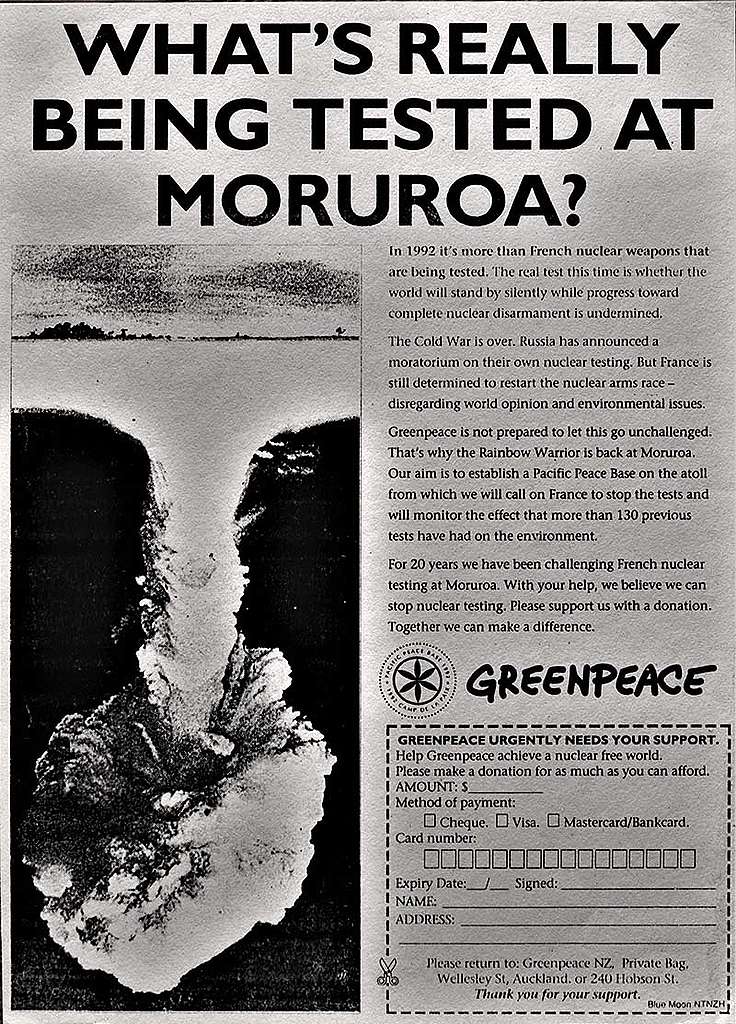
France joins the nuclear testing moratorium
When SV Rainbow Warrior II returned to the French military exclusion zone at Moruroa on 27 March 1992, five French navy warships, two helicopters, and dozens of masked commandos tried to stop the boat from reaching Moruroa Atoll. A second Greenpeace boat, Fand, sailed from Aotearoa to Moruroa, arriving there at the same time as SV Rainbow Warrior II.
“I sailed from New Zealand to Moruroa on Chris Robinson’s yacht Fand in 1992 with Chris Robinson, Lloyd Anderson – who was our radio operator on the original Rainbow Warrior in 1985 – and Kitty Rangimaire Smith,” recalls skipper Henk Haazen. “There were some other boats that set out but SV Fand was the only one to reach Moruroa and rendezvous with SV Rainbow Warrior II there. Chris had built SV Fand to the same plans as SV Vega.”
“The campaign publicly announced that Greenpeace would attempt to land on the atoll and establish a Moruroa Peace Base, urging France to stop testing and allow a full independent international scientific assessment of radioactive leakage into the lagoon,” recalls Stephanie Mills, who Greenpeace’s Nuclear Test Ban Campaigner on board at the time.
After a 90-minute high speed chase, the French armed forces arrested Greenpeace’s inflatables and landed 20 commandos aboard SV Rainbow Warrior II who took control of the boat.
“Our voyage, timed to coincide with elections in France, also forced a new political response there. French Environment Minister Brice Lalonde called on his own government to take an initiative to the Earth Summit to end nuclear testing. The French Green Party, fresh from success in the elections, also whole-heartedly endorsed our campaign,” said Stephanie Mills.
Two weeks after the arrest of SV Rainbow Warrior II and the expulsion of crew members and campaigners on board, French President Francois Mitterand announced that France would join the moratorium on nuclear weapons testing that had been declared by Soviet President Mikhail Gorbachev in October 1991. The US and Britain then joined the moratorium the next year and progress started to be made towards agreement on a Comprehensive Test Ban Treaty through the UN.
(See: Greenpeace magazine, Aotearoa, Issue 75, September 1995; pers comm, Stephanie Mills, June 2020; pers comm, Henk Haazen, June 2020).
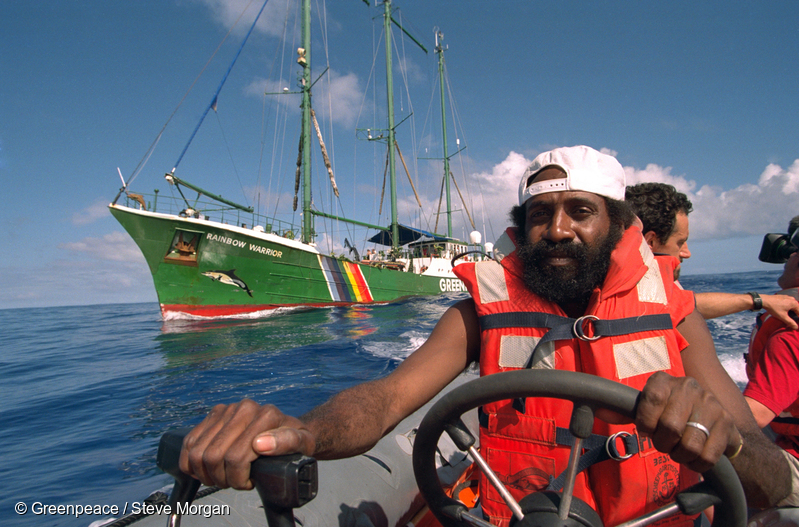
France resumes nuclear testing
The moratorium remained in place for three years but was derailed by two events in May 1995. The first was the “indefinite extension” of the 1968 nuclear Non-Proliferation Treaty at a conference at the UN in New York, but without any requirement for the five declared nuclear weapons states to undertake nuclear disarmament as set out in the original treaty. Greenpeace’s Test Ban Coordinator Stephanie Mills had been at the conference as an NGO observer, where it was rumoured that France might now seek to resume nuclear testing so Greenpeace moved quickly to make contingency plans.
The second was the election of Gaullist politician Jacques Chirac to the French Presidency after the end of Francois Mitterand’s second term in office. Chirac had been an aide of French President Georges Pompidou in the 1970s and was from the more conservative side of French politics.
Soon after his election he announced that France would resume its nuclear weapons testing programme. He said there would be a series of eight nuclear tests at Moruroa and Fangataufa atolls between September 1995 and May 1996.
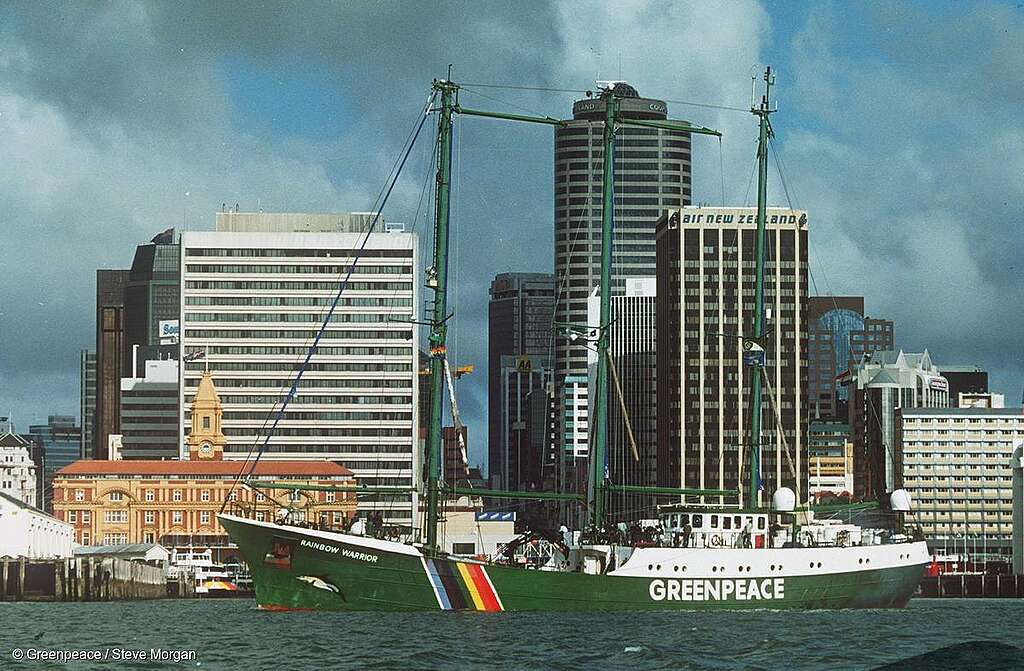
Shortly after that, on 13 June, Greenpeace was ready to hold a media conference on board SV Rainbow Warrior II in Auckland to announce it was sending its flagship to Moruroa to protest against the resumption of nuclear testing.
Nuclear Test Ban Campaign Coordinator Stephanie Mills told reporters, “There is no doubt that the international community is united in condemning any resumption of the French Government’s nuclear weapons testing programme.”
Greenpeace Campaign Manager in Aotearoa, Michael Szabo, called on the NZ government to send a naval vessel to protest at the nuclear test site, take a new case to the International Court of Justice opposing the tests, and use its position within the UN to call for an end to nuclear testing and a ban the production of all plutonium and highly enriched uranium for nuclear warheads.
Greenpeace France Nuclear Campaigner Jean-Luc Thierry said, “The Rainbow Warrior sails on behalf of millions of ordinary people all over the world – including a majority of the French people – who want an end to nuclear testing now. By bearing witness at Moruroa, Greenpeace aims to ensure that President Chirac cannot ignore our pleas to rid the world of the nuclear threat.”
At the same time, an emergency resolution was tabled in the European Parliament urging France not to break the three-year moratorium on nuclear testing, and the governments of the South Pacific Forum member states and Chile formally protested against any resumption of nuclear weapons testing.
The warheads that France planned to test were the 110-kiloton TN75 and the 200-kiloton TN100 for France’s new M51 submarine launched ballistic missile, designed to carry 6-10 warheads per missile, and the air-launched ASLP cruise missile, designed to carry one warhead per missile.
That day, SV Rainbow Warrior II sailed to Matauri Bay in Northland where a commemorative service was held the next day at the site where the original Rainbow Warrior was laid to rest in 1987. Ngāti Kura and the Rev. Nuku Stewart of Matauri Bay were joined by original crew members Steve Sawyer and Henk Haazen, the crew of SV Rainbow Warrior II, Greenpeace Executive Director in Aotearoa Ella Henry, Iwi Liaison Grant Pakihana Hawke, Test Ban Coordinator Stephanie Mills, Campaign Manager Michael Szabo, and Greenpeace France Campaigner Jean-Luc Thierry.
After the service led by Rev. Nuku Stewart and the laying of a wreath on the water, SV Rainbow Warrior II set sail for Rarotonga and Tahiti.
(See: “Rainbow Warrior sails for Moruroa test site as pressure mounts on France”, 13 June 1995, Greenpeace news release; “The resumption of French nuclear testing”, Keith Suter, Medicine and War Journal, Volume 11, 1995, Issue 4.)
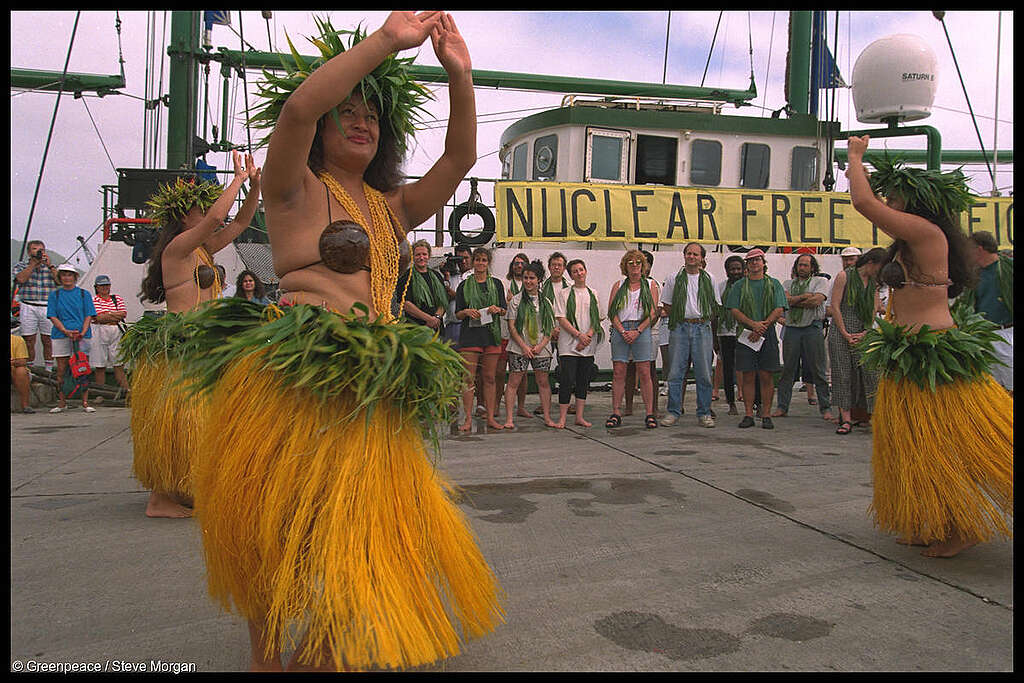
The Rainbow Warrior arrives in Rarotonga
Arriving in Rarotonga on 21 June, the crew of SV Rainbow Warrior II joined the Cook Islands Nuclear-Free Pacific march.
The crew marched with more than 1,500 Cook Islanders in the country’s largest ever protest march in the capital, Avarua, calling for a “Nuclear-Free Pacific” on 23 June. The march attracted almost 20 percent of the population of Rarotonga.
The route of the march went from SV Rainbow Warrior II to the town centre. It had been called by Cook Islands Sir Prime Minister Geoffrey Henry and was led by Cook Islands traditional leaders. Oscar Temaru, Mayor of Faa’a, was also at the head of the march. In a full-page ad in the Cook Islands News Prime Minister Sir Geoffrey Henry had invited Cook Islanders “to march for Peace and a Nuclear Free Pacific” and express support for Greenpeace’s Rainbow Warrior campaign.
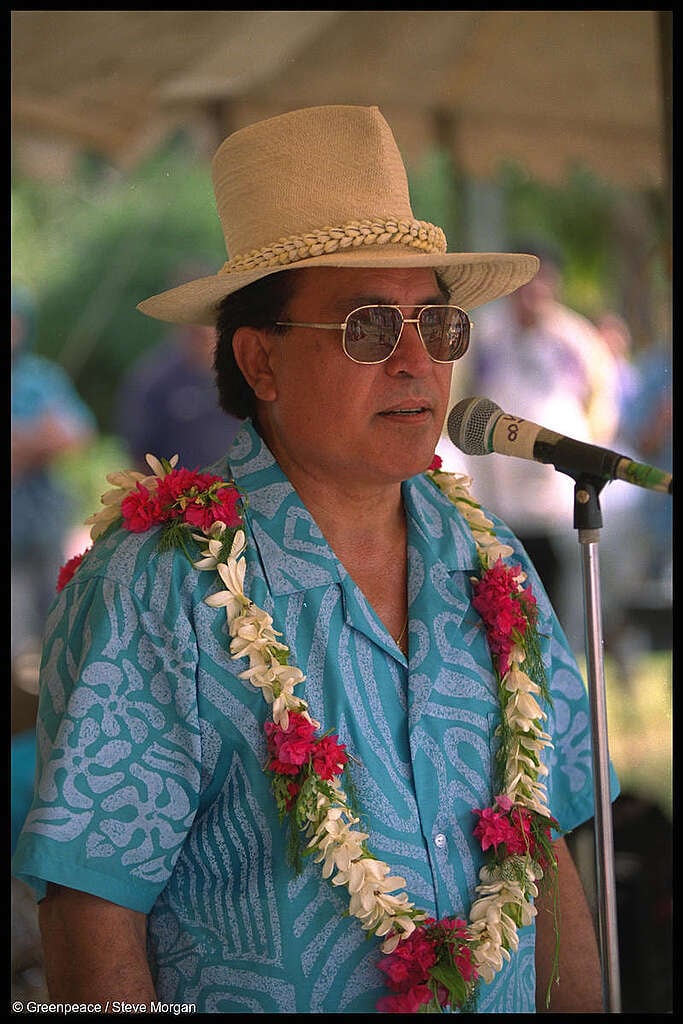
Stephanie Mills also met with Sir Geoffrey Henry and welcomed the Cook Islands government’s strong stand against the nuclear tests and to offer Greenpeace’s strong support for the vaka Te-Au-O-Tonga that would be joining the protest at Moruroa.
Greenpeace had also approached the Taporoporoanga Ipukarea Society’s Jolene Bosanquet and others about the possibility of the “Pacific Peace Flotilla” visiting Rarotonga to pick up supplies before heading on to Moruroa. The answer was an enthusiastic ‘yes’ and containers of supplies soon arrived at Avatiu Harbour. Harbour master Captain Don Silk ‘shoehorned’ as many boats into the harbour as he could and the Flotilla crews were able to stop briefly and go ashore before the long sail on to Moruroa.
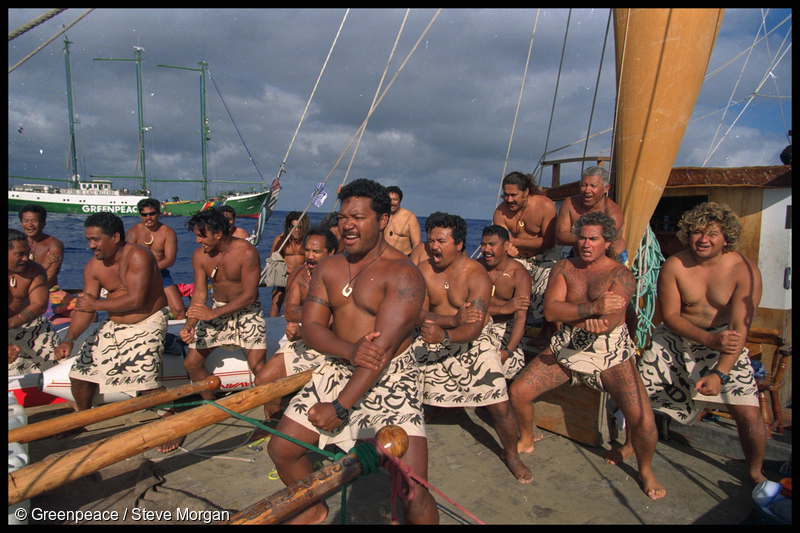
Te-Au-O-Tonga vaka to Moruroa
An indigenous Vaka ki Moruroa (Vaka to Moruroa) campaign persuaded the Cook Islands government to support sending the 20-metre double-hulled vaka Te-Au-O-Tonga to join the Flotilla protest at Moruroa.
Prime Minister Sir Henry Geoffrey asked vaka captain Tua Pitman if his crew would lead a peaceful protest so soon after they had returned from a long voyage to Hawai’i and back. “I went back to the crew and said look, there’s a voyage coming up and we need to go and represent our people,” says Tua Pitman. “Everybody said ‘yes let’s go’ … we were going into unknown territory and we weren’t sure of the threats that would be out there. We were right in the firing line.”
“We are sending the vaka not because it’s aggressive or a threat to France,” said Brian Mason of the Vaka ki Moruroa campaign committee, but rather “because it’s so utterly harmless and vulnerable.” The Cook Islands News described it as, “… a David and Goliath situation.”
The vaka left Rarotonga in mid-August amid an emotional farewell from family and friends. The crew faced strong headwinds and turbulent seas, and ran the gauntlet of French warships and military aircraft harassing them en route. The vaka reached the 20-kilometre military exclusion zone around Moruroa to rendezvous with SV Rainbow Warrior II on 30 August. The crew of Te-Au-O-Tonga faced towards Moruroa Atoll and performed pe’e (traditional chants), “urging the French to take their bombs away”.
When the pro-nuclear testing President of French Polynesia, Gaston Flosse made a scheduled official visit to Rarotonga on 7 August, 500 Cook Islands protestors met him at the airport to show their opposition to the tests. Felix Enoka was among them, having joined the boycott of the upcoming South Pacific Games that were due to be held in Tahiti a few weeks later. Preparing for Flosse’s visit, Enoka, Tim Arnold, and two others climbed Maungatea above Avarua to hang a big banner that read “Nuclear-Free Rarotonga”. Travis Moore and Jolene Bosanquet also fly-posted handbills on every lamp post around the capital Avarua which read, “Gaston Flosse, leave us as you found us – Nuclear-Free”.
Later, when the Cook Islands’ national seismic monitoring station detected the first nuclear test explosion in the South Pacific since 1991. Felix Enoka said he felt devastated: “I was thinking no, it can’t be true… it’s hard to believe.” He had announced at a press conference the week before that if the French nuclear tests proceeded, he would burn a French flag at Rarotonga’s World War I memorial Cenotaph dedicated to the 500 Cook Islands soldiers who helped defend France.
Hundreds of people came to the Cenotaph to watch as Enoka, dressed as a traditional Cook Islands warrior and surrounded by military veterans, touched a flaming torch to a French flag. The Cook Islands News described how the ‘pent-up emotions’ of ‘anti-test anger’ produced an ‘instant reaction from the crowd, with a wave of shouting and jeering joining the drumbeats as the tricolour was reduced to ashes … People fed paper flags to the flames, venting their frustration at France ignoring the pleas of Polynesian, Pacific and global protest’.”
(See: “Remembering turbulent times in Pacific history”, Cook Islands News, 26 September 2015; “As Trump mulls new US nuclear tests, we can learn from a small country’s resistance to the Bomb”, Just Security, Mathew Breay Bolton and Jean Tekura Mason, 25 June 2020; Greenpeace magazine, Aotearoa, Issue 75, September 1995; pers comm, Stephanie Mills, June 2020; pers comm, Henk Haazen, June 2020).
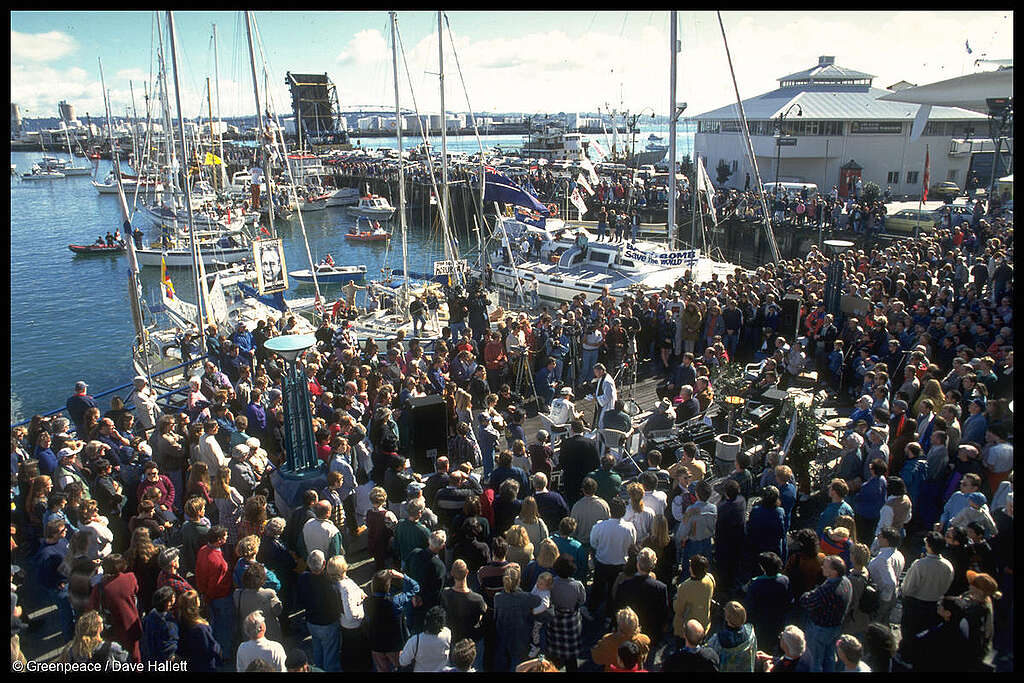
The ‘Pacific Peace Flotilla’ assembles to join the protests at Moruroa
On 25 June 1995, an interview with former Greenpeace International Executive Director David McTaggart, who had skippered the first protest yacht (Vega/Greenpeace III) to sail from Aotearoa to Moruroa Atoll in 1972, was broadcast by TVNZ’s 60 Minutes programme.
At the end of the interview, he urged people to join SV Rainbow Warrior II’s protest at Moruroa. The next day, Manukau City councillor Barry Keon was interviewed by Radio New Zealand and he announced that he would sail his trimaran, Triptych, to join the protest at Moruroa.
Soon after that, more boats and crews from around Aotearoa came forward. A grassroots fundraising network sprang up which gathered money for the new ‘Pacific Peace Flotilla’ from individual donations and the sale of artworks. The Body Shop collected $5,000 in donations and various local shops and some companies donated food supplies to them.
Triptych and several other yachts gathered to depart from the Auckland Basin Viaduct on 6 August 1995, the 50th anniversary of the US bombing of Hiroshima, where thousands of people gathered to give them a rousing send-off. Three more yachts – Chimera, Joie and New Zealand Maid – sailed from Wellington on 24 August.
A total of 32 yachts and boats from 12 countries took part in the Flotilla, including SV Rainbow Warrior II, MV Greenpeace, Vega, Manutea (USA), Bifrost (Denmark), R. Tucker Thompson, Photina, Joie, Kela, New Zealand Maid, Triptych, Te Kaito, Chimera (Aotearoa), Bebinka (Chile), Caramba, and Maccias (USA).
In Aotearoa, Australia, France, and the rest of the world, Greenpeace offices and national peace movements helped to organise land-based protest activities outside French embassies and within France itself.
Claudia Pond-Eyley’s book ‘Protest at Moruroa’ (Tandem Press, 1997) contains eyewitness accounts from skippers and crew from various of the Greenpeace boats and Flotilla yachts.
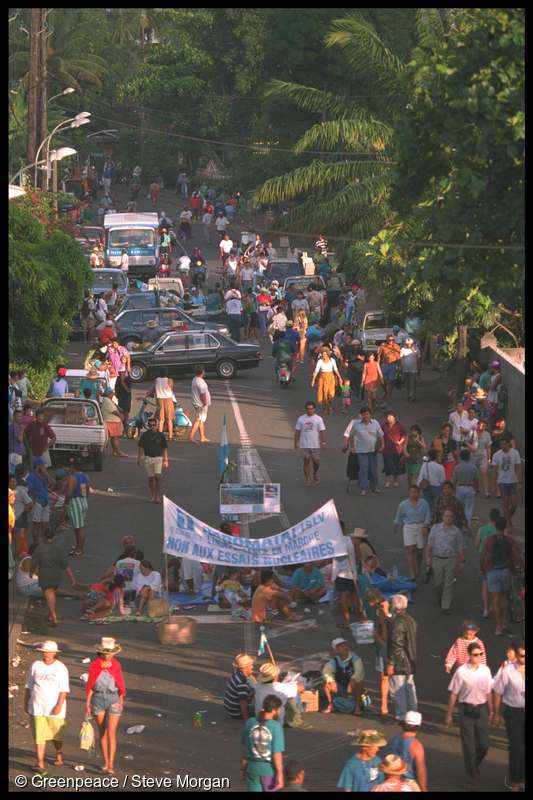
15,000 welcome Oscar Temaru and the Rainbow Warrior to Tahiti, march against oppose nuclear testing
SV Rainbow Warrior II arrived in Tahiti on 29 June, when 15,000 people rallied in Pape’ete, the capital, to welcome Tahitian anti-nuclear leader Oscar Temaru and the crew of the Warrior, and to protest against the nuclear weapons tests at Moruroa. The rally was organised by Oscar Temaru’s anti-nuclear and pro-independence Tāvini Huiraʻatira movement.
“This was the biggest ever mass protest in Tahiti,” recalls Stephanie Mills. “The protestors blocked the roads into Pape’ete and brought it to a standstill for three days, demanding a referendum in French Polynesia to decide if the tests should be allowed to go ahead or not. Public opinion was deeply opposed to the tests resuming.”
“This was a serious challenge to the power of the French authorities there. Pape’ete itself has a heavy military presence with a fleet of large warships based in the port and large numbers of uniformed French military on the streets of the capital.”
“And there was SV Rainbow Warrior II, the replacement boat for the original Rainbow Warrior – the Greenpeace ship that the French Government’s DGSE agents had bombed in Auckland Harbour ten years before – now acting as a focal point for mass protest in Tahiti.”
“Tahitians had not been asked if they wanted the nuclear tests to resume and the march was a very clear expression of the depth of their opposition.”
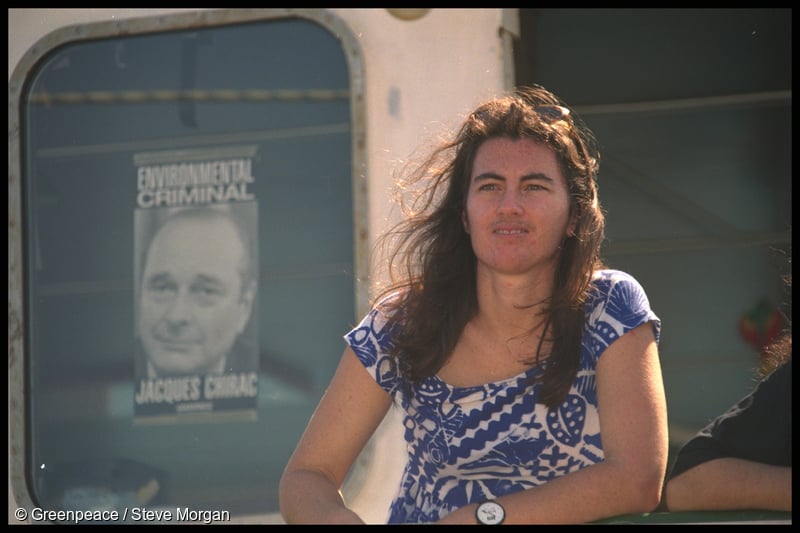
Speakers during the march included Oscar Temaru (Mayor of Fa’aa), Greenpeace France Nuclear Campaigner Jean-Luc Thierry, and French Bishop Jacques Gaillot (Diocese of Évreux, Normandy).
The French-owned Pape’ete newspaper Le Depeche was relentlessly anti-Greenpeace, including publishing a cartoon portraying Greenpeace as a ‘Pied Piper’ figure mesmerising Tahitians into becoming anti-nuclear ‘zombies’ marching through the streets.
Afterwards, SV Rainbow Warrior II set sail from Pape’ete and headed back to Moruroa.
(See: Greenpeace magazine, Aotearoa, Issue 71, September 1995; pers comm, Stephanie Mills, June 2020; Thousands march against French nuclear testing in the Pacific, Australian Broadcasting Corporation, 3 September 1995).
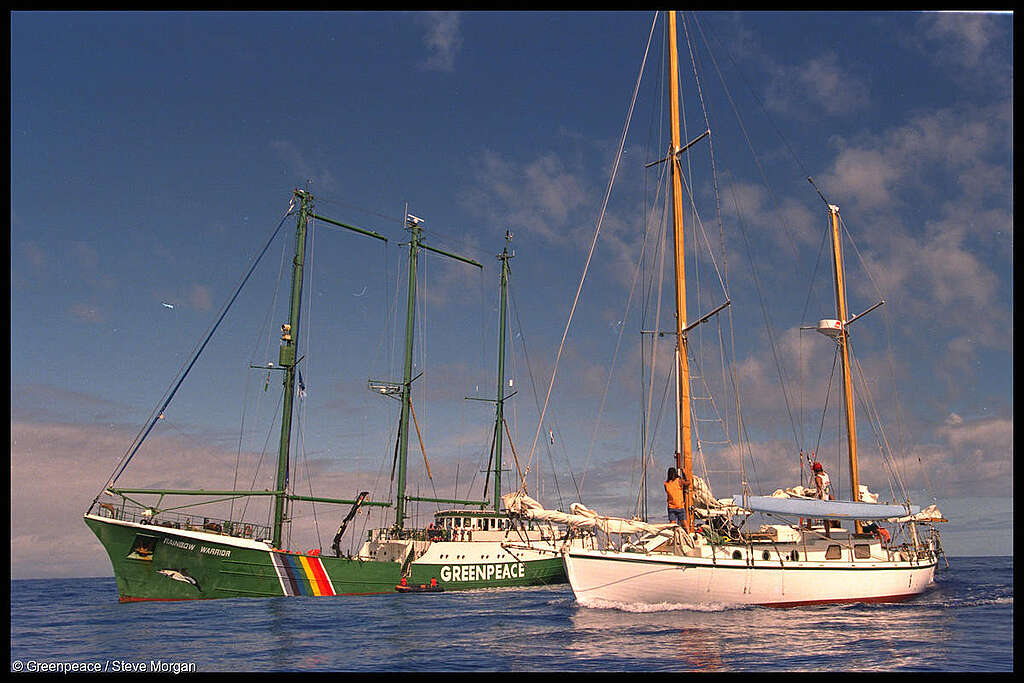
The Rainbow Warrior and Vega rendezvous off Moruroa
SV Rainbow Warrior II arrived off Moruroa on 8 July to rendezvous with Vega. The so-called “fifth inflatable” disappeared into the night for two weeks with David McTaggart, Henk Haazen, and Chris Robinson on board. Steve Sawyer remained on board as skipper of Vega, joined by a few other Warrior crew members.
The goal of the fifth inflatable crew was to evade the French military and hide in the vicinity of Moruroa Atoll for as long as they could in order to disrupt preparations for the nuclear tests. They had food and gear for a prolonged period as well as locator beacons, radiation protection gear, and radio gear.
They succeeded in evading detection at sea and then on the tiny atoll of Vanavana 120km from Moruroa for two weeks, tying up French military resources as they searched in vain for the elusive activists from the air and at sea.
Henk Haazen recalls: “In 1995 I sailed on SV Rainbow Warrior II from New Zealand to Moruroa. We had a great send off from Marsden Wharf with Herbs and the Topp Twins playing live. Then we stopped en route to pay our respects to the original Rainbow Warrior in Matauri Bay, which was very emotional.”
“David McTaggart joined us when SV Rainbow Warrior II stopped in Rarotonga to support the protest march there and take on some supplies. He had come up with a plan to head off in the so-called ‘fifth inflatable’ to the island of Vanavana near Moruroa and to hide there to force the French military to search the area for us as a tactic to help disrupt and delay the tests.”
“Chris Robinson sailed SV Vega from Italy to the Pacific and made rendezvous with us on SV Rainbow Warrior II dead on time.”
“Steve Sawyer and I didn’t agree with one particular aspect of David’s proposed plan, so Steve persuaded David to drop that part.”
“I organised our survival gear and at the appointed time, in the dead of night, we took one of the inflatables from SV Rainbow Warrior II and slipped off and headed to Vanavana, leaving Steve Sawyer to skipper SV Vega with two other crew from SV Rainbow Warrior II.”
“The French military followed SV Vega and didn’t notice that some of us had slipped away in the fifth inflatable. It was a good plan to confuse the French military.”
“When we reached Vanavana we had to navigate over the reef there because there was no pass into the lagoon, then once we landed, we hid the boat under pandanus leaves so it was not visible from the air. Vanavana was used as a fishing area by the people on nearby Tureia. We stayed there in a small hut and had enough gear and food for about a month. While we were there, we dodged the French military spotter planes and had some designated hiding places we could go to when we heard them coming.”
“Steve Sawyer sailed SV Vega over into the general area where we were without getting too close to any one island in the Mangareva group, and we were able to talk with him via VHF radio. He was our exit strategy when we needed it.”
“Eventually we launched the inflatable one night and made rendezvous with SV Vega. Then we sailed to Pape’ete with the fifth inflatable in tow and when we got there the French authorities questioned us because they realised it had been us with the fifth inflatable, but they did not arrest us for anything.”
“After that I went back and joined SV Rainbow Warrior II for a while before re-joining Chris Robinson on SV Vega. Then MV Greenpeace arrived. We sailed on SV Vega to Tureia and picked up David McTaggart again.”
“The second time SV Rainbow Warrior II went into the lagoon at Moruroa [1 September 1995] the French military also seized MV Greenpeace. That left David, Chris and I on SV Vega without a ‘mother ship’.”
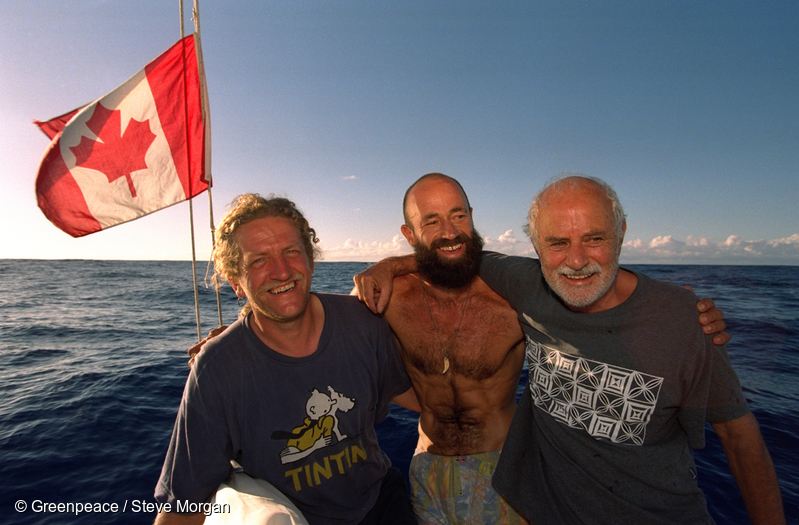
“Three boats arrived carrying journalists from Pape’ete. When they interviewed David McTaggart, he told them the first of the Flotilla boats were on their way and could be there any moment. Just then, we saw a small sail coming towards us. It was a small 35-foot yacht that had been sailed single-handed from Chile. None of us knew it was coming or who the skipper was or where he was from. He had painted ‘No Testing’ on the sail and had been at sea on his own for at least a month. David said, ‘look, there’s the first boat’. It was magic. You couldn’t have planned it!”
“The journalists had their story and more of the Flotilla boats soon joined us, having sailed from NZ, Australia, Fiji, Tahiti, Rarotonga, and in the case of SV Manutea, the USA.”
“Lyn Pistol was there at Moruroa the longest. Nick Gales was there with his family too, as well as Peter Williams. Two boats joined us from Fiji and SV Maccias acted as a resupply boat out of Pape’ete, organised by Janet Dalziell.”
“At one time, fifteen of the 30 Flotilla boats that arrived at Moruroa headed into the military exclusion zone, then we sailed back out and we sent an inflatable in to protest each time we thought there would be another nuclear test.”
“SV Vega sailed to Tureia again and picked up six of the Tureians who owned Moruroa before it had been occupied and taken over by the French military in the early 1960s. We re-joined the Flotilla and I transferred onto SV Manutea, the boat that had been chartered by Greenpeace USA that acted as the Flotilla’s ‘support vessel’ after the seizure of SV Rainbow Warrior II and MV Greenpeace.”
“David McTaggart and Chris Robinson went into Moruroa with the Tureians where they got arrested.”
“In the end I went into Fangataufa on an inflatable with Sanai Shida of Greenpeace Japan to try to stop one of the tests. We were arrested there and flown to Pape’ete, and then deported to New Zealand.”
“The original idea for the Flotilla came from when SV Vega sailed to Moruroa in 1972 accompanied by several other yachts and the SV Fri did the same in 1973, so we continued that tradition.”
(See: ‘The Storming of the Rainbow Warrior’, Greenpeace magazine, Aotearoa, Issue 71, September 1995; pers comm, Henk Haazen, June 2020)
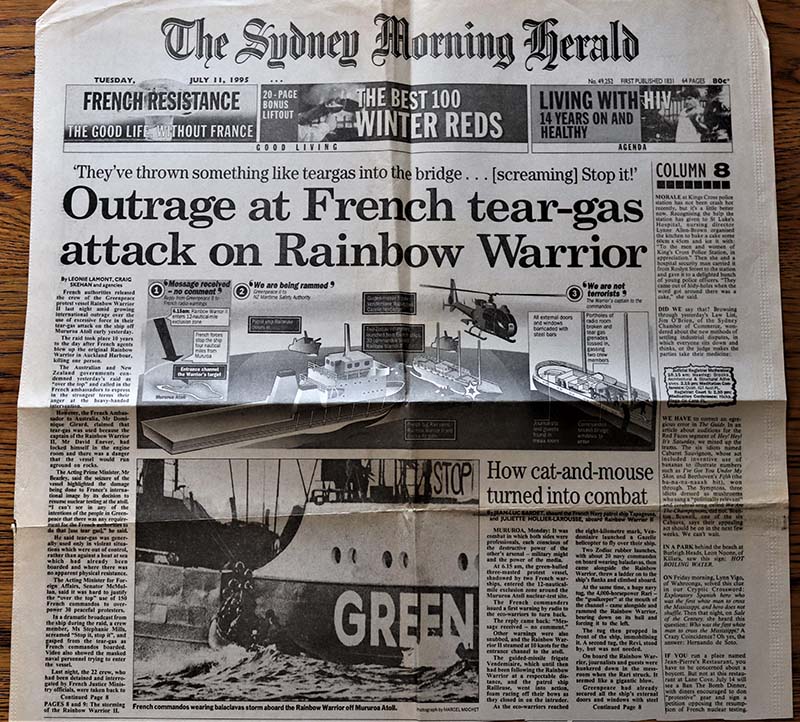
French commandos storm the Rainbow Warrior on 10 July 1995
A few days later, the world watched as dramatic events unfolded on 10 July 1995, the tenth anniversary of the bombing of the original Rainbow Warrior by French DGSE agents in Auckland.
SV Rainbow Warrior II and four inflatable boats sailed into the lagoon at Moruroa at 5am local time. The date was 9 July in Tahiti but because New Zealand is a day ahead of Tahiti, it was 10 July there – the exact date that French Government secret agents had bombed the original Rainbow Warrior in Auckland Harbour in 1985.
As the new Greenpeace flagship sailed towards Moruroa lagoon a 3,000 tonne French warship rammed SV Rainbow Warrior II three times and 20 armed commandos stormed the ship at 6.30am, as it sailed into the military exclusion zone around Moruroa Atoll.

Once on board, the commandos detonated tear gas grenades and smashed their way into the bridge. Greenpeace campaigners Stephanie Mills and Jean-Luc Thierry, and Radio Operator Thom Looney locked themselves in the radio room below the main deck and were broadcasting live, describing the violent seizure of Greenpeace’s flagship. Speaking live to the BBC, Stephanie Mills said: “Our peaceful protest is unstoppable. We know the French military have far greater resources than Greenpeace, but international public opinion is on our side.”
The commandos smashed a hole in the solid metal door of the radio room with large fire axes before throwing tear gas grenades into the enclosed space. The tear gas forced the campaigners to climb out of a porthole, suffering from breathing problems as they coughed and wretched.
SV Rainbow Warrior II‘s crew were arrested and taken to Moruroa where they were interrogated by military police for 15 hours. They had hidden their passports aboard SV Rainbow Warrior II before the boat was boarded, so when asked for their names they all identified themselves as Fernando Pereira, the Greenpeace photographer who was killed when agents of the French DGSE bombed the original Rainbow Warrior in Auckland Harbour on 10 July 1985.
Unable to identify their names, the French military took them back to SV Rainbow Warrior II at 2am and the boat was towed out of Moruroa lagoon back into international waters where it was released.
At the time that SV Rainbow Warrior II had been boarded by the French commandos, four Greenpeace inflatable boats sped towards the lagoon at Moruroa to the test drill rig there. Two of the three boats that made it into the lagoon each managed to land an activist who occupied the test drilling rig.
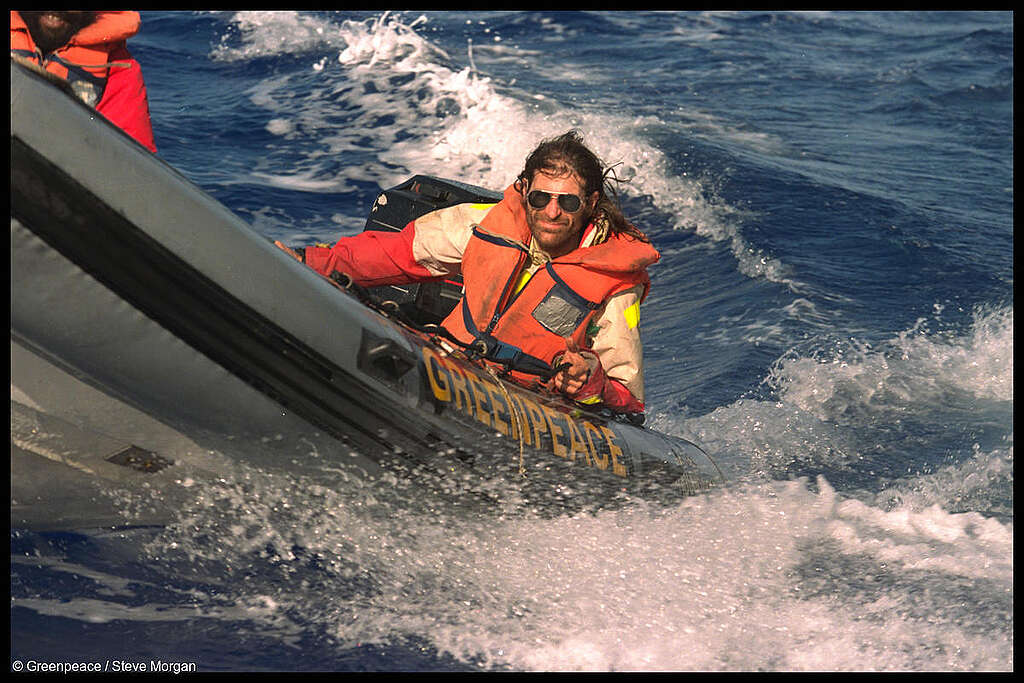
“Kate Lecchi and I drove along the drilling platform, chased by a military helicopter, and got underneath the drilling rig,” recalls SV Rainbow Warrior II crew member Alice Leney.
“I jumped up and climbed onto the rig with a steel tube slung over my back and got onto a walkway and then ran up some stairs onto the platform where I found a railing and attached myself around the railing by securing my arms in the steel tube. The military had to come after me and then once they got to me, they had to work out a way to get me off the rig, which took them quite a while.”
“Eventually they came back with a sharp knife and cut the device that I was attached to inside the steel tube. Then they arrested and removed me.”
Landing activists onto the drilling rig to disrupt preparations for the first nuclear test had been the primary aim of the action, so Alice Leney was successful in doing so.
After Stephanie Mills climbed up onto the deck of SV Rainbow Warrior II to escape the tear gas in the radio room below, French commandos arrested and carried her away to be transferred to Moruroa. As they did, she shouted, “We’ll be back!”
Footage of the storming of the new Rainbow Warrior was beamed around the world from the boat using a new purpose-built satellite feed on board that had been developed by Greenpeace technician Tim Gorter, dubbed ‘The Squisher’. TV news stations broadcast the footage and audio to a massive global audience, including in New Zealand, where it ranked next to Sir Peter Blake’s victory in the America’s Cup as one of the biggest news stories of 1995.
After the armed commandos seized control of SV Rainbow Warrior II and arrested the crew, they were taken to the French military base on Moruroa for interrogation. Oscar Temaru, Bishop Jacques Gaillot, photographer Steve Morgan, and other journalists aboard were flown to Pape’ete.
After the interrogations, the crew were taken back to SV Rainbow Warrior II at 2am the next day and the boat was towed out of Moruroa lagoon, back into international waters and released. Later in the day, SV Rainbow Warrior II made rendezvous with SV Vega and SV Bifrost to swap around some crew members.
A survey of the state of SV Rainbow Warrior II revealed a large hole on the bow where the French warship had repeatedly rammed her. The bridge windows were smashed and the inflatable boats had been taken away and impounded by the French military.
In the aftermath of the storming of SV Rainbow Warrior II, the governments of 160 countries protested to the French Government against the planned nuclear tests.
There was also a dramatic change in public opinion towards nuclear weapons in Europe. Opposition to the nuclear tests was running at 80-90% across Europe, while more than 75% of Europeans said they opposed France’s proposal for a new ‘Eurobomb’. Within Metropolitan France, 64% of people now opposed the tests.
French President Chirac may have blundered ahead with his ‘last gasp’ series of nuclear tests, but he had also unwittingly turned public opinion even more strongly against nuclear weapons.
(See: ‘The Storming of the Rainbow Warrior’, Greenpeace magazine, Aotearoa, Issue 71, September 1995; pers comm; Stephanie Mills, June 2020; pers comm; Michael Szabo, June 2020)
The Pacific Peace Flotilla
The disproportionate and violent response of the French military to Greenpeace’s flagship sailing into Moruroa sparked global outrage, triggering protests across the region and the wider world.
The planned resumption of the French nuclear testing programme was condemned by the European Parliament, the annual South Pacific Forum Heads of Government Meeting, and the Australian and New Zealand governments and parliaments. That left Chirac’s new French government diplomatically very isolated.
On an official visit to the European Parliament at Strasbourg in France the following day, French President Chirac was met with such strong opposition to his decision to resume nuclear testing at Moruroa that after being jeered and booed by MEPs he was stunned into silence, and was unable to begin his opening speech for a full ten minutes.
In the face of overwhelming public opposition to the tests in New Zealand and under pressure from Greenpeace and opposition parties, the National government led by Jim Bolger agreed to send a New Zealand navy vessel – HMNZS Tui – to protest and to support the Pacific Peace Flotilla at Moruroa.
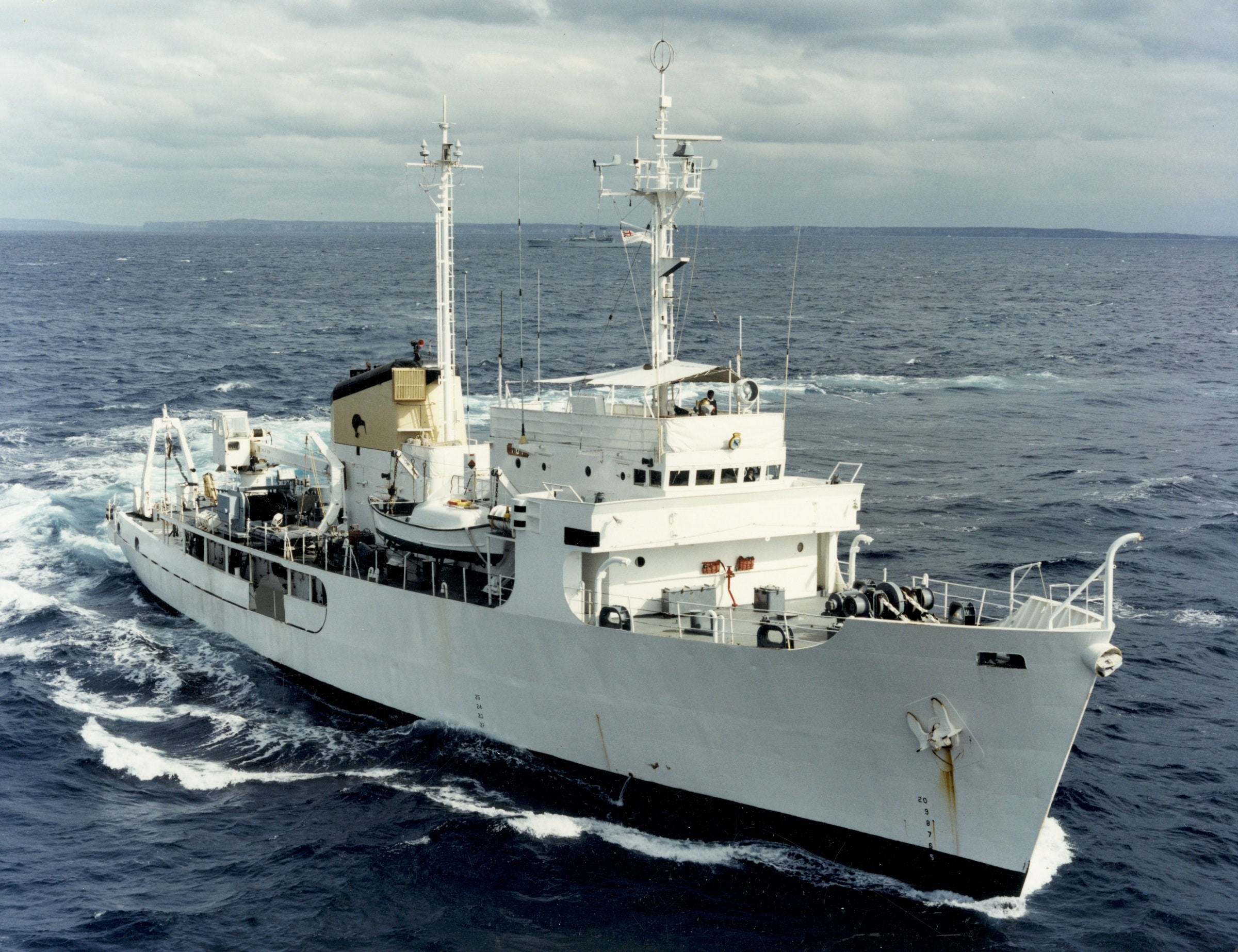
The Rainbow Warrior sails back to Pape’ete
On 11 July, Greenpeace announced SV Rainbow Warrior II would sail back to Tahiti to support a second big protest there against the nuclear tests on 14 July, Bastille Day, and to undergo vital repairs. Vega and Bifrost remained off Moruroa where they could liaise with the crew of the ‘fifth inflatable’ by radio.
On the tenth anniversary of the 1985 bombing of the Rainbow Warrior, thousands marched up Queen Street in Auckland to protest against the French government’s nuclear weapons tests, and call for real nuclear disarmament.
Greenpeace also held a ceremony to commemorate the bombing on Marden Wharf, which included throwing flowers onto the water where Greenpeace photographer Fernando Pereira was killed by the bombs planted by the French Government’s DGSE agents.
The next day South Pacific Forum Secretary General Hon. Iremia Tabai issued a statement criticising the French military’s use of force against SV Rainbow Warrior II and her crew as “excessive” and “irrational”.
The Rainbow Warrior arrives in Pape’ete on Bastille Day
SV Rainbow Warrior II and Oscar Temaru arrived back in Pape’ete on 14 July (Bastille Day) to a welcome with traditional Tahitian piragua canoes and thousands of Tahitians marching against the tests carrying flags in support of Mā’ohi independence and placards against the tests following the boat’s protest action at Moruroa on 9/10 July.
Oscar Temaru and the crew were welcomed with traditional drumming and given fresh supplies of food. At a press conference on board SV Rainbow Warrior II, Greenpeace launched an appeal to mark Bastille Day, calling for more yachts to join the international ‘Pacific Peace Flotilla’ at Moruroa to escalate the protests.
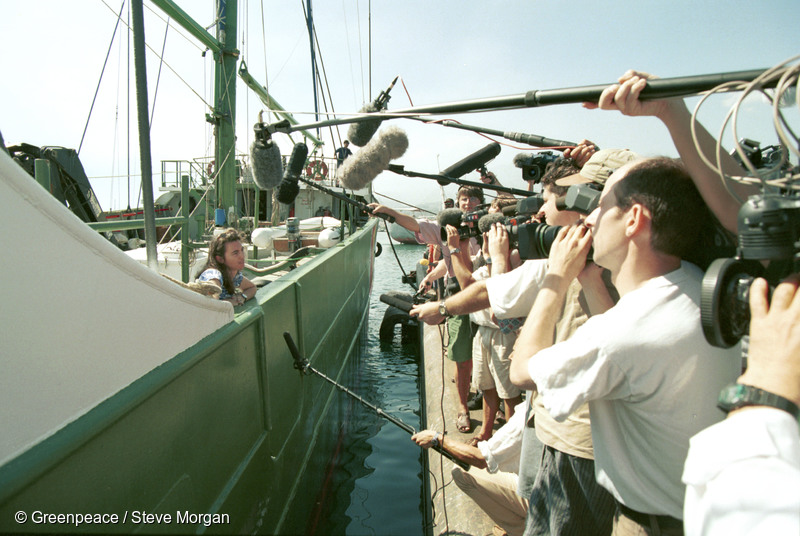
Thousands march in Aotearoa against French testing
As the outrage in Tahiti at the resumption of the French government’s nuclear weapons testing programme reached a new peak on Bastille Day, Greenpeace campaigners also joined with thousands of protestors who marched to the French Consulate in Auckland. Speaking at the rally, Greenpeace Campaign Manager Michael Szabo called on the French government to stop the tests and “give us liberty from the tyranny of nuclear weapons”. Thousands more took to the streets on protest marches around the country from Dunedin to Kaitaia.
After repairs, SV Rainbow Warrior II returned to Moruroa where it made rendezvous with Vega, MV Greenpeace, and Te-au-Tonga, the vaka sent to join the protests by the Government of the Cook Islands.
(See: Greenpeace magazine, Aotearoa, Issue 71, September 1995; pers comm, Michael Szabo, June 2020)
Thousands rally in Auckland to farewell the ‘Pacific Peace Flotilla’
Thousands rallied at the Auckland Basin Viaduct to mark the 50th anniversary of the bombing of Hiroshima on 6 August 1995 and to give the ‘Pacific Peace Flotilla’ a rousing send-off.
After the speeches, the Flotilla yachts set sail on their long voyage to Moruroa Atoll. At the same time, a second protest flotilla started to organise and assemble in France that planned to sail up the River Seine to rally in Paris itself, where the river runs through the centre of the capital. Their plan was only thwarted after the French authorities made it illegal for them to sail up the River Seine into Paris.
In August 1995, the New Zealand government also took a legal case against the French government’s nuclear weapons testing programme to the International Court of Justice (The World Court). Greenpeace Legal Counsel Duncan Currie developed the idea with the support of the late international lawyer Elihu Lauterpacht to revisit the UN International Court of Justice (ICJ) decision made on French nuclear testing in 1974.
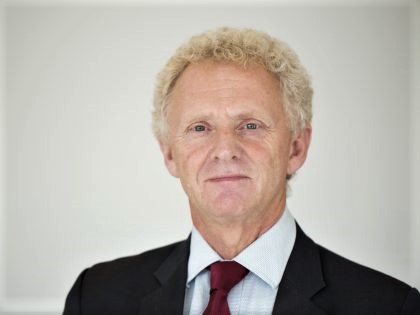
“I spoke to the NZ Government and the Leader of the Opposition to bring the case. Helen Clark, Leader of the Opposition, took a close interest, phoning me to discuss it and taking it on within Wellington. Later on, I was invited to a meeting at the Beehive to discuss it. Prime Minister Jim Bolger and others took the view, espoused by Helen Clark, that New Zealand had to be seen to be doing everything it could to try to stop the tests. NZ officials were by and large opposed initially, but once the case was underway in the Hague, they realised how much international prestige it brought.”
Although the World Court ultimately ruled against taking the case any further on the basis that the bomb tests were being detonated underground rather than in the atmosphere as they had been in 1974, it added to the diplomatic pressure on the French Government to stop nuclear testing.
On 31 August 1995, SV Rainbow Warrior II made rendezvous with Vega off Tureia
To transfer Tahitian anti-nuclear leader Oscar Temaru, US Congressman Eni Faleomaevaga (American Samoa), and Tahitian activist Vito Maamaatua onto SV Rainbow Warrior II so they could join the protests at Moruroa Atoll.
(See: Greenpeace magazine, Aotearoa, Issue 71, September 1995; pers comm, Michael Szabo, June 2020)
HMNZS Tui arrives at Moruroa
The New Zealand navy survey vessel HMNZS Tui arrived at Moruroa on 27 August, the vessel sent by the NZ government to support the Pacific Peace Flotilla.
NZ Members of Parliament Chris Carter (Labour) and Brian Neeson (National) were on board as representatives of the NZ Government and opposition parties to express the unanimous opposition of the NZ Government (National) and opposition parties represented in Parliament (Labour, New Labour, Green, Mana Motuhake, NZ First).
The next day, SV Rainbow Warrior II and MV Greenpeace rendezvous off Moruroa.
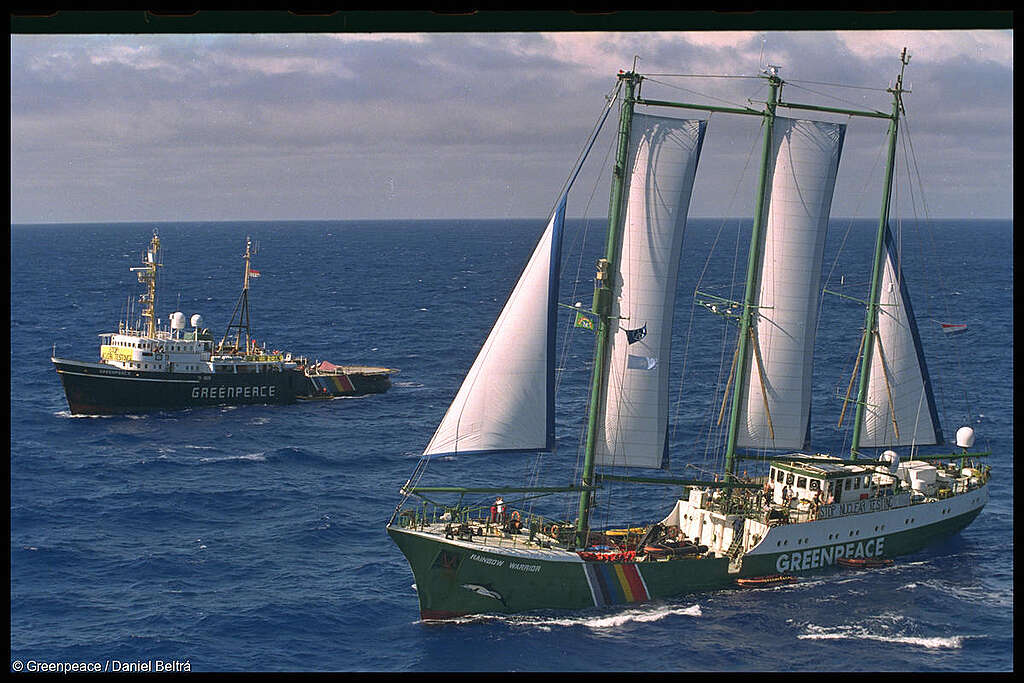
Rainbow Warrior and Vega rendezvous off Tureia
SV Rainbow Warrior II makes rendezvous with Vega off Tureia to transfer Oscar Temaru, US Congressman Eni Faleomaevaga (American Samoa), and Tahitian activist Vito Maamaatua onto the Rainbow Warrior to join the protest at Moruroa.
The Rainbow Warrior delays the first nuclear test
SV Rainbow Warrior II, MV Greenpeace, Vega and Bifrost sailed along the military exclusion zone off Moruroa ahead of the first test.
On 1 September, the day the first of the 1995 nuclear series was planned, SV Rainbow Warrior II once again set sail into the lagoon at Moruroa, launching its inflatable boats with activists aboard who sped towards the test shaft drilling rig.
At the same time, MV Greenpeace launched more inflatables from outside the exclusion zone that also headed to Moruroa, while the ship itself remained outside the zone. MV Greenpeace’s helicopter was launched to film the action before returning to MV Greenpeace to download it for broadcast.
SV Rainbow Warrior II was boarded by French commandos two kilometres inside the exclusion zone but its inflatable boats were able to reach the lagoon. Storming SV Rainbow Warrior II for a second time using gas torches and electric saws, French commandos smashed down the radio room door with sledgehammers, and then smashed and disabled the Warrior’s steering and communications equipment.
At the same time, more French warships, helicopters, and commandos struck out of the exclusion zone into international waters. Commandos slid down ropes to board from helicopters and illegally seized MV Greenpeace in international waters on the pretext that it had launched its helicopter and three inflatables that entered the military exclusion zone.
Greenpeace described the seizure and ensuing senseless damage done to its boats as an outrageous act of piracy in international waters.
The pre-emptive strikes made against Greenpeace’s boats were clearly designed to stop photos, video and audio broadcasts of the unfolding action being transmitted to the world, and to get Greenpeace ‘out of the way’.
Independent media reports including from Radio New Zealand’s Don Ruud, who was on board SV Rainbow Warrior II, confirmed that the French commandos used force to harass the Greenpeace crews. On MV Greenpeace commandos punched and kicked some crew and on SV Rainbow Warrior II crew members were intimidated with some being assaulted. Inflatable crews that made it into the lagoon were given similar treatment.
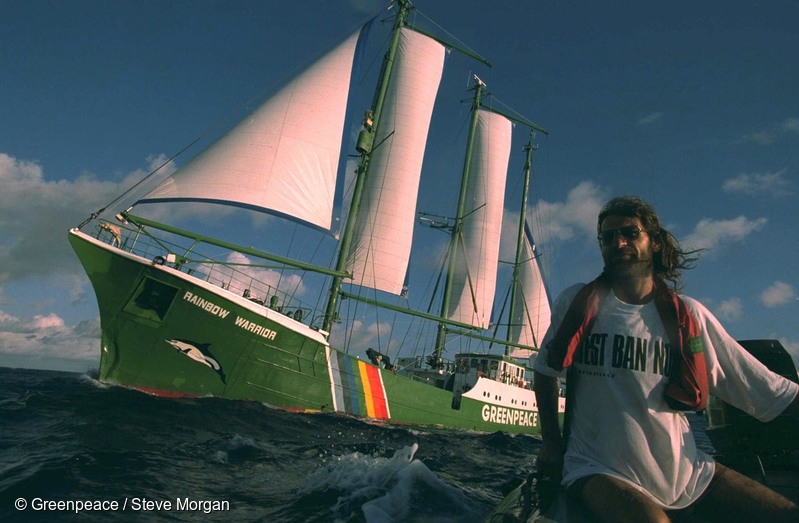
Alice Leney and Kate Lecchi drove an inflatable boat to a small islet within sight of the large ‘Dindon’ concrete control bunker on Moruroa Atoll and managed to evade the military helicopter that was sent to search the area.
“We reached a small islet just after dawn where Kate hid in some nearby scrub,” recalls Alice Leney. “I continued on foot towards the big bunker called ‘Dindon’. I had to wade across some chest deep water to get around the bunker to an area with taller vegetation. The French military had a spotter on the bunker roof who must have seen me. Then three legionnaires came after me and when they caught up with me, they arrested me, tied me up, and carried me to the bunker.”
“While they went to look for Kate, I was left alone and I managed to untie myself and escape. I hid under some nearby scrub for six hours. So, they had to spend quite a long time looking for me. When they eventually found me, they were angry and they assaulted me, beating me with some long sticks they were carrying. Then they tied me with strong cable ties.”
“When a helicopter arrived, they dragged me by my hair a few hundred metres along the ground and over some coral stones, shredding the clothes on my back and cutting me. They put me face down on the floor in the helicopter where one of them pushed hard on my back with his boot, to pin me down.”
When more legionnaires found Kate Lecchi, she was dragged 500-metres across sharp coral which cut her clothes, and she had her hands tied before being left face down while her captors set off to chase other inflatable crews.
At sea, the French Navy towed SV Rainbow Warrior II from Moruroa to Hao Atoll, the military base where the French Rainbow Warrior bombers Alain Mafart and Dominique Prieur had been held after their transfer from prison in New Zealand in 1987.
The same day, a human chain of about 200 people from around Europe attempted to deliver a 5 million signature petition against French nuclear weapons testing at Moruroa to President Chirac at the Elysee Palace in Paris, but they were stopped by police. Two boats, which were supposed to carry more people to join the protests at the palace, were also blocked by police.
After two days of confinement at Moruroa, the Greenpeace inflatable crews were released and the remaining SV Rainbow Warrior II and MV Greenpeace crew members sent to the French military base at Hao Atoll.
En route, SV Rainbow Warrior II skipper Jon Castle managed to hide aloft in the Crow’s Nest up a mast. When commandos saw him, they tried to get him down using water hoses and Stephanie Mills took a photograph of them. Two commandos immediately ran and jumped at her, knocking her to the ground, pinning her face-down so they could twist her arms up behind her back. Holding her down, they prised the camera from her hands and threw it overboard.
The Greenpeace crews were all held illegally without charge and denied access to lawyers. Only after repeated protests were they allowed very limited communication with the outside world.
After a week of being illegally held in detention at Hao Atoll, Stephanie Mills, Philip Pupuka, helicopter pilot Paula Huckleberry, skipper Derek Nicholls, and crew member Peter Schwartz were flown by military plane around the globe to Paris via the US, and then deported from metropolitan France. The French government issued an expulsion order banning Stephanie Mills from France for life on the spurious grounds that her presence anywhere within the country would be “a threat to public order and the security of the French State” (a ridiculous order that was eventually rescinded in 2003).
Greenpeace organised protests around the world in response to the outrageous use of piracy and violence against the peaceful protest of its crews and boats, and demanded their immediate release.
In Wellington, Greenpeace climbers abseiled down to the eighth floor of the downtown building where the French Embassy offices were located opposite Queen’s Wharf and hung two huge banners calling for an end to the nuclear tests, and demanding the release of Greenpeace’s crews and ships.
After her release and deportation from France via Paris, Stephanie Mills travelled to the Greenpeace International office in Amsterdam where she spoke at a media conference describing what had happened at Moruroa.
The seizure of SV Rainbow Warrior II and MV Greenpeace there meant that Vega was the only Greenpeace boat left at sea off Moruroa.
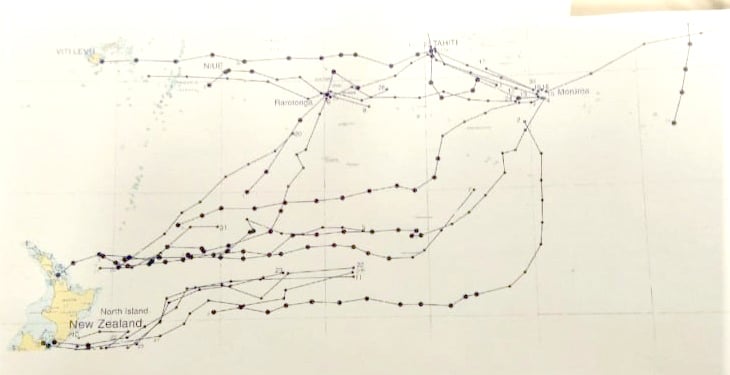
The first Pacific Peace Flotilla boats arrive at Moruroa
A few days after that, the first Pacific Peace Flotilla boats from New Zealand started to arrive at Moruroa after sailing an incredible 4,500 kilometres through two heavy storms, and were joined by Manutea, which had been sent by Greenpeace from the USA. Once there, they formed the core of the Flotilla, unfurling their protest flags and sailing along the 12-mile limit. They soon made rendezvous with HMNZS Tui, the NZ naval survey vessel that the NZ Government had sent to bear witness to the tests and support the Flotilla.
The captain of the Tui, Lieutenant Commander John Campbell, visited the Flotilla boats to welcome them. The Tui had been instructed to assist the Flotilla in the event of any emergency, but according to Flotilla crew member Marty Taylor, John Campbell decided it was better to pre-empt likely problems by supplying the yachts with extra water and fuel: “Dan Salmon and I were invited aboard, where we were fed vegetables and had a shower.”
Each Flotilla boat had a nautical map of Moruroa and Fangataufa overlaid with an Auckland street map. When they wanted to meet up, they would talk over the radio and agree to meet ‘on the corner of Queen Street and K Road’ so the French Navy didn’t know where they meant.
Greenpeace’s action stopped the first test going ahead on 1 September, delaying it for five days until 5 September.
The international response to the first test in the new series was swift. Governments in the Pacific and around the world condemned the nuclear blast that broke the moratorium. New Zealand and Chile recalled their ambassadors from Paris. Kiribati, Nauru, and Tuvalu went further and cut off diplomatic ties with France.
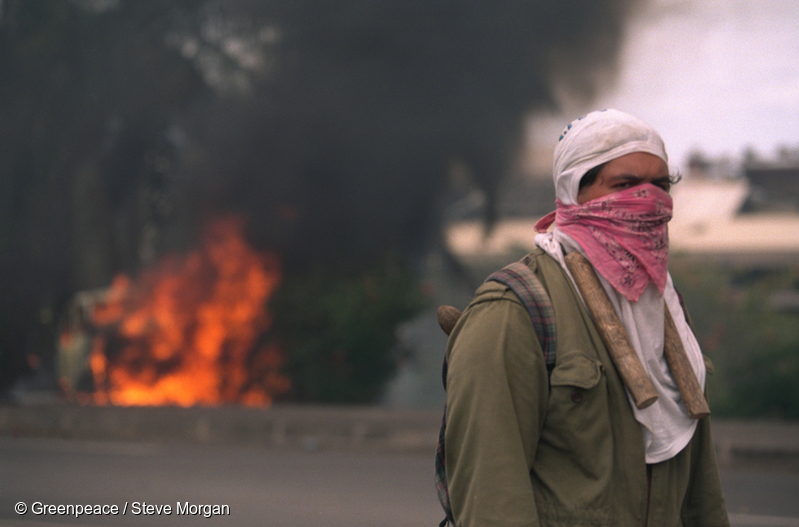
Around the world people took to the streets in protest. Another protest march was organised in Pape’ete, with thousands led by Oscar Temaru and joined by about 60 parliamentarians from around the world, including Japanese Finance Minister Masayoshi Takemura, who wore a “Stop Nuclear Tests” T-shirt and described the imminent resumption of testing as a “terror”.
When news of the first test explosion reached Pape’ete there was widespread anger and the ‘Tahitian bomb’ also exploded. Thousands took to the streets in protest and in parts of Pape’ete there were clashes with French riot police who fired smoke grenades and tear gas. During an occupation of the runway at Pape’ete international the airport building caught fire and burned, forcing its closure. Buildings in the French High Commission compound and nearby cars also became the target of rioting in the centre of the capital.
In Wellington, Greenpeace activists intercepted the French Ambassador outside his residence with huge posters of Jacques Chirac that branded him an ‘Environmental Criminal’, and in Paris, protestors blocked a road bridge across the River Seine and held anti-nuclear testing banners.
Greenpeace Campaigner Kirsty Hamilton organised a news conference with the Labour Leader of the Opposition Helen Clark, Mana Motuhake Party Leader Sandra Lee, and Stephanie Mills’ mother Judy Mills, herself a long-time campaigner against the tests, at which they called for the release of the Greenpeace crews and campaigners, and for an immediate end to the nuclear tests.
Greenpeace had sent Logistics Coordinator Janet Dalziell from its New Zealand office to Pape’ete to organise resupplying the Flotilla and briefings for journalists there.
After the two larger Greenpeace boats had been seized at Moruroa, Janet Dalziell sailed from Tahiti to Moruroa on the schooner Machias. She then helped organise for a group of ten Australian, Japanese, Swedish and Italian parliamentarians on board Machias to sail into Moruroa on board La Ribaude in protest at the tests.
Once inside the exclusion zone the parliamentarians read statements of protest in their respective languages over the radio which journalists on board HMNZS Tui recorded and broadcast around the world.
On 15 September, the South Pacific Forum Heads of Government meeting’s statement from Madang in Papua New Guinea expressing their “extreme outrage” at the French government’s resumption of nuclear testing in the South Pacific.
(See: Greenpeace magazine, Aotearoa, Issue 71, September 1995; pers comm, Alice Leney, June 2020; pers comm, Stephanie Mills, June 2020; pers comm, Michael Szabo; June 2020; “Protest at Moruroa: First-hand accounts from the NZ-based flotilla”, Claudia Pond-Eyley, 1997, Tandem Press; “Protest voyage to Moruroa”, John Tucker, The Marine Quarterly, Summer 2017; “Moruroa Protest”, Marty Taylor and Kapil Arn, NZ Geographic, Issue 77, Jan-Feb 2006; “List of nuclear weapons tests of France”, Wikipedia; “Assuring Destruction Forever: Nuclear Weapon Modernization Around the World”, chapter on France, Hans Kristensen, Women’s International League for Peace and Freedom, 2012).
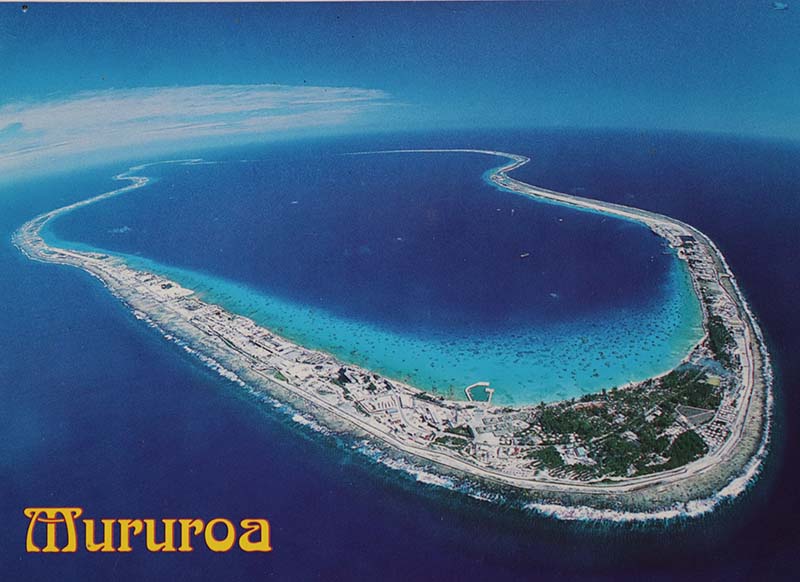
The Flotilla and Mā’ohi protestors continue the campaign
The Vega and dozens of other yachts in the Pacific Peace Flotilla that sailed to Moruroa continued their protest there. A new protest action was carried out on 16 September when two members of the pro-independence Tahitian group Hiti Tau (Time to Act) joined Flotilla crew members aboard SV R. Tucker Thompson. One of them was a worker at Moruroa and the other had ancestral links to Moruroa and Fangataufa. They paddled to Moruroa in a traditional piragua or outrigger canoe to highlight the lack of medical monitoring of the many workers at Moruroa.
A few days later, New Zealanders Dan Salmon and Daniel Godoy took two sea kayaks and paddled them into and around the lagoon at Moruroa until a French military helicopter found them. They were arrested and interrogated before being flown to Pape’ete where they were released.
Mā’ohi reclaim Moruroa Atoll
The Machias made a second return trip from Tahiti to Moruroa with a group of seven Mā’ohi, mostly from Oscar Temaru’s Tāvini Huiraʻatira movement. They transferred to Vega and joined a group of Mā’ohi from the nearby island of Tureia
Together, on 26 September, they attempted to reclaim Moruroa Atoll and to protest against French nuclear colonialism.
Before the French military occupation of Moruroa and Fangataufa atolls in the 1960s, the indigenous Mā’ohi people living on nearby Tureia used both atolls as a seasonal food gathering area. Then they were annexed by the French State without the consent of the local Mā’ohi owners.
According to Marty Taylor and Kapil Arn, (See: “Moruroa Protest”, Marty Taylor and Kapil Arn, NZ Geographic, Issue 77, Jan-Feb 2006), the chief of Tureia said his people wanted to return to Moruroa Atoll and for the French government to recognise them as the rightful owners.
Together with the chief of nearby Vanavana, a joint letter was drafted to send to French President Jacques Chirac making their case. David McTaggart, Henk Haazen, and Chris Robertson offered to take them to Moruroa aboard Vega so they could deliver their letter to French Admiral Euverte and ask him to forward it to President Chirac.
Before their departure, David McTaggart read out a message to the French military via VHF radio. After outlining the complaints of the local Mā’ohi chiefs, he announced their intentions: “Some of the Polynesians will sleep on the shore of the atoll peacefully with no demonstrations and then we will leave peacefully, as we came. We trust that you will respect the rights of the people of Polynesia. Many of those with us today have families born on Moruroa.”
At 2pm on 26 September, Vega crossed into French territorial waters with 21 Mā’ohi from Tureia. Flotilla crewman (from Joie) and documentary film-maker Marty Taylor filmed their departure into the exclusion zone. Then, a few miles inside the exclusion zone, French commandos boarded Vega and arrested them all. The French military authorities tried to deny that any local Mā’ohi had been aboard Vega and their media statement falsely claimed that David McTaggart and Chris Robinson had been the only people aboard.
Greenpeace arranged for Marty Taylor to fly to Pape’ete with his footage and with the help of Greenpeace’s Logistics Coordinator in Pape’ete, Janet Dalziel, his footage went to the Reuters news agency in Pape’ete. All of the major international news networks then ran the footage along with the story.
The next morning at a press conference the French authorities were forced to admit that there had in fact been local Mā’ohi Vega. This time they falsely claimed that Greenpeace had deceived the local Mā’ohi to use them as ‘political pawns’.
Marty Taylor had interviewed the chief of Tureia before Vega departed for Moruroa lagoon, so the French authorities’ attempt to fabricate a new falsehood about the protest was exposed.
“This time a more powerful story was reported,” said Marty Taylor. “The voice of a leader unknown outside Polynesia echoed around the world shortly after the French claimed he had been deceived.”
(See: “Moruroa Protest”, Marty Taylor and Kapil Arn, NZ Geographic, Issue 77, Jan-Feb 2006; pers comm, Henk Haazen, June 2020).
Shortly after, Henk Haazen (NL/NZ) and Sanai Shida from Greenpeace Japan also took an inflatable boat from Vega which they drove to Fangataufa Atoll to disrupt and try to stop one of the tests there. After further manoeuvres there evading the military they too were arrested, flown to Pape’ete and then deported to New Zealand.
Faced with the determined opposition of Mā’ohi protestors and the Pacific Peace Flotilla, the French government once again resorted to piracy and illegally seized Greenpeace USA’s Manutea in international waters on 2 October.
That left two Flotilla yachts, Caramba and Joie. They remained at Moruroa until the end of October when the approaching cyclone season forced them to leave for safety reasons.
The presence of so many boats and yachts at Moruroa from June until October helped focus opposition to the tests and put pressure on the French government to stop the tests once forever.
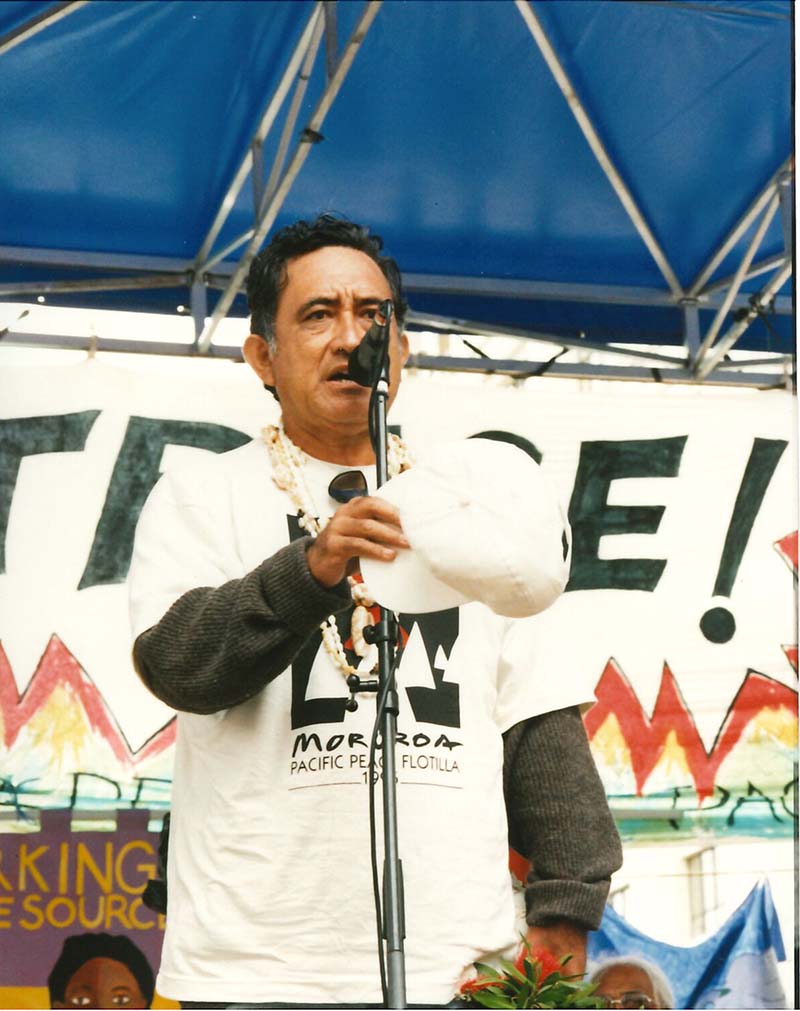
Protests greet Commonwealth Heads of Government Meeting in Aotearoa
The 5 September nuclear test and five subsequent French tests were also met with loud protests. Greenpeace activists blockaded the French Ambassador’s residence in Wellington and occupied the roof where they switched on loud sirens and waved anti-nuclear placards and French flags painted with a large radiation symbol.
Another group of them protested ‘bound and gagged’ outside the French Embassy in Wellington calling for the release of the Greenpeace crews and campaigners who were being held illegally at Hao Atoll, and then blockaded the Embassy entrance.
Thousands joined a ‘Major Disgrace’ rally in QEII Square in Auckland on 9 November to condemn visiting Conservative British Prime Minister John Major for his public support of the French government’s resumption of nuclear testing.
After the mihi and opening speech by Ngati Whatua kaumatua Grant Pakihana Hawke, speaker after speaker condemned the resumption of nuclear testing, including Oscar Temaru, NZ Alliance Party leader Jim Anderton, NZ First Party leader Winston Peters, Māori land rights activist Eva Rickard, and Greenpeace Test Ban Campaigner Stephanie Mills. The speeches were followed by live performances by Kiwi musicians Dave Dobbyn and Emma Paki.
The next day Greenpeace Actions Coordinator Rob Taylor and climbers Mark Watson and Kirsty Hamilton marked the opening of the 1995 Commonwealth Heads of Government Meeting (CHOGM) in downtown Auckland by abseiling off the top of the 16-storey AUT Tower opposite the Aotea Square venue and hanging a giant banner that read, ‘Major Disgrace’. The banner also had a large image of the ‘Union Jacques’ flag with the face of Jacques Chirac painted in the centre of the British flag.
The banner was unfurled as world leaders started to arrive at the front entrance of the Aotea Centre, including British Prime Minister John Major, HRH Queen Elizabeth II, South African President Nelson Mandela, and NZ Prime Minister Jim Bolger.
The Greenpeace climbers wore John Major and Jacques Chirac masks and the banner remained in place for several hours for all Commonwealth leaders and their delegations to see as they arrived at the front entrance to the Aotea Centre venue.
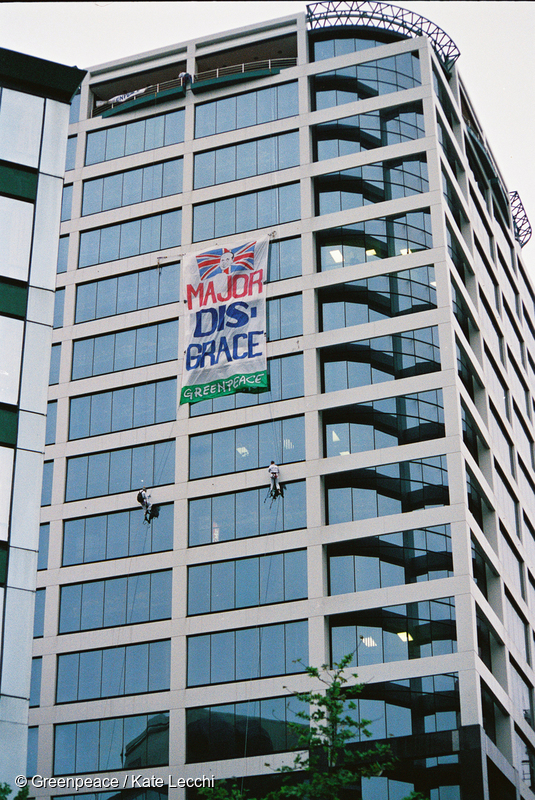
It had been widely anticipated that British Prime Minister John Major would refuse to join with the rest of the Commonwealth Heads of Government in condemning the resumption of the French Government’s nuclear weapons tests because Britain and France had signed a new deal the week before that increased nuclear collaboration between the two nuclear weapons states.
Greenpeace’s banner was aimed at pointing out how the new ‘Entente Nucleaire’ between Britain and France meant that Major’s Conservative government had chosen a nuclear alliance with the French government over its long-standing ties with New Zealand and the rest of the Commonwealth.
Greenpeace Campaign Manager Michael Szabo, who attended the CHOGM meeting inside the Aotea Centre as an NGO representative, encouraged government delegations inside to make a strong statement condemning the nuclear tests and to call for an international treaty banning all nuclear tests and nuclear weapons.
“The CHOGM leaders’ statement issued at the end of the meeting contained all the key points that Greenpeace wanted to see in it. The fact that it came in the form of an unprecedented special ‘Statement on Disarmament’ included in the final communique was a bonus,” recalls Michael Szabo.
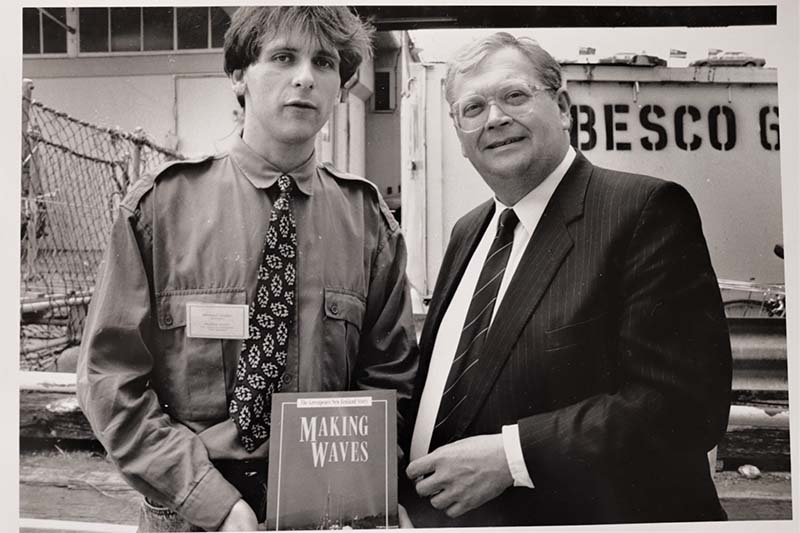
On 21 November 1995, a team of Greenpeace activists protested against the fourth French nuclear test of the year by climbing up onto and occupying the roof of the British High Commission in downtown Wellington.
Wearing John Major and Jacques Chirac masks and waving ‘Union Jacques’ flags with Chirac’s face painted on them, the activists once again switched on loud sirens to draw attention to the British government’s support for the French nuclear weapons testing programme, and the new nuclear collaboration deal that the two countries had signed just a few weeks before.
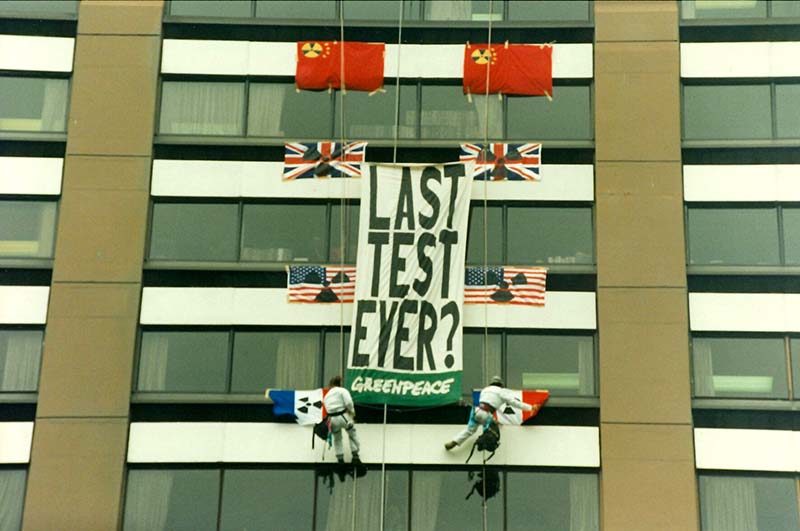
France ends 30 years of nuclear testing
The last nuclear weapon test at Moruroa Atoll was on 27 January 1996. A team of Greenpeace climbers marked the occasion by abseiling down to the 8th floor of the building housing the French Embassy in Wellington to hang a big banner that asked, “Last Test Ever?”
It was to be the last French test, but not the last ever nuclear weapon test. Greenpeace warned at the time that military experts were saying the Chinese Government was expected to test more nuclear weapons, which could severely jeopardise progress on agreement at the UN Comprehensive Test Ban Treaty negotiations in Geneva, and even encourage other nations to carry out more nuclear tests.
President Chirac had announced in May that a series of eight nuclear tests was planned, so the protests and public pressure succeeded in delaying them and forced him to end them early by cutting down the number to six. Most of the tests were of a low yield, so the total combined yield (231 KT) was lower than in the previous annual test ‘series’ of the early 1990s.
The presence of Greenpeace’s boats alongside the Pacific Peace Flotilla and the Cook Islands vaka Te-Ao-O-Tonga at Moruroa, plus the mass mobilisation against the tests in Tahiti Nui, Rarotonga and Aotearoa between June and October 1995 galvanised the global peace and environmental movements. Along with the political and diplomatic pressure from governments and other civil society groups, they helped to put massive pressure on the French government to stop the tests.
While a ‘David and Goliath’ label was often applied to the yachts and other boats protesting against the tests at Moruroa, according to Rémi Parmentier, one French writer commented that the Pacific Peace Flotilla evoked the ‘spirit of Dunkirk’, like a small armada of yachts sailing across the sea into the jaws of danger in defiance of the nuclear ‘jackboot’.
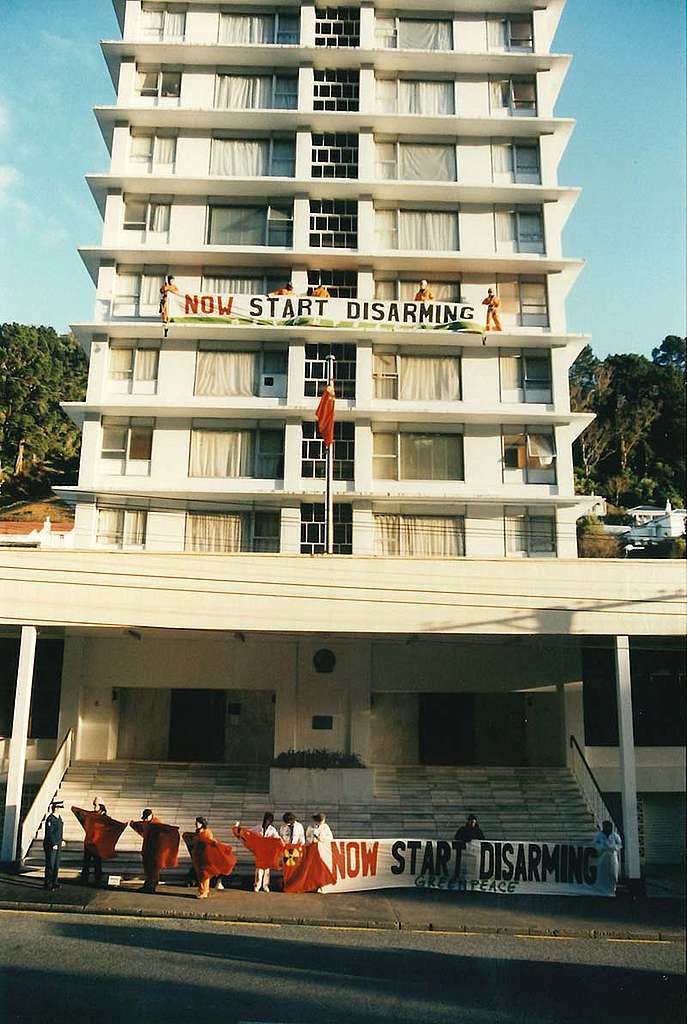
France and China sign the Comprehensive Test Ban Treaty
A dozen Greenpeace activists protested at the Chinese Consulate in Auckland after the Chinese Government carried out a 50 KT nuclear weapon test at the Lop Nor nuclear test site in Xin Jiang Province on 8 June 1996. The activists held an 11-metre banner painted with Chinese characters that read, ‘Stop Nuclear Testing – Now Start Disarming’ and two large posters of Chinese Prime Minister Li Peng that read, ‘Li Peng – Nuclear Proliferator’ and ‘Li Peng – Environmental Criminal’, plus two large Chinese flags with radiation symbols painted on them.
At the same time, MV Greenpeace was sailing to the port of Shanghai in China to protest against the Chinese government’s latest nuclear weapons test. On 12 June, as the boat was heading towards an anchorage near the mouth of the Yangtze River, which leads to the port of Shanghai, four Chinese naval vessels surrounded MV Greenpeace and 70 uniformed military and customs officials boarded the boat, blocking it from continuing to the Port of Shanghai.
Then on 30 July 1996, a team of six Greenpeace activists scaled the Chinese Embassy building in Wellington to hang a “Now Start Disarming” banner after the Chinese Government’s 45th – and last ever – nuclear weapon test at Lop Nor in Xin Jiang.
The activists also ran up a ‘Rad’ flag on the embassy’s flag pole – a red flag with a large yellow and black radiation hazard symbol in the top left corner instead of the five yellow stars of the Chinese flag. Another ten activists held up a second “Now Start Disarming” banner and more ‘Rad’ flags in front of the ground floor embassy entrance.
Speaking in front of the embassy entrance, Greenpeace’s Stephanie Mills called on the Chinese government to sign a zero-threshold Comprehensive Test Ban Treaty and start disarming.
Within months of the final test, President Chirac announced that France would sign a zero-threshold Comprehensive Test Ban Treaty at the United Nations and dismantle its nuclear testing infrastructure at Moruroa and Fangataufa atolls, which had been the central goal of Greenpeace’s nuclear testing campaign for 25 years. France also stopped production of highly enriched uranium for use in its nuclear warheads that same year.
Soon after that, China followed France and announced that it had ended its nuclear testing programme and would agree to sign the CTBT. After that the CTBT was agreed at the UN General Assembly in New York in September 1996, 25 years after the first Greenpeace anti-nuclear testing protest at Amchitka in Alaska in September 1971.
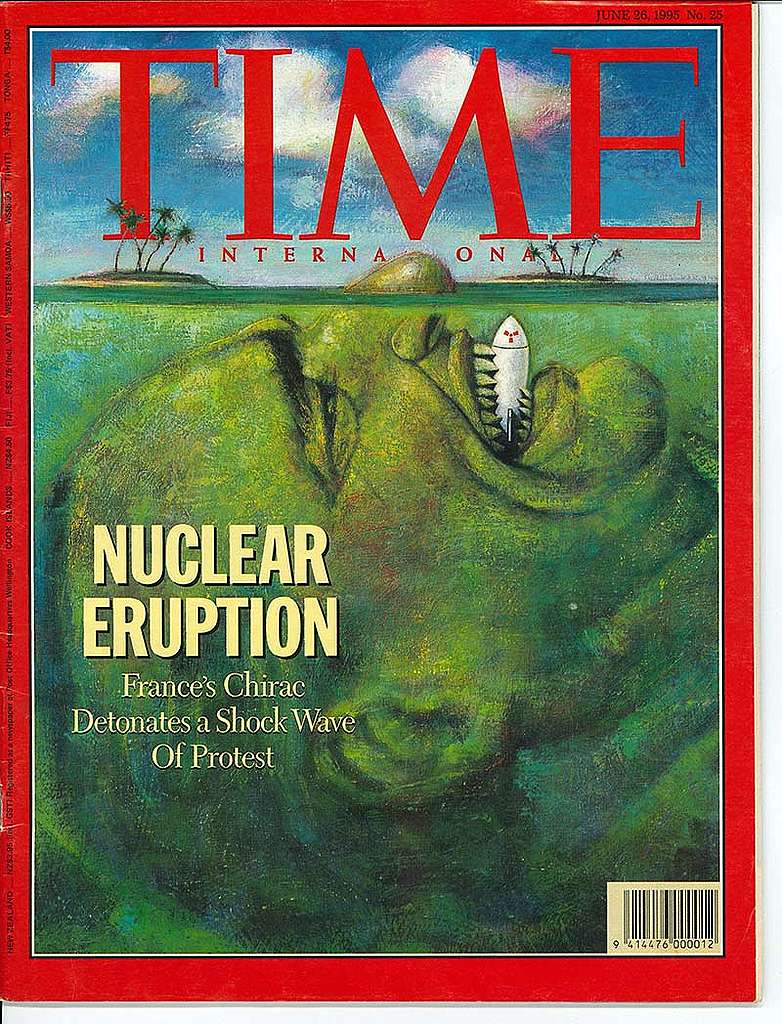
Looking back on 50 years of nuclear testing
The 50 years of nuclear weapons testing from 1946–1996 was an appalling chapter in Pacific history, but the resistance it inspired stands as a powerful example of solidarity and creative campaigning against nuclear colonialism and environmental destruction.
Indigenous and other groups and individuals in Tahiti Nui, the Marshall Islands, Kiribati, Fiji, Cook Islands, Vanuatu, Solomon Islands, PNG, Hawai‘i, Palau, FSM, Aotearoa, Australia, The Philippines, Japan and beyond, including the NFIP movement, church groups, peace and environmental groups, trade unions, women’s groups and a wide range of political parties, civic leaders, scientists, cultural figures and intellectuals protested peacefully, from the Pacific region to distant cities in North America and Europe.
Over decades, solidarity was created between anti-nuclear, peace, environmentalist, women’s, and church groups, and with Indigenous activists and non-government organisations around the Pacific and beyond such as Greenpeace, CND, WILPF and the International Physicians for the Prevention of Nuclear War (IPPNW).
Networks and connections were made which also extended to other environmental issues from forest and marine protection to climate change and missile flight testing.
As Jacques Ihorai, president of the Evangelical Church of Polynesia, is recorded saying: “The traditional spirit of Polynesians is that the land is like our mother. People come from the land. We must respect our mother, not explode bombs in her belly. Our good way of life comes from the land. Destruction of the land will lead to the destruction of life and the way of life of Polynesian people.”
The same concerns were repeatedly expressed in the annual regional heads of government meeting of the South Pacific Forum where nuclear testing was repeatedly condemned, and by Commonwealth Heads of Government Meetings, and at the United Nations General Assembly.
In addition to these official protests, nuclear-free principles were put into action. Belau (now Palau), Vanuatu and the Solomon Islands became Nuclear Free in 1979, 1982 and 1983 respectively, followed by Aotearoa in 1984. Fiji would have been next in 1987 had there not been a coup d’etat there. The South Pacific Nuclear Free Zone Treaty was adopted at an inter-governmental meeting in Rarotonga in 1985 and Pacific nations voted for the UN Comprehensive Test Ban Treaty in 1996. Most recently, Pacific nations voted for a UN Treaty on the Prohibition of Nuclear Weapons which was ratified by 50 countries in October 2020. The treaty seeks to ban the production, use, and stockpiling of all nuclear weapons, but the five declared nuclear weapons states have not yet signed it, nor have the ‘undeclared’ nuclear weapons states (Israel, India, North Korea, Pakistan).

“President Mitterrand authorised Opération Satanique”
On 10 July 2005, the French daily newspaper Le Monde published extracts from a previously secret 1986 account written by Admiral Pierre Lacoste, former head of France’s DGSE foreign intelligence service, that revealed France’s late president Francois Mitterrand authorised the operation that resulted in the bombing of Greenpeace’s Rainbow Warrior in Auckland on 10 July 1985. The DGSE reportedly gave the bombing operation the code name, “Opération Satanique”. (See: Papers show Mitterrand approved Rainbow Warrior bombing”, Reuters, NZ Herald, 10 July 2005).
“I asked the president if he gave me permission to put into action the neutralisation plan that I had studied on the request of Monsieur (Charles) Hernu,” Lacoste wrote. Hernu was French defence minister at the time. “He gave me his agreement while stressing the importance he placed on the nuclear tests. I didn’t go into greater detail on the plan as the authorisation was explicit enough,” he said.
Admiral Lacoste added that he, “would not have launched such an operation without the personal authorisation of the President of the Republic”. Admiral Lacoste’s account, dated 8 April 1986, was contained in a 23-page handwritten document that was previously secret.
Sir Geoffrey Palmer, who was NZ’s Deputy Prime Minister in 1985, was quoted by the NZ Herald as saying that Mitterrand’s role in the bombing had never been clear: “It is very disappointing because one would not expect the president of a friendly nation to authorise an illegal act against a nation with whom you enjoy friendly relations and with whom you have fought in two world wars. That seems to me to be extraordinary.”
Sir Geoffrey Palmer also reportedly said it was possible that Mitterrand didn’t know the extent of French Defence Minister Charles Hernu’s plans: “I dare say that what Mitterrand authorised was something pretty general, not something all that specific.” The NZ Herald also quoted Sir Geoffrey Palmer as saying that everyone involved in the bombing carried out by the French DGSE had an interest in protecting their reputations, but that Mitterrand, who died in 1996, was no longer around to comment on Admiral Lacoste’s account.
NZ Prime Minister Helen Clark (1999-2008) was also quoted by the NZ Herald as saying, “It confirms what we have always suspected was the case, that the attack on the Rainbow Warrior was authorised at the highest level.”
Former Greenpeace International Executive Director Steve Sawyer said Le Monde’s report came as no surprise to him, although he found the timing of its release peculiar, coming as it did on the 20th anniversary of the bombing: “Mitterrand’s always been responsible for the Government. We’ve always held him responsible.”
Steve Sawyer also said that others had claimed that Mitterrand did not know about the plans to bomb the Greenpeace flagship, but never Mitterrand himself. “It doesn’t change anything. No one thought it was a rogue spy service acting against the [French] Government.”
(See: “Greenpeace not surprised at Rainbow Warrior findings”, Ainsley Thomson and Agencies, 11 July 2005).
According to another account of ‘L’Affaire Greenpeace’, written in 2015 by French investigative reporter Edwy Plenel – the journalist who had uncovered the existence of the ‘third team’ of DGSE agents who planted the two bombs on the Rainbow Warrior in the 18 September 1985 edition of Le Monde – Plenel said that he discovered the existence of the ‘third team’ with the help of an informer within the French government of Laurent Fabius, who he called le Consul [the Consul].
(See: “La Troisième Équipe—Souvenirs de l’Affaire Greenpeace”, Edwy Plenel, Editions Don Quichotte, 2015)
“Rather than a straight informer, Plenel describes him more like a guide or a coach who puts him on the right tracks, and warns him when he makes a wrong turn – very much like the ‘deep throat’ source used by Bob Woodward and Carl Berstein at The Washington Post during Watergate,” according to former Greenpeace International Political Director Rémi Parmentier.
After several decades in global leadership roles within Greenpeace USA and Greenpeace International, Steve Sawyer left in 2007 to continue his work on climate change. He co-founded the Global Wind Energy Council to promote renewable wind energy and provide a representative forum for the entire wind energy sector at an international level. He led the organisation as its General Secretary for ten years.
During that time, global wind energy installations grew from 74 gigawatts to 539 gigawatts to become one of the world’s most important energy sources, and he made a significant contribution to the development of wind energy in India, China, Brazil, and South Africa.
Steve was diagnosed with lung cancer in April 2019 and died on 31 July 2019 in Amsterdam. He had been one of Greenpeace’s most important global leaders. During the decades he helped to lead Greenpeace he was a strong advocate for the organisation’s nuclear, Antarctica, and climate change campaign work, and a good friend to Greenpeace in Aotearoa and the Pacific.
Obituary for Steve Sawyer, 1956-2019.
More recently, on 27 June 2025, Rémi Parmentier died. Like Steve Sawyer, he played a crucial role in shaping Greenpeace’s strategies and campaigns through his ability to inspire others, his formidable intellect and unique sense of humour, and he was always an astute observer of the court of President Mitterand.
After decades working for Greenpeace, he co-founded the Varda Group with his former Greenpeace colleagues Kelly Rigg, Elaine Lawrence and Steve Sawyer, and continued his fight for environmental protection. With Varda he focused on new projects, including his work at the Global Ocean Commission, serving as the Deputy Executive Secretary, helping to ensure that they acted as a catalyst for 10 years of action on ocean protection.
During the UN climate negotiations he advocated for greater action through the “Because the Ocean” initiative, before he developed and ran the “Let’s Be Nice to the Ocean” initiative. His talent for forging partnerships and inspiring collaborative projects gave his efforts a resonance at both the local and global levels.
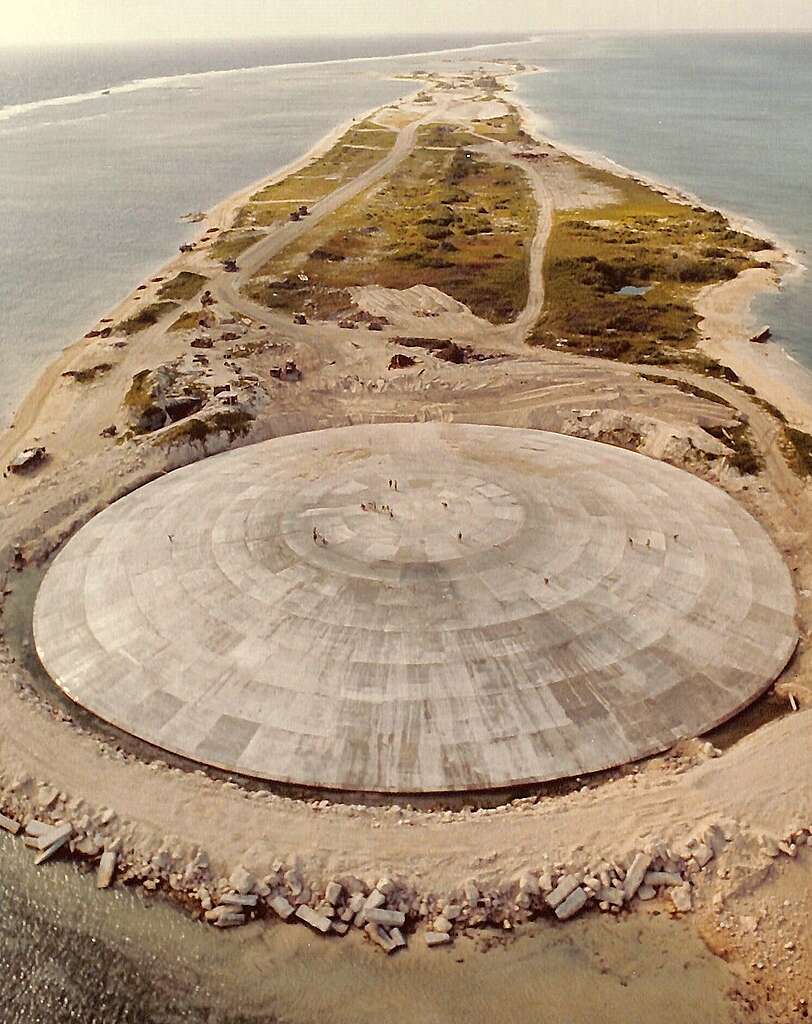
The health and environmental impacts of nuclear testing in the Pacific
While nuclear weapons testing in the region ended in 1996, the people of the Pacific are still living with its deadly legacy of radioactive contamination, health problems and displacement. Survivors continue to seek justice through lawsuits and compensation claims, and to demand that the test sites be comprehensively decontaminated.
The effects of nuclear explosions on human health have been known since the aftermath of the 15 KT enriched uranium bomb that was detonated over Hiroshima on 6 August 1945. It killed between 90,000 and 166,000 people, about half of them on the first day. The rest died from the effects of radiation burns, radiation sickness, and other injuries over the following four months.
Within a one kilometre radius most people died immediately or within a few days due to their skin being totally burned off and their internal organs seriously ruptured. Within two kilometres, many people suffered serious heat burns. Up to 2.1 km from the hypocentre of the blast anything flammable burst into flames.
After the blast, a wall of high pressure spread out at about the speed of sound, knocking over people even kilometres away. Many people were trapped in buildings demolished by the blast where they burned to death. Fire spread across the city, causing about 60% of the deaths.
Almost everyone within 952 metres of the hypocentre received a lethal dose of radiation. Anyone within a kilometre of the hypocentre within 100 hours of the blast suffered from radiation sickness and death from the residual radiation.
A ‘black rain’ of nuclear fallout fell from the sky on the western part of the city from 20 minutes to two hours after the explosion in an oval range of 19 x 11 kilometres. Strong residual radiation was recorded in this area.
The five months afterwards was a period of acute radiation sickness. About 20% of deaths were from injuries caused by the blast, 60% from thermal burns and the resulting fires, and 20% due to radiation.
People who did not die from acute sickness in the five months afterwards appeared to be in good health, but the effects did not end there. Common examples included the appearance of scars from burns forming swollen masses of scar tissue, eye problems, leukaemia, cancerous tumours and nerve-related problems.
Then there were the genetic effects. Radiation is an agent of mutation, which is inherited and passed onto future generations, and most mutations are harmful.
Many atmospheric nuclear tests that were carried out in the Marshall Islands, Kiribati, and Moruroa and Fangataufa atolls were in the megaton range. The largest US nuclear ‘test’ in the Marshall Islands was 15 MT.
For comparison, there are currently about 13,000 nuclear weapons in the world, mostly in the US and Russian nuclear arsenals, with most of them in the hundreds of kilotons to megatons range.
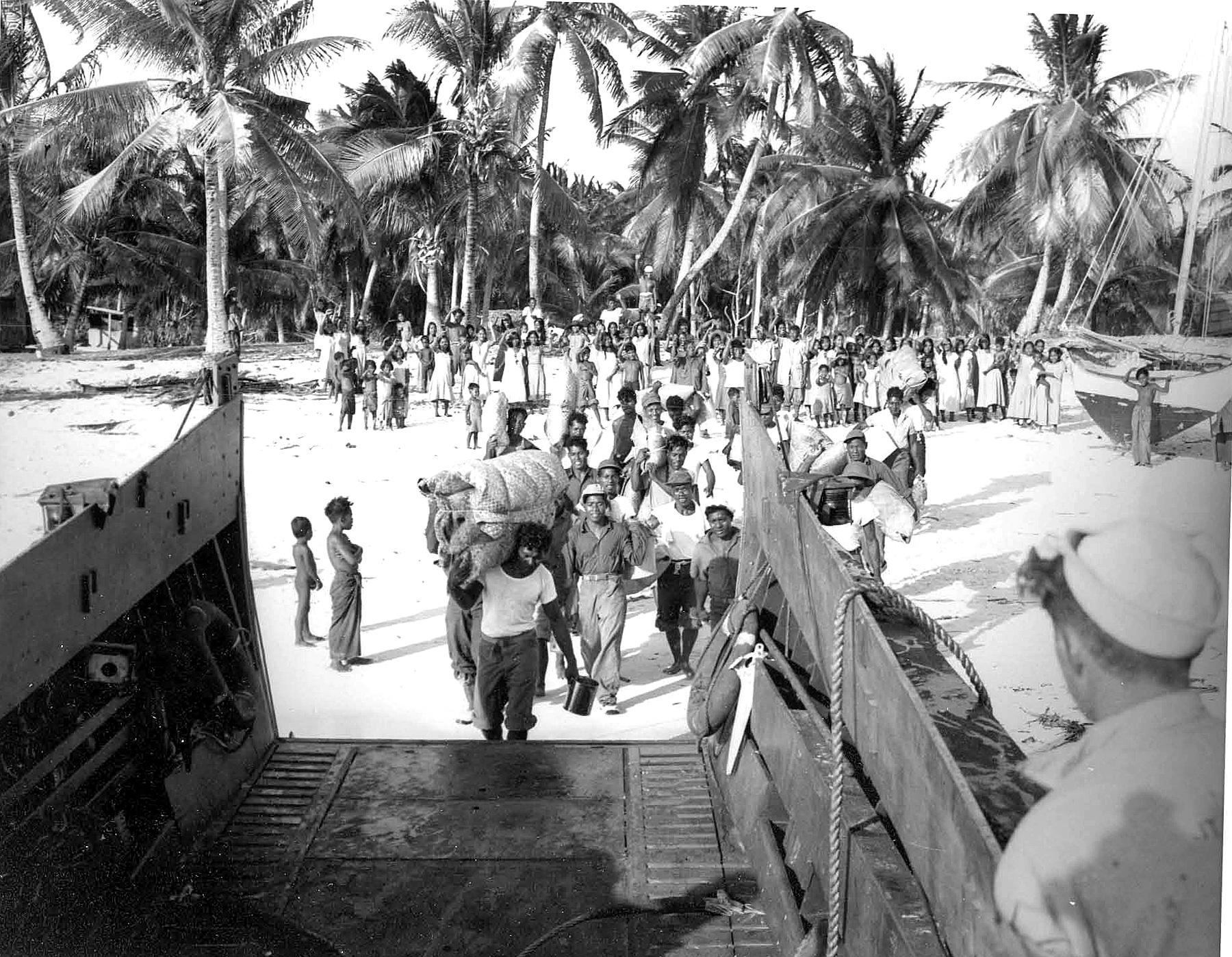
Impacts of US nuclear testing in the Marshall Islands
World War Two ended with the unconditional surrender of Imperial Japan on 2 September 1945 after the United States had attacked the cities of Hiroshima and Nagasaki with two nuclear bombs on 6 and 9 August 1945. The devastating impacts of those two weapons were reported at the time and were witnessed during the aftermath by the occupying US forces and allies. New Zealand forces, known as Jayforce, were part of the British Commonwealth Occupation Force in Yamaguchi prefecture, which has a border about 30km from Hiroshima.
The second nuclear bomb, which was dropped on Nagasaki, was about 20 KT. Although that was about 5 KT more powerful than the one dropped on Hiroshima, its effects were more confined by the steep hillsides of the narrow Urakami Valley. The city’s population was about 260,000 at the time, overwhelmingly civilians (plus 9,000 soldiers). An estimated 60,000 to 80,000 people had died there by the end of 1945. The target was to have been Kokura, one of Japan’s largest military arsenals, but cloud cover meant the pilot switched to Nagasaki as the secondary target.
Shortly after the Hiroshima and Nagasaki bombings, US President Truman was informed by US Secretary of War Henry Stimson of the large number of people killed in Hiroshima. Truman responded by ordering the cancellation of a planned third nuclear bombing scheduled to take place at another Japanese city on 17 or 18 August 1945.
After the war ended, the United States selected the Marshall Islands in Micronesia, a newly created United Nations Trust Territory under US government administration, as its main nuclear weapons ‘testing’ site.
The next step the US military took was to forcibly relocate the Marshallese people of Bikini Atoll to Mejatto, a small island about 300km south-west of Bikini that forms part of Kwajalein Atoll. Less than a year after the US nuclear attacks on Hiroshima and Nagasaki, aware of the devastating impacts on the civilian populations, the first US nuclear weapons ‘tests’ were carried out at Bikini Atoll.
The first two tests there (Operation Crossroads, 1946) were both 23 KT and involved 95 decommissioned warships being sunk and the irradiation of the lagoon and atoll.
The first US hydrogen bomb test codenamed ‘Ivy Mike’ was far larger than all the tests conducted from 1946 to 1952, with an explosive yield of 10.5 MT. The test on 1 November 1952 at Enewetak Atoll blasted a crater said to be over a mile wide and 17 storeys deep.
The largest of all US tests in the Marshall Islands was Castle Bravo (1954), a 15 megaton hydrogen bomb detonated at Bikini Atoll on 1 March 1954, one thousand times more powerful than the nuclear bomb dropped on Hiroshima on 6 August 1945. The blast was 2.5 times larger than the predicted yield of 6 MT due unforeseen additional reactions due to the addition of lithium-7 to the warhead.
The Castle Bravo explosion spread radioactive fallout over Rongelap, Utrik and other still inhabited atolls. The 12-year US testing programme there caused environmental devastation and the islanders suffered acute radiation sickness, and later, high rates of cancer and birth defects. The US conducted a total of 67 atmospheric nuclear weapons tests in the Marshall Islands between 1946 and 1958, rendering Bikini and Enewetak uninhabitable for many decades.
The US nuclear warhead tests had a total combined yield of about 108.5 megatons (MT), one megaton being one thousand times more powerful than one kiloton. So, 108.5 MT is the equivalent of about 7,250 Hiroshima bombs. That’s the equivalent of dropping one Hiroshima bomb per day for 20 years.
The US also detonated 15 nuclear warheads at high altitude above Johnston (Kalama) Atoll, about 700 nautical miles south-west of Honolulu in Hawai’i, between 1958 and 1962, under the jurisdiction of the US Air Force. The 15 tests carried out there had a total combined yield of about 14.2 MT, which is the equivalent of about 950 Hiroshima bombs. Five of those tests were listed as “unknown yield”.
The US detonated a further 24 US nuclear warheads in the atmosphere in the Christmas Island area in 1958 (known collectively as Christmas Island at that time, now part of the Republic of Kiribati) with a total combined yield of 24 MT, which is the equivalent of about 1,600 Hiroshima bombs.
There were also 3 underground US nuclear warhead test detonations at Amchitka Island in the Aleutian Islands of Alaska in the north-west Pacific between 1965 and 1971 with a total combined yield of 6 MT, which is the equivalent of about 400 Hiroshima bombs.
As negotiations progressed towards a Partial Test Ban Treaty (PTBT) in the early 1960s, the US government accelerated its nuclear testing programme. The PTBT was signed in 1963, which ended US, British and Soviet atmospheric nuclear testing. The US moved most of its tests underground at a test site in Nevada in the continental USA, plus there were three underground tests at Amchitka in the Aleutian Islands, Alaska. The Soviet Union maintained its testing sites at Semipalatinsk in Kazakhstan, Central Asia, and the island of Novaya Zemlya in the Arctic, shifting the tests underground.
The US tests at Amchitka sparked a new protest movement in Canada called the Don’t Make a Wave Committee, which in 1971 spawned the Greenpeace movement. Following the first Greenpeace protest voyage to Amchitka in 1971, the Amchitka test site was closed and the US moved all of its underground testing to Nevada.
Despite a 1986 compensation agreement (under a new Compact of Free Association), many Marshallese argue that the US government has not adequately addressed the health and environmental consequences of the nuclear tests.
In his chapter about the US tests in the Marshall Islands, Arjun Makhijani (2023) points out that radioactive fallout occurred all over the Marshall Islands as a result of the 67 US nuclear weapon tests carried out there, as per the fallout map from the 1954 Castle test series, and measurements taken at the time and published by the US government. Despite this, he says most of the Marshall Islands is not recognised as an affected area by the US government.
He states that in addition to Bikini and Enewetak atolls, where the tests were carried
out, the most severely impacted atolls were to the east of the test sites, including Rongelap, Ailinginae, Rongerik and Utrik atolls. Atolls to the southeast, such as Ailuk Atoll, 482km from Bikini, also suffered high fallout, especially from the infamous 15 megaton thermonuclear weapon test at Bikini called Castle Bravo, carried out on 1 March 1954.
He describes how the weather report in the days before the Castle Bravo test indicated westerly winds, putting inhabited atolls to the east of Bikini at risk. The outlook got worse a few hours before the test, putting Alinginae, Rongerik, and Rongelap directly in the path of the fallout plume but the test was carried out anyway. The US military did not evacuate those atolls or warn people there they were at risk, unlike earlier tests in the Marshall Islands. In fact, he says, atolls farther out, such as Ailuk, were also impacted seriously but were never evacuated.
He cites an article by Tilman Ruff in the International Review of the Red Cross (2016) which summarises the catastrophic impact of the Bravo test:
“Two islands and part of a third were vaporized in the explosion, and fallout rained down on the food crops, water catchments, houses, land and bodies of children, women and men going about their daily activities. Children played with the unknown ‘snow’ and rubbed it in their hair and on their skin. The residents of Rongelap, Ailinginae and Utrik Atolls were finally evacuated two and a half days later, after having received near-lethal doses of radiation, the highest following a single test in the history of nuclear test explosions worldwide.”
He then describes the short-term effects which included vomiting, damage to the mucosal lining of the gastro-intestinal tract, and radiation burns on the skin. The average exposure to 86 people on Rongelap was officially estimated at a level that could create a cancer risk of one in five in the population from that single test. Many had higher exposures.
The tragedy of the contamination of the Daigo Fukuryū Maru (Lucky Dragon No. 5) after the 1 March BRavo test and the fear that contaminated fish had entered the Japanese fish market led to the rise of an anti-nuclear movement in Japan and the 1954 Japanese film “Godzilla” was partly inspired by the same events.
Tilman Ruff also notes that doses from the Castle Bravo test for the Marshallese people who experienced high fallout were so high that the National Cancer Institute stated in its 2004 assessment: “Doses at Rongelap and Ailinginae were very high and were in a range for which there is little experience in dose estimation or health risk assessment.”
He says the same report concluded that the Marshall Islands population would suffer 500 excess cancers due to the radiation exposure from nuclear weapons testing. He points out that this was an enormous increase in cancer risk (9%), given the small population of the Marshall Islands. He calculates that it was comparable to about six million excess cancers in the mid-1950s population of the United States.
He also points out that people all over the Marshall Islands were exposed by the testing, far beyond the three islands that were recognised (Rongelap, Ailinginae, Utrik) for medical monitoring by the US government.
The National Cancer Institute later revised its estimate down to 170 excess cancers, which would be equivalent to about 2 million excess cancers in the US population. But as Arjun Makhijani points out, the revised dose estimate was far lower than independent estimates or even those of the US Department of Energy.
He concludes that nuclear testing in the Marshall Islands was a disaster from the very first test series in Bikini, Operation Crossroads, until it ended in 1958.
For example, Test Baker, the second test, carried out on 25 July 1946 at Bikini Atoll exploded underwater, sending a million tons of radioactive spray 1.8 kilometres into the air, which came raining down on everything in the vicinity. Prior to the test, the radiation safety team had warned that “extremely serious” radiological conditions would be created if the water column did not rise to more than 3 kilometres. It also warned the radiological problem “may remain dangerous for an interminable time thereafter.” He says their advice was ignored and the test was carried out.
The US tests in the Marshall Islands also produced widespread radiological contamination. Arjun Makhijani has calculated that 90,000 terabecquerels (TBq) of caesium-137, 60,000 TBq of strontium-90 and circa 1.2 million TBq of tritium remain, in addition to 370 TBq of plutonium-239 (160 kilograms) and 70,000 TBq of Carbon-14, which would be essentially undecayed from their initial amounts.
As Arjun Makhijani says, despite some compensation as part of the Compact of Free Association, the Marshallese people continue to suffer from the impacts of the tests. Adequate compensation and health care have not been provided by the US government, a fact highlighted by the October 2021 testimony of the Chair of the Marshall Islands National Nuclear Commission, Rhea Moss-Christian, given to a US congressional oversight subcommittee:
“The Nuclear Claims Tribunal remains open to receive any claims of personal injury and property damage caused by the nuclear tests. Several claims remain pending, as well, dependent on Congress’ replenishment of the Tribunal Fund. The last compensation award and initial payment were made in December 2008, leaving over $23 million in unpaid personal injury awards and over $2 billion in unpaid property damage awards, making it clear that by the end of 2008, the Tribunal would no longer be able to fulfil its mandate arising out of the Section 177 Agreement, ‘to render final determination upon all claims past, present, and future… which are based on, arise out of, or are in any way related to the Nuclear Testing Program.’ In this context, please recall that both the explosive force and the radiation doses suffered by the Marshall Islands were greater than the Nevada Test Site downwinders, but the awards for the Marshallese have been much lower.”
Whole communities were forcibly moved from Bikini, Enewetak, Wotho and Kwajalein atolls to make way for the US nuclear testing programme.
The tests also led to the closure of entire atolls and islands from being accessed for traditional customary uses, and to widespread environmental contamination. The full extent of environmental destruction and damage was not documented or published, but we know that the tests – especially the atmospheric tests in the larger yield range – caused die-offs of marine life and terrestrial biodiversity in the vicinity.
Each weapon test detonated at a coral atoll killed marine life including dolphins, dugongs, turtles, seabirds, fishes, shellfish and corals, and contaminated the land and marine food chains. Plankton around the test sites were contaminated with radioactive isotopes from the nuclear explosions, which we know can accumulate and magnify in marine food webs.
The increasing number of cases of ciguatera poisoning in the 1950s in the Marshall Islands was attributed to the US nuclear tests carried out there from 1946.
In the 1950s, fish poisoning was recorded as part of the ‘accident’ statistics, for which the rate in the Marshall Islands was at least 50% higher than for the whole of the wider US Micronesian Strategic Trust Territory. Between 1982 and 1987 the reported annual ciguatera rate for the Marshall Islands was more than three times the rate for any other Micronesian territory and according to a 1982 World Health Organization survey, 56% of families had been poisoned within the previous year.
During the 1950s and 60s, the three-yearly United Nations Visiting Commission reports were increasingly critical of the US administration there: “… poor transportation, failure to settle war damage, failure to adequately compensate for land taken for military purposes, poor living conditions at US missile bases for Marshallese, inadequate economic development, inadequate education programmes, and almost non-existent medical care.”
In 1988, a Compact of Free Association between the US and the Marshall Islands came into force giving internal self-government to the Marshallese but with only limited control of foreign affairs and no control of defence. In exchange, the US maintained its huge multi-million dollar military base at Kwajalein Atoll (the largest coral atoll in the world), and its strategic military presence in the region. Kwajalein Atoll is still used today as a US missile flight test site.
The Compact nullified many of the existing compensation claims related to nuclear testing and instead established a fund and tribunal to decide who would get the limited amount of money made available. This has resulted in divisions among families and communities.
The people of Rongelap were assured that their island was safe to live on. In 1985, despite continued health problems and the presence of radioactive contamination, the US and the government of the Marshall Islands refused to relocate them.
That is why, in May 1985, Greenpeace was asked by Rongelap Senator Jeton Anjain to use the Rainbow Warrior to transport 350 Rongelap Islanders and their belongings from Rongelap to Mejatto, in north-west Kwajalein Atoll. The people of Bikini suffered a similar fate of contamination, forced evacuation and exile.
Further details on the legacy of US nuclear testing in the Marshall Islands can be found here: https://www.greenpeace.org/aotearoa/press-release/legacy-of-us-nuclear-weapons-tests-in-the-marshall-islands-created-global-radiation-exposure-new-study/

Impacts of British nuclear testing in Australia and Kiribati
The British government detonated 12 atmospheric nuclear weapons in Australia between 1952 and 1957 at Monte Bello Islands in Western Australia, Emu Field in South Australia, and Maralinga in South Australia. The total combined yield was 180 KT, which is the equivalent of about 12 Hiroshima bombs.
Britain also carried out 9 atmospheric nuclear warhead tests at Kiritimati Island in 1958 (aka Christmas Island at that time), which is now part of the Republic of Kiribati in Polynesia, with a total combined yield of 7.8 MT. So, 7.8 MT is the equivalent of about 520 Hiroshima bombs.
The first 12 nuclear tests caused contamination across the Australian continent, including cities.
According to Tilman Ruff (2023), local Aboriginal people and pastoralists had the highest radiation exposure risk because they were not systematically evacuated or informed about the dangers, and over 16,000 workers were directly exposed to the tests. Some Aboriginal people were irradiated by local fallout, which was sufficient for a high proportion of inhabitants in the communities of Wallatina and Mintabie and neighbouring homesteads in northern South Australia to develop typical symptoms of acute radiation sickness, signifying a high level of acute radiation exposure, after the first test at Emu Field (Dr Arjun Makhijani & Dr Tilman Ruff, 2023).
In his chapter on the impacts of the tests in Australia, Tilman Ruff cites a Royal Commission report conducted in the 1980s which noted the appalling treatment of indigenous Australians during the British nuclear tests there: “Aboriginal people were within prohibited zones and lived in them during and for up to six years after tests. Officials responsible for their safety demonstrated “ignorance, incompetence and cynicism” and failed to consider “their special vulnerability to radioactive fallout”. The Royal Commission assessed that decades of denial of access to their traditional lands by Aboriginal people “contributed to their emotional, social and material distress and deprivation”.”
He also describes how Aboriginal people were disproportionately exposed to radiation from the tests, including via greater radiation exposure associated with traditional and cultural practices, including increased soil and dust ingestion and inhalation.
The Royal Commission also described, “departures, some serious and some minor, from compliance with the prescribed radiation protection policy and standards”.
He says that no more than 4% of veterans had radiation film-badge data available and that external exposures of more than 400 mSv (following the first Monte Bello test) were documented.
“Britain’s dirty deeds at Maralinga”, an in-depth investigative article written by Ian Anderson in New Scientist on 12 June 1993, contains revelations about Britain’s complicity in covering up the extent of radioactivity at its former nuclear test site in Australia.
Tilman Ruff (2023) also cites an Australian government-funded mortality and cancer study of test veterans which concluded in 2006 and found statistically significant 23% higher rates of cancer and 18% higher cancer mortality between 1982 (29 years after the first test) and 2001 in veterans exposed to nuclear tests compared with the general population.
There was also a rushed British ‘clean-up’ in 1967 involving the ploughing of plutonium-contaminated areas and shallow burial of material from 180 hectares of heavily contaminated land that led to a 1968 agreement between the British and Australian governments releasing Britain from liability for any future claims related to its nuclear tests.
A 1984 study by the Australian Radiation Laboratory also demonstrated far more extensive and severe contamination than had previously been revealed.
The Royal Commission recommended that: “action should be commenced immediately to effect the clean-up of Maralinga and Emu … so that they are fit for unrestricted habitation by the traditional Aboriginal owners as soon as practicable”, and that “[a]ll costs of any future clean-ups at Maralinga, Emu and Monte Bello Islands should be borne by the United Kingdom Government”.
Maralinga was declared ‘safe’ in 2000 after a second limited A$108 (US$76) million clean-up funded by both governments, despite what Tilman Ruff describes as expert concerns and failure to implement the planned process of immobilizing plutonium fragments through in situ vitrification after an explosion occurred in a pit.
According to Tilman Ruff, a region of 412 square kilometres remains unsuitable for permanent occupation and half the plutonium-239 will still be there in 24,400 years. Less than 2% of contaminated areas at the Australian ‘Taranaki’ site meet the clean-up clearance criteria.
Britain also carried out 9 atmospheric nuclear warhead tests at Kiritimati and Malden islands in 1958 (now part of the Republic of Kiribati in Polynesia) with a total combined yield of 7.8 MT, which is the equivalent of about 520 Hiroshima bombs.
The tests at Kiritimati and Malden islands, part of Operation Grapple, were to develop a thermonuclear weapon. In his assessment, Tilman Ruff notes that Ni-Kiribati, British, Fijian and New Zealand servicemen were exposed to radiation while serving on naval vessels sent to observe the tests, with many later developing serious illnesses. Britain did not evacuate nearby Indigenous populations, and radioactive fallout affected Ni-Kiribati workers and military personnel.
Decades later, he says, these ‘test veterans’ and Pacific Islanders in Kiribati campaigned for recognition and compensation, and in 2018, a new study found that radiation levels on Kiritimati remained dangerously high.
After the Australian government refused permission, the British government moved its planned hydrogen bomb tests codenamed “Grapple” to its Gilbert and Ellice Islands Colony (now the independent Republic of Kiribati) in the central Pacific.
According to Tilman Ruff, at both locations, British soldiers and sailors, 551 crew on board two New Zealand naval frigates, and nearly 300 Fijian soldiers and sailors worked in close proximity, as well as local Ni-Kiribati plantation workers and their families. The latter were evacuated to Fanning Island or remained on board ships during the initial but not the later 1958 tests. Nearly 14,000 British military and scientific staff travelled there as part of the British ‘H-bomb’ programme.
British military documents revealed: “… that one of the purposes of the tests was to study the effects of nuclear explosions on people – for example: “The Navy requires information on the effects of various types of atomic explosions on ships and their contents and equipment … The Army must discover the detailed effects of various types of explosion on equipment, stores and men, with and without various types of protection” and “the RAF will gain invaluable experience in handling the weapons and demonstrating at first hand the effects of nuclear explosions on personnel and equipment”.”
Chillingly, Tilman Ruff describes how radiation exposures for service personnel were not systematically monitored, protection for them was minimal, and protection standards were applied according to race.
The Grapple Task Force Commander Air Vice Marshall Wilfred Oulton circulated a document to senior Task Force members a top-secret document explaining that: “For civilised populations, assumed to wear boots and clothing and to wash, the amount of activity necessary to produce this dosage is more than is necessary to give an equivalent dosage to primitive peoples who are assumed not to possess these habits. For such peoples the corresponding level of activity is called level B’. It is assumed that in the possible regions of fall-out at Grapple there may be scantily clad people in boats to whom the criteria of primitive peoples should apply. … It is desirable that the Declared Danger Area should at least enclose the whole region in which there is a possibility that level B’ may be produced. The dosage at this level is about 15 times higher (for primitive peoples) than that which would be permitted by the International Commission on Radiological Protection.”
Tilman Ruff also describes how: “‘Clean-up’ operations included disposing of thousands of seabirds maimed, blinded or killed by the nuclear explosions, as well as dumping drums of nuclear waste into the ocean. The massive 3 MT Grapple Y explosion, on 28 April 1958, detonated lower than anticipated and sucked up large quantities of water and debris, accentuating the radioactive fallout, which was also exacerbated by a wind change that blew the main fallout cloud over Christmas Island. Personnel report being soaked by radioactive rainout after various blasts, with reports of hair loss and skin burns soon afterwards suggestive of acute radiation effects (and therefore high doses). “Sniffer” aircraft that flew through mushroom clouds minutes after the explosions to collect samples were associated with high exposures to the crews, with a mean of over 50 millisieverts (mSv) per person per test.”
He says that later studies among the New Zealand test veterans demonstrated an excess of blood cancers, including leukaemia, and that genetic studies in a group of veterans showed highly statistically significant (three-fold) higher rates of chromosomal abnormalities, such as translocations, dicentric chromosomes and complex chromosomal rearrangements, among the test veterans.
Tilman Ruff then comments, “It is significant that such evidence of long-term genetic damage was evident fifty years after the veterans’ exposure to nuclear tests.”
In 1998 the New Zealand government provided full war pensions for disabilities relating to their service for Christmas Island nuclear test veterans. Fiji Prime Minister Josaia Voreqe “Frank” Bainimarama (whose father led the first Fijian naval contingent sent to Christmas Island) announced in January 2015 that the Fiji government would grant compensation to the surviving Fijian military personnel who witnessed the British Grapple nuclear tests in 1958.
After the 1963 Partial Test Ban Treaty came into force, banning above ground nuclear weapons tests, Tilman Ruff reports that the British authorities dumped more material in the ocean including trucks and other vehicles and equipment, batteries, drums of asphalt and oil and asbestos, and contaminated debris was abandoned there. Some of the equipment such as metal drums and corrugated iron sheeting were re-purposed by local people for housing and pig pens.
Then in 2005, the British Ministry of Defence paid £9 million pounds to a private contractor to remove and transport back to Britain, 23,000 square metres of material remaining from the tests.
He also describes how the island was subject to repeated local fallout, particularly from the largest Grapple Y test of 3 MT on 28 April 1958. Two of the test weapons were suspended from balloons at 450m altitude over the southeast part of the island, producing low-altitude airbursts
After Kiribati became independent in 1978, the Kiribati government sought confirmation of environmental radiation levels. According to Tilman Ruff, the British government requested and funded the NZ National Radiation Laboratory (NRL) to undertake a survey of residual radiation at Kiritimati. This happened in March 1981.
The survey report noted that, “A British report on the final radiological survey and decontamination operations at Christmas Island prior to the closing down of the base in 1964 was made available to NRL”. The NRL concluded that radioactivity concentrations in soil were “found to be consistent with global fallout levels for a low rainfall equatorial area” and that “committed dose equivalents from drinking-water and locally produced foodstuffs for a postulated Gilbertese diet were estimated to be of the order of 0.01 mSv per year”, and no restrictions on land use were recommended. Tilman Ruff concludes that while this report was reassuring, questions remained around the monitoring and sampling procedures.
According to the report, gamma measurements and soil samples were taken only from areas of undisturbed soil, and no purposive sampling in relation to test sites or sites of supportive infrastructure and material or waste on land or sea appears to have been undertaken. Sampling of foodstuffs and fresh water appears to have been very limited. For example, testing water only on the western side of the island, and testing only two land crabs, and one fish from unspecified locations of each of several species. Until the 1981 NRL report was posted on the Pace University website in 2021 by independent researcher Matthew Bolton, none of the official radiological survey reports were available publicly.

Impacts of French nuclear testing in Tahiti Nui
The French government detonated 193 nuclear weapons (46 in the atmosphere, 147 in shafts drilled into coral atolls) in Tahiti Nui French Polynesia at Moruroa and Fangataufa atolls between 1966 and 1996.
The total combined yield of all the French atmospheric nuclear tests between 1966 and 1974 in the Pacific was reportedly 10.1 megatons. So, 10.1 MT is the equivalent of about 800 Hiroshima bombs.
The total combined yield of the underground tests there from 1975 to 1996 was about 2.8 MT. So, 2.8 MT is the equivalent of about 200 Hiroshima bombs.
In total, that’s a combined yield of about 1000 times more powerful than the Hiroshima bomb. The largest atmospheric test at Moruroa was in 1968. The Canopus test was 2.6 MT, which is the equivalent of about 200 Hiroshima bombs.
The nuclear tests profoundly impacted the health, well-being and environment of the Indigenous Mā’ohi people. They have lived for decades with exposure to radioactivity in the air, water, soil, fish and coconuts.
Anticipating this, the French government ceased publishing public health statistics for Tahiti Nui French Polynesia in 1963 shortly before it started to test nuclear weapons there in 1966.
However, data from the UN International Agency for Research on Cancer for 1998–2002 revealed that women in French Polynesia suffered the highest rates of thyroid cancer and myeloid leukaemia in the world, both types of cancer being strongly associated with radiation exposure (See: The Devastating Consequences of Nuclear Testing – Effects of Nuclear Weapons Testing on Health and the Environment).
A 2013 study also confirmed increased thyroid cancer rates near the French nuclear test sites.
Using hundreds of declassified French government documents, interviews in Polynesia and metropolitan France, and computer simulations, a 2021 book entitled “Toxique: The Aftermath of French Nuclear Testing in the South Pacific” co-authored by Sebastien Philippe, a researcher at the University of Princeton’s Program on Science and Global Security (SGS) and Tomas Statius, an award-winning French investigative journalist, challenges the official government account of French nuclear weapons testing in the South Pacific. Many of the documents, interviews, and simulations are on a dedicated website in French and English: https://moruroa-files.org/
It found that the total population exposed above the threshold necessary for French government compensation could be ten times more than was believed. It also showed how French service veterans were exposed to radiation during the tests, from the maintenance of contaminated equipment, and during attempted clean-ups on the atolls.
According to a June 2025 report by a cross-party committee of the French National Assembly, tens of thousands of people in Tahiti Nui French Polynesia are estimated to have been exposed to harmful levels of radiation from the tests, which led to a significant public health crisis which has been largely ignored by French authorities.
The incidence of ciguatera poisoning cases in Tahiti Nui rose sharply through the 1960s and remained high in the 1980s, with a ten-fold increase.
In the islands closest to Moruroa and Fangataufa atolls, incidence was above 30%, peaking at 56% in 1975. No figures exist for workers at Moruroa.
The atmospheric tests clearly dispersed large amounts of radioactive fallout over large areas of the South Pacific and beyond to mainland South America and other parts of the South Pacific.
They also created large quantities of contaminated debris and military construction materials and equipment at the test sites and associated military installations.
Official reports published long after the testing ended describe how contaminated debris and material was dumped in various locations in the lagoon and at sea, and how severe tropical storms swept contaminated debris into both the lagoon and the ocean.
Once the tests were moved into drilled shafts within the atolls and under the lagoons, the pathways for contamination were from the venting of volatile and gaseous fission products at the moment of the explosion, up through the test shaft and, once fissures and cracks started to appear in the underlying rock and the coral, through the movement and seepage of contaminated water and plankton. For example, venting was filmed in the sea adjacent to Moruroa lagoon during a test (see page 31, Testimonies, Biedermann & Mills, 1990).
The huge seismic blasts resulting from the tests also killed marine life in the lagoons and adjacent ocean, and the adjacent land and air. This included dolphins, turtles, seabirds, land birds and marine fishes.
After the first two underground nuclear tests at Fangataufa Atoll in 1975, a published eyewitness account by a worker there named Tupou describes how, “A few days later thousands of stinking dead fish washed up on shore.”
Mangareva in the Gambier Group of islands nearest to Moruroa and Fangataufa atolls had a population of about 500 people at the time of the tests. Another published eyewitness account, from a resident of Mangareva named Tafai, states that in 1968/69 following hydrogen bomb tests, “around that time there was another disaster. Thousands of dead fish were washed up ashore there. It lasted for quite a long time and the beaches stank.”
Another published testimony by a woman named Toimata states that after her first child was born in 1975, she had three more that survived but six that died. Her testimony describes their appalling health problems and suffering on page 63 of “Testimonies”.
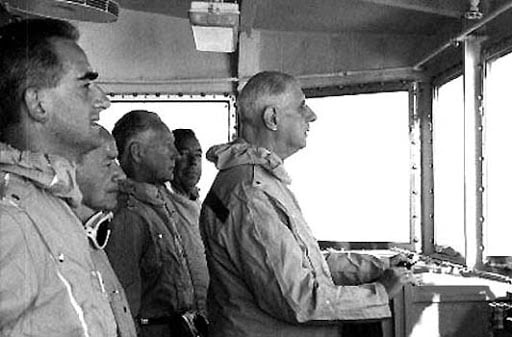
French efforts to suppress evidence of the impacts of nuclear testing
In May 2025, it emerged that French authorities had suppressed data and reportedly spent 90,000 Euros in an effort to counter research revealing that the French government consistently underestimated the devastating impacts of its nuclear weapons tests in Tahiti Nui French Polynesia in the 1960s and 1970s: https://www.theguardian.com/world/2025/may/27/france-spent-90000-countering-research-into-impact-of-pacific-nuclear-tests
Responding to this news, the Head of Pacific at Greenpeace Australia Pacific, Shiva Gounden, said: “This act by France is not just a denial of truth — it is an insult to generations who continue to live with the radioactive legacy of these experiments. From the scarred atolls of the Marshall Islands to the irradiated lands of Mā’ohi Nui (French Polynesia), our people carry the enduring fallout of nuclear colonialism – cancers, displacement, environmental devastation, deaths, and loss of generations. Instead of reckoning with its past, France chooses to fund distraction over accountability, image over integrity. This is not the act of a nation seeking justice — it is the act of a nation running from it. The Pacific does not forget, and our people will not be silenced. No amount of money can erase the truth written into our Pacific families’ bodies, our lands, and our histories.”
Greenpeace France campaigner and nuclear expert Pauline Boyer also said, “This is a shamelessly ramped-up disinformation campaign by the CEA [France’s Atomic Energy Commission]. Nuclear proponents continue to defend the law of silence when it comes to the victims of civilian and military nuclear industries. It’s high time the CEA, as well as the French government, acknowledged the facts with transparency and honesty: they deliberately chose to expose populations and their land to radioactive fallout and contamination from French nuclear bomb explosions. Underestimating the number of victims and the extent of the devastating impact on the health of civilian and military populations, in order to reduce the number of compensation claims and minimise this dark chapter in history, is utterly indecent. All the more that France’s choice of the Pacific islands for these nuclear explosions clearly follows a colonialist logic”.
(See: Greenpeace responds to news that France spent 90,000 Euros to obscure the real impacts of nuclear testing in the Pacific, Greenpeace news release, 5 June 2025).

The new Rainbow Warrior returns to the Marshall Islands forty years after Operation Exodus
Former Greenpeace Pacific, Greenpeace Aotearoa and Greenpeace International Executive Director Bunny McDiarmid returned to the Marshall Islands in early 2025 and has since written her own account of Operation Exodus and her experience returning to the Marshall Islands this year.
In May 2025, the new SV Rainbow Warrior III returned to the Marshall Islands for a third time. This time a team of Greenpeace scientists and specialists from the Radiation Protection Advisors team embarked on a six-week tour on-board the SV Rainbow Warrior III, including Rongelap, Bikini and Enewetak. Greenpeace nuclear expert Shaun Burnie also wrote an account of the 2025 journey.
Why did the Rainbow Warrior return to the Marshall Islands in 2025? Because family isn’t just about blood—it’s about standing together through the toughest of times. This is the relationship between Greenpeace and the Marshall Islands. For centuries, the Marshallese people thrived, mastering the waves, reading the winds, and navigating the open sea with their canoe-building knowledge passed down through generations.
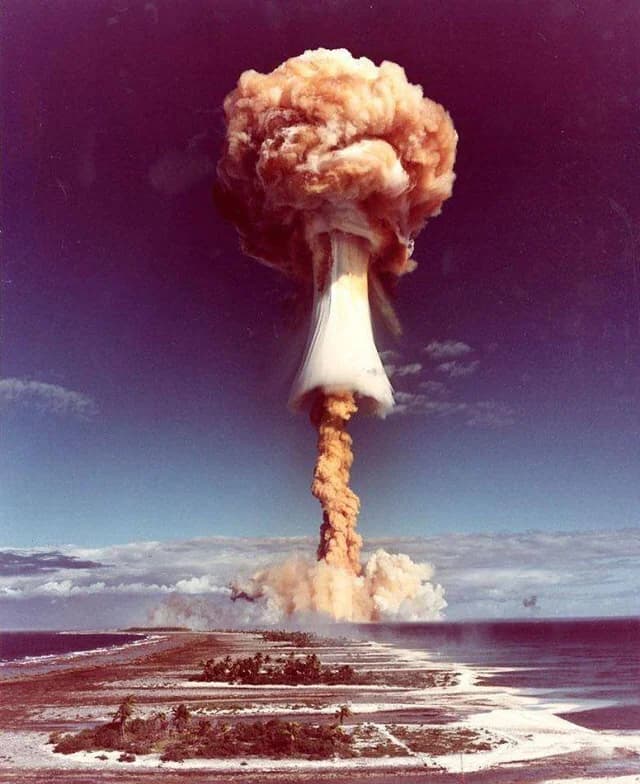
French Parliament urges France to apologise for nuclear tests in the South Pacific
Recently, on 17 June 2025, the French National Assembly called on the French government to apologise for the nuclear tests that it carried out in Tahiti Nui for three decades to 1996 and to amend and widen the compensation law for residents there suffering health damage (French parliament: Government should apologize for nuclear tests in Polynesia, NHK World, 19 June 2025).
For decades, residents of Tahiti Nui and military personnel involved in the tests have been demanding that the French government provide adequate compensation for the health problems they developed, including cancers and the deaths of children.
The National Assembly set up a cross-party committee in 2024 to conduct an inquiry into how much radiation people were exposed to there and whether they should be compensated.
The report found that the French government and the nuclear testing authorities at Moruroa, which carried out the tests, were accountable for the outcome.
It also said that residents and military personnel were not properly informed of the risks from the tests and radiation protection measures to mitigate the health consequences were not implemented, or only in limited ways.
It also found limitations in the current French compensation law, which only compensates people who were exposed to a certain threshold of radiation and who have developed radiation-induced cancers and other diseases.
So, it also recommended expanding the list of 23 diseases eligible for compensation and the scrapping of the millisievert threshold requirement for compensation.
It also called on the state to add an apology for carrying out the nuclear tests into a law on the status of French Polynesia.
The report also said that tens of thousands of people in French Polynesia are estimated to have been exposed to harmful levels of radiation from the tests (Parliamentary report urges Paris to apologise for French Polynesia nuclear tests, France 24, 17 June 2025).
Only a few dozen civilians have been compensated for radiation exposure since the tests ended there in 1996.
The 40th anniversary of the French bombing of the Rainbow Warrior
After its May-June tour of the Marshall Islands, SV Rainbow Warrior III sailed to Aotearoa to commemorate the 40th anniversary of French government agents bombing the original Rainbow Warrior on 10 July 1985 in downtown Auckland.
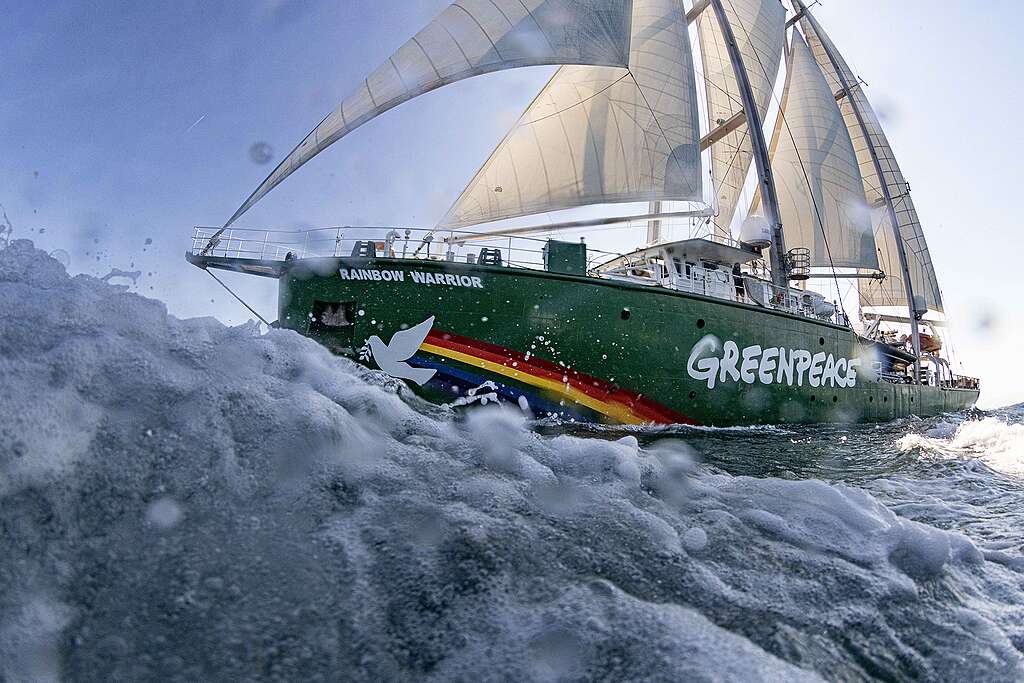
Further reading
The Devastating Consequences of Nuclear Testing – Effects of Nuclear Weapons Testing on Health and the Environment, 2023, Dr Arjun Makhijani & Dr Tilman Ruff, International Campaign to Abolish Nuclear Weapons and International Physicians for the Prevention of Nuclear War Germany.
Toxique: The Aftermath of French Nuclear Testing in the South Pacific, Sebastien Philippe and Tomas Statius, 2021. Many of the documents, interviews and computer simulations this book is based on can be viewed online in French and English here: https://moruroa-files.org/
Chronology: The French Presence in the South Pacific 1838–1990, Julie Miles and Elaine Shaw, 1990, Greenpeace.
Testimonies: Witnesses of French nuclear testing in the South Pacific, Andy Biedermann and Stephanie Mills, 1990, Greenpeace:
Exodus: An introduction to environmental issues in the Pacific, Pacific Conference of Churches and Greenpeace, 1995.
Making Waves: The Greenpeace New Zealand Story (1971-1990), Michael Szabo, Reed Books, 1991.
Making Waves II: A history of Greenpeace Aotearoa New Zealand from 1990 to 2020, Michael Szabo, 2021, Greenpeace Educational Trust.
Poisoned Reign: French Nuclear Colonialism in the Pacific, Bengt and Marie-Thérèse Danielsson, Penguin Books, 1986.
Eyes of Fire: The Last Voyage and Legacy of the Rainbow Warrior, David Robie, Little Island Press, 2025.
Fri Alert, 1974, Elsa Caron (editor).
Day of Two Suns: US nuclear testing and the Pacific Islanders, Jane Dibblin, Virago, 1988.
Greenpeace III – Journey into the bomb, Robert Hunter and David McTaggart, Collins, 1978.
The Greenpeace Chronicle, Robert Hunter, Picador, 1979.
Protest at Moruroa: First-hand accounts from the New Zealand-based flotilla, Claudia Pond-Eyley, 1997, Tandem Press.
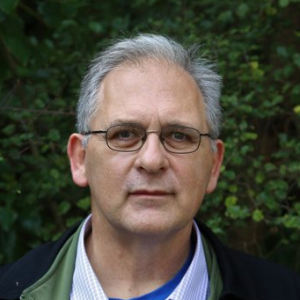
Michael Szabo
Michael Szabo is a former Greenpeace Aotearoa Campaigns Manager and the author of ‘Making Waves’ I & II, a history of Greenpeace in Aotearoa (1971-1990; 1991-2021). His new book, Wild Wellington Ngā Taonga Taiao, will be published in November 2024.
